It seems we can’t find what you’re looking for. Perhaps searching can help.
Sign Up for newsletter!
Subscribe to get the latest eBook!
Hotline






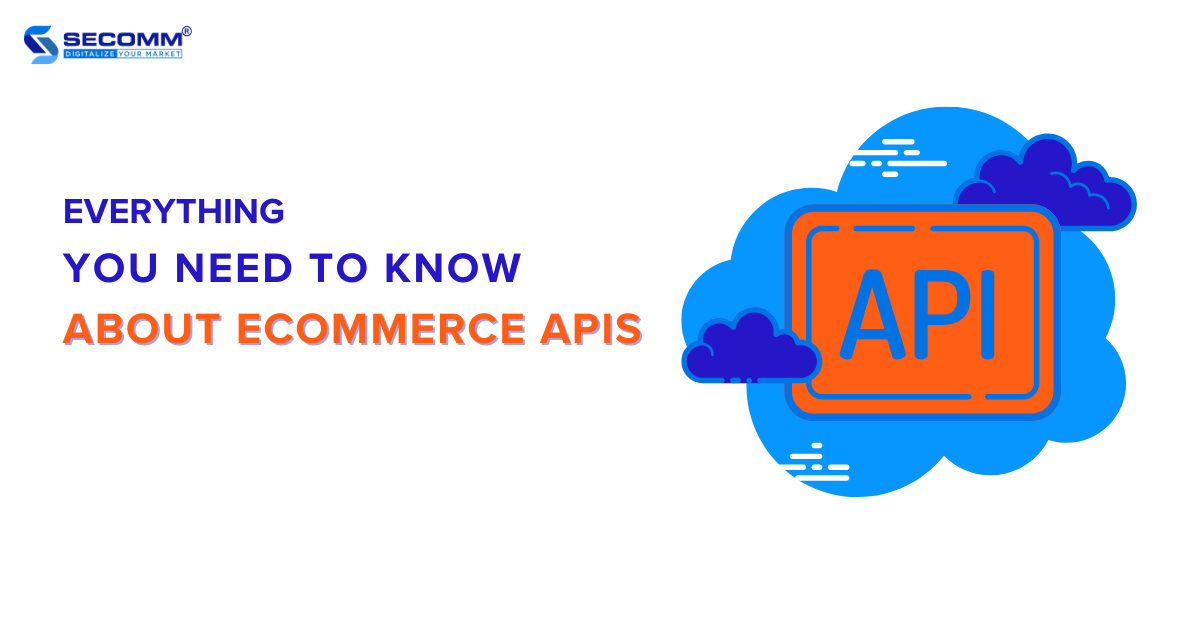
Businesses going headless aim to integrate with third-party applications or services to extend capabilities, boost performance, and enhance the flexibility of their eCommerce systems. Therefore, they have to understand eCommerce APIs or application programming interfaces.
This article will provide a brief overview of what eCommerce APIs are, how they work, the types, and roles for going headless, and the advantages gained through their integration.
Learn more: What is Headless Commerce?
eCommerce APIs are application programming interfaces (APIs) that enable external applications and systems to access and interact with the functionalities and data of an eCommerce platform.
For example, an eCommerce API allows businesses to access product information, place orders, handle payments, manage inventory, or integrate with third-party services such as shipping, analytics, email marketing, and delivery.
They operate based on a request-and-response model. When an application or system intends to access or perform a function on the eCommerce system, it sends a request to the API through an HTTP method such as GET, POST, PUT, or DELETE.
This request contains information like the URL address of the API and necessary data. Then, eCommerce APIs process the request and respond to the application or system that initiated the preceding request. This response includes an HTTP code indicating the outcome of the request (success or failure) and may contain data in formats like JSON, XML, etc.
APIs in the field of eCommerce are often published in the form of documentation known as “API documentation”. This documentation contains detailed instructions on how to establish connections and share data through the API. This helps businesses and developers understand how to use each type of API effectively.
There are various types of eCommerce APIs depending on their functions and specific use cases. Some common include:
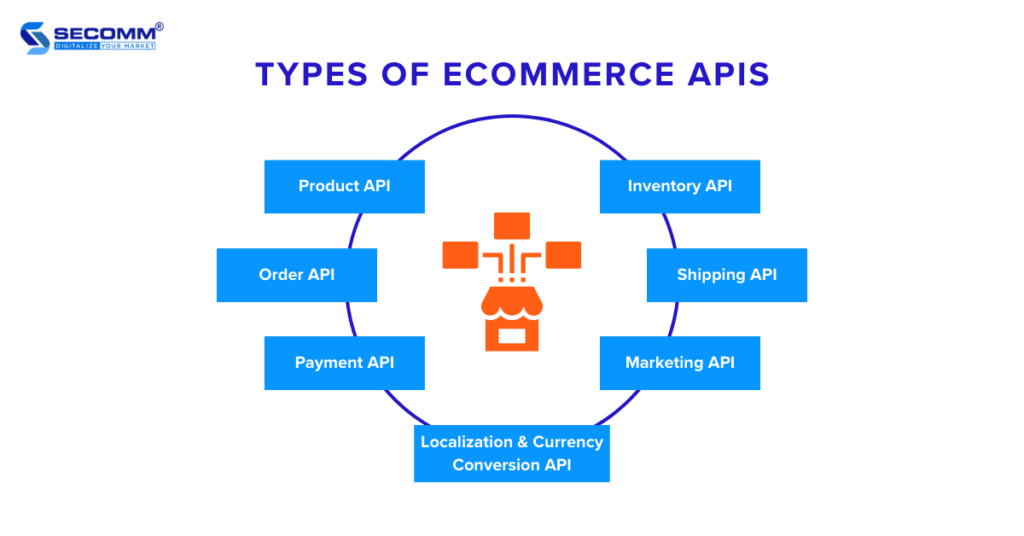
Headless is an eCommerce model that allows the separation of the user interface (frontend) and the management system (backend) of an eCommerce website. is also referred to as the “API-first” approach because the frontend and backend communicate with each other through an API layer.
Therefore, eCommerce APIs play a crucial role in connecting the frontend and backend. For instance, when a customer accesses a business’s eCommerce website and places an order, the website’s frontend can use eCommerce APIs to send requests to the backend to check product availability, calculate the order value, and create the order.
The backend can then process these requests and provide the necessary information to display to the customer.
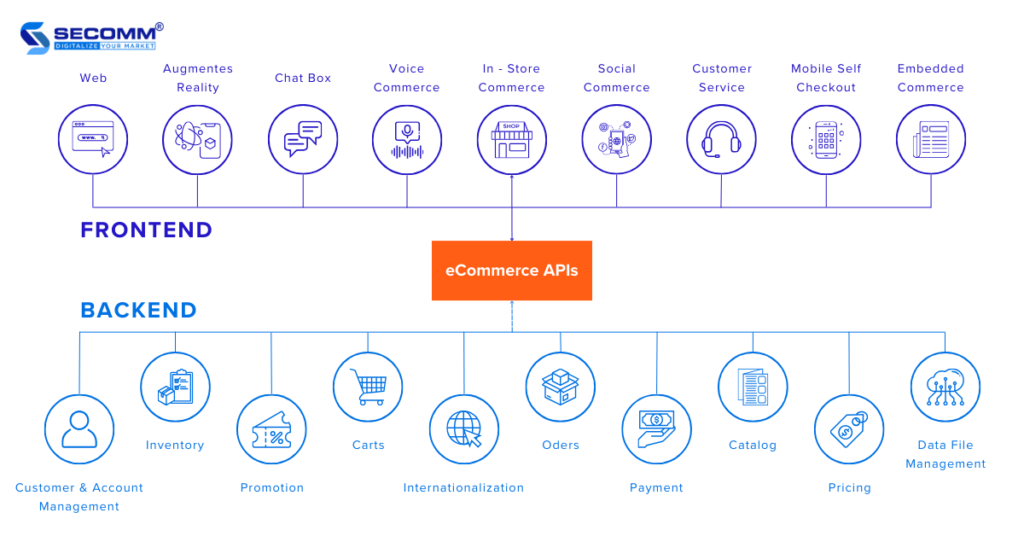
eCommerce APIs allow the frontend to access and interact with the functions and data of the backend. They also enable the backend to integrate with third-party services and systems such as CMS, CRM, ERP, and DXP. Additionally, eCommerce APIs help businesses create various user interfaces for diverse sales channels and devices, including websites, mobile apps, voice commerce, wearables, AR/VR.
These eCommerce APIs empower businesses to go headless flexibly, providing not only a multi-channel shopping experience but also facilitating rapid and efficient expansion and development in the international market.
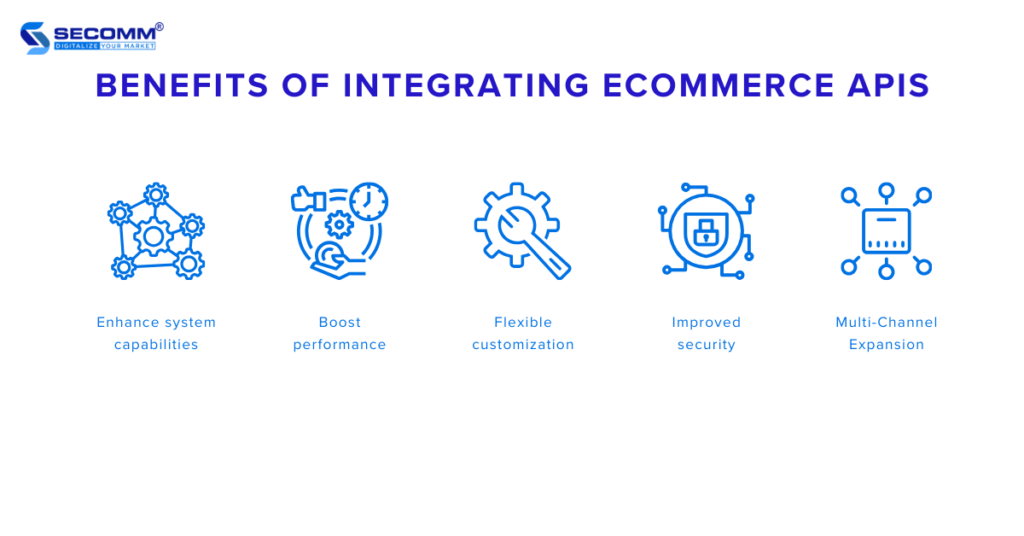
Businesses can add new functions and features to their eCommerce websites by using available APIs or creating their own APIs. This allows businesses to easily expand the capabilities of their eCommerce systems, providing customers with an enhanced shopping experience.
Businesses can optimize the performance of their eCommerce websites by leveraging eCommerce APIs to automate business processes, minimizing potential errors. For example, a business can use APIs to synchronize data across different systems for more efficient management and operations.
Businesses have the freedom to customize their eCommerce websites according to their needs and preferences by integrating APIs to connect with third-party applications and systems. For example, businesses can use APIs to create a unique user experience, incorporating new technologies such as AI, AR/VR, and blockchain.
Third-party applications and systems, especially payment systems, often include strict security protocols. Therefore, integrating them into a business’s website through APIs enhances the security of the site. This helps safeguard business data, customer information, and payment details from the risk of theft.
APIs enable businesses to integrate with various user interfaces, allowing them to expand their business operations across multiple sales channels, including websites, mobile apps, and even social media.
The Bottom Line
Here is what you need to know about eCommerce APIs – application programming interfaces that enable various applications and systems to interact with each other efficiently within the eCommerce system. In other words, eCommerce APIs act as a bridge between the frontend and backend in the Headless model, allowing businesses to customize operations flexibly and provide customers with a unique and seamless shopping experience.
Contact SECOMM or call the hotline at 028 7108 9908 to learn more about integrating eCommerce APIs and going headless. We have a team of experienced and specialized experts to turn your business ideas into reality and accompany businesses on their eCommerce journey.
 2
2
 5,076
5,076
 0
0
 1
1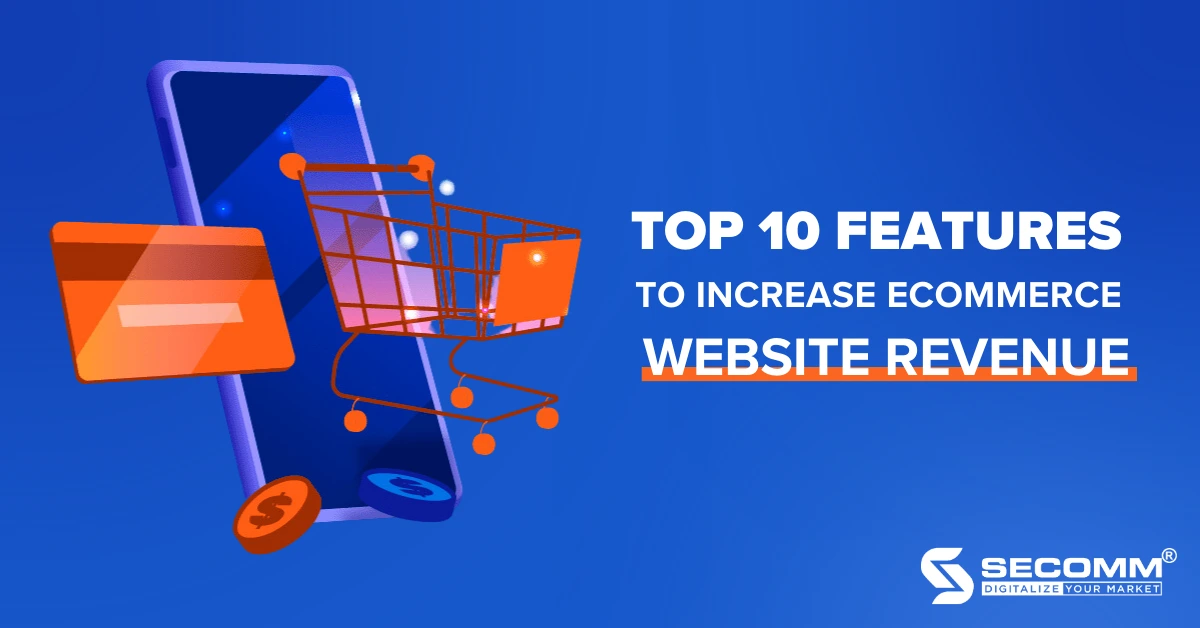
eCommerce has become an essential trend for successful business in the Vietnamese market. According to a report from Facebook’s SYNC Southeast Asia and consulting firm Bain & Company, Vietnam is expected to be the fastest-growing eCommerce market in Southeast Asia by 2026, with a total eCommerce goods value reaching $56 billion, 4.5 times that of 2021, ranking second in the region.
To harness the advantages of this thriving market, businesses need an eCommerce website system with a full range of functionalities, from basic to advanced. Therefore, planning a step-by-step construction of the functional system is crucial to avoid situations where there are ‘missing essentials’ or ‘unnecessary features’ for the business.
Here are some specialized functionalities that any eCommerce website system for businesses in this lucrative market should have!
Images and videos play a crucial role in allowing customers to evaluate the quality of products, especially high-involvement items like jewellery, watches, gemstones, etc.
Additionally, businesses can incorporate features such as 360-degree views, Augmented Reality (AR), or Virtual Reality (VR) to help customers get a comprehensive and realistic view of the product’s quality on the eCommerce website.
In today’s era where ‘good wood comes with good paint,’ investing in high-quality images or videos enhances the impression of a business’s products in the eyes of consumers and demonstrates the professionalism of the brand. Consequently, businesses can keep customers engaged on the website for longer periods, reduce bounce rates, and boost online sales.

One of the essential features of modern eCommerce systems is the ability to filter and search for products effectively, such as live search or ElasticSearch in Magento.
This feature plays a role in directing customers to the detailed product information they are looking to purchase, enhancing the overall customer experience and shortening the shopping journey.
As a result, businesses can improve customer satisfaction and streamline the purchasing process.

Sometimes, customers may be interested in a particular product but decide to purchase it later, or they might find an intriguing product and want to check detailed information before making a buying decision. In such cases, a wishlist allows customers to store these products for easy retrieval when they are ready to make a purchase decision.

Although promotional programs are not unfamiliar to consumers in the eCommerce market, this feature has never gone out of fashion for businesses. According to Google, up to 75% of customers view advertisements before making a purchase, and 84% of customers use information from ads to research product details.

Frequently displaying promotional programs/deals such as flash sales, D-Day promotions, festive season offers, etc., will stimulate customers’ ‘sale hunting’ desires, increase website traffic significantly, and boost sales for businesses.
After leveraging and analyzing the collected data from customers, an advanced eCommerce website system can provide suggestions for similar or related products, aiming to increase the quantity and value of orders. This, in turn, contributes to the growth of online sales revenue for the business.

Up-selling is a technique aimed at selling a more expensive version of a product that a customer already has or intends to purchase by adding new features or accessories to that product. Meanwhile, Cross-selling is a technique aimed at selling complementary products, items that may be related to the product a customer has purchased or intends to buy.
In addition to suggestions for similar and related products on the homepage, product category page, product detail page, and search results page, Up-selling and Cross-selling are also designed to appear on the checkout page to encourage customers to spend more.
The quick order placement feature is an essential function for an eCommerce website. To expedite the shopping process, it’s not enough to have a step-by-step ordering process. Businesses need to design a ‘quick order’ function that allows customers to add products to the checkout page immediately. This will be a significant advantage for businesses to expedite the customer’s ‘order confirmation’ process, thereby generating a surge in online sales.

Typically, the default checkout process on an eCommerce website is a step-by-step procedure, meaning that each step is completed automatically only after the customer finishes the previous one until the entire process is completed.
According to a report from Adobe, 88% of customers abandon their purchases simply because the checkout process takes too much time and is complicated. To streamline this cumbersome payment process, the One Step Checkout feature has been introduced. This feature provides essential information to customers in just one step, facilitating faster transactions and creating a smoother payment process.

Diverse payment methods, including card payments (local cards, VISA, Mastercard), e-wallets (MOMO, Zalopay), payment gateways (OnePay, VNPay, PayPal, Stripe), and Cash on Delivery (COD), will enhance the shopping experience for customers. Additionally, businesses should stay updated on emerging payment trends in the eCommerce market, such as creating their digital wallets, implementing Buy Now – Pay Later options, etc., to build a Loyalty Program and provide more payment choices for customers.

However, to diversify payment methods, businesses should choose open-source eCommerce platforms such as Magento, WooCommerce, and OpenCart to have high integration capabilities and ensure compatibility between payment software and the company’s website.
According to a report from Customer Gauge, 92% of customers will read product reviews from other users before making a purchasing decision. Therefore, the product review feature is always prioritized by businesses to be included in the functionality system from the beginning to enhance the brand’s credibility.
A website with many positive comments from previous users will attract attention and trust from potential new customers, laying the foundation for revenue growth for the business. In addition, negative reviews will help businesses identify the weaknesses of the product, thereby motivating them to improve product quality and services for the future.

In addition to a visually appealing interface and standard UI/UX, the ability to be compatible across multiple devices such as desktops, smartphones, and tablets is a mandatory feature that must be present on the interface of an eCommerce website. This is not only a factor affecting the Omnichannel experience of customers but also a criterion that influences SEO and rankings from Google.

Furthermore, many other features need to be considered for integration into the functional system of the eCommerce website of the business. This will depend on the strategy and business model of each enterprise, as well as the eCommerce platform the business is using.
With SaaS platforms, businesses will not have many options for features since these systems are pre-built, making it difficult to modify the source code and potentially causing instability if there are automatic edits or additions/removals of features.
In contrast, with open-source platforms, businesses have the freedom to choose features to build at each stage of brand development, as well as the ability to integrate with third-party utilities more easily than SaaS platforms.
With deep expertise and experience in developing complex eCommerce systems across multiple countries such as Vietnam, Australia, the US, and New Zealand, SECOMM understands the challenges in the process of building and deploying eCommerce functions that businesses are currently facing.
Contact SECOMM now for a free consultation on detailed eCommerce system development solutions!
 2
2
 8,836
8,836
 0
0
 1
1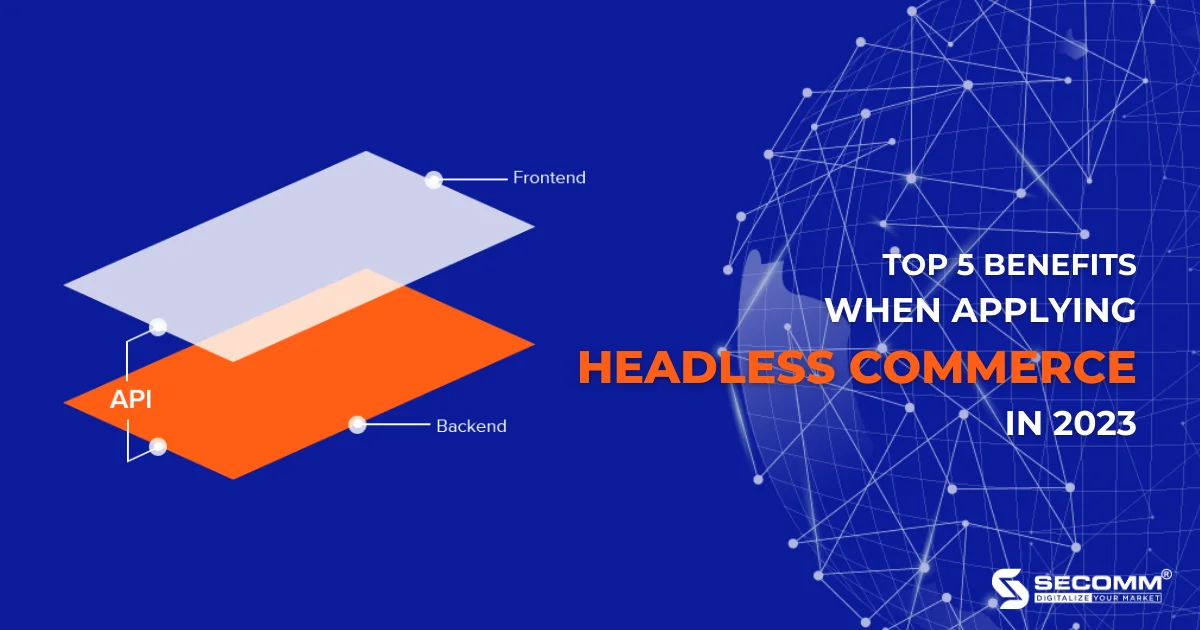
In just a decade, eCommerce has become the epicentre of the online business market, undergoing continuous and robust growth. This is evident in the explosion of mobile commerce (m-commerce), the emergence of social commerce, and shifts in consumer behaviour and expectations.
So, how can businesses adapt to the ceaseless changes in the market? The answer lies in embracing new eCommerce technologies, one of which is Headless Commerce.
Today, businesses have many choices for building an eCommerce website, but fundamentally, the structure of a website includes the following main parts:
In traditional eCommerce models, businesses often use the monolithic model, which was developed over two decades ago. At that time, the monolithic architecture was the only choice for eCommerce businesses because there were no alternatives other than building, continuously updating, and maintaining.
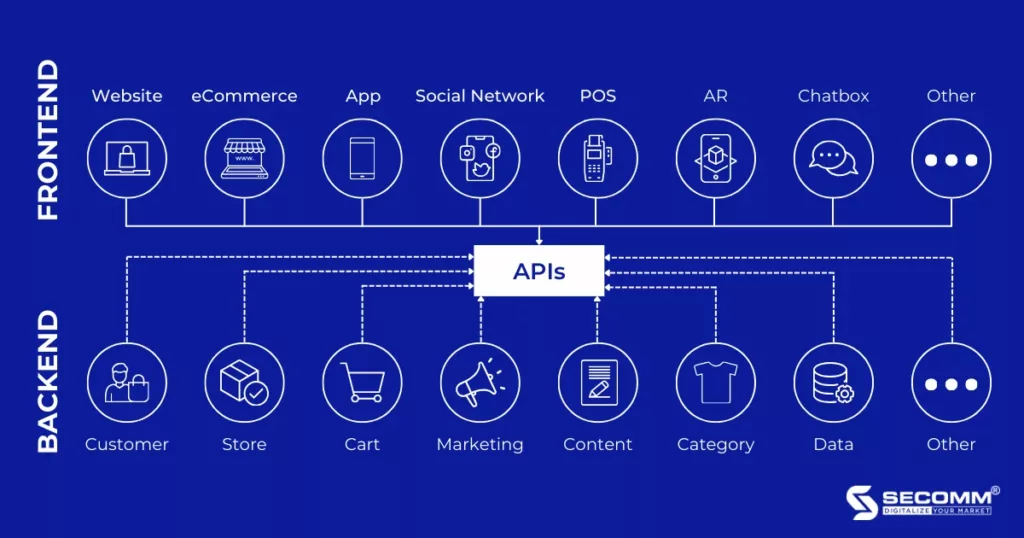
In the Monolithic Model, the frontend and backend are tightly connected, so any changes to the website require improvements in both. Therefore, every frontend change leads to a change in the backend structure and vice versa. Hence, every technology decision becomes riskier, and more complex, directly impacting the entire eCommerce website system.
On the other hand, Headless Commerce is an eCommerce architecture in which the frontend is separated from the backend, and connected through APIs. This allows businesses to easily customize and update functionality without interfering with the user interface or CMS pages.
For that reason, Headless Commerce has many competitive advantages compared to Monolithic Model:
| Headless Commerce | Monolithic Model |
| Separate frontend and backend but still “connect” seamlessly with API | Connect frontend and backend using common protocols (HTML, CSS, etc) |
| Enhance page loading speed | Page load times are slower due to multiple API calls from the platform in use |
| Flexible develop the frontend without needing to update or impact the backend | The backend is susceptible to frontend customization (especially unique designs) |
| Increase integration with third-party services/utilities | Although it is easy to integrate with services/utilities from third parties, it often leads to code bloat (too much source code) slowing down the website system |
| Adapting quickly to new channels enhances seamless customer experiences | Most are difficult to adapt to new sales channels |
Comparison table between Headless Commerce and Monolithic Model
According to Forbes, more than $1.65 billion in funding has been raised for Headless Commerce technologies during the 2020-2021 period.
Several platforms support Headless Commerce technology, including Magento Commerce (or Adobe Commerce), Shopify Plus, BigCommerce Enterprise, SAP, etc.
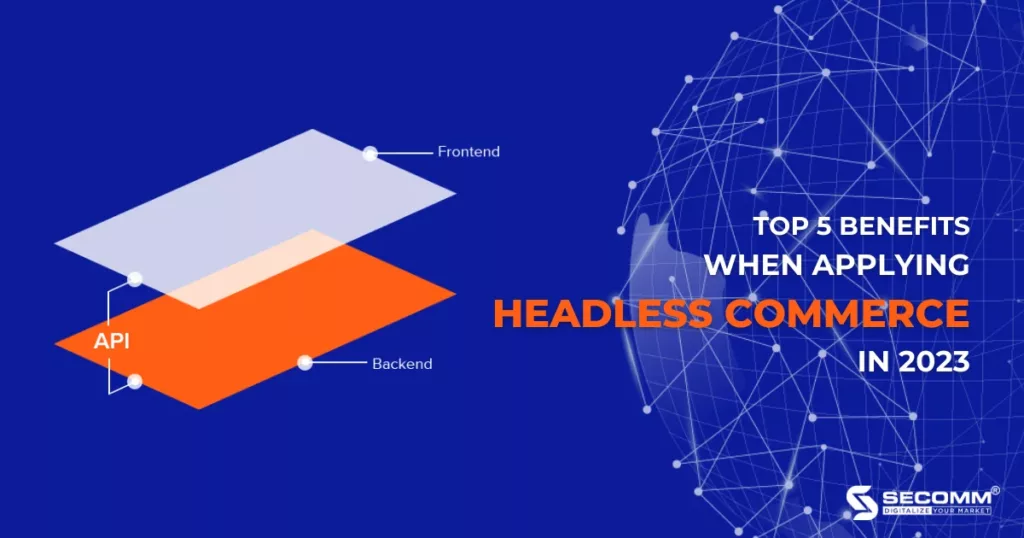
In Headless Commerce application platforms, separating frontend and backend into distinct components allows businesses to achieve limitless customization for designing an eCommerce system. For example, optimizing eCommerce functionalities and customizing the user interface can be done independently without impacting the overall system’s operation. As a result, businesses can better seize new opportunities in this competitive market.
Another crucial aspect of the Headless Commerce architecture is the connections between the frontend and backend through APIs. Thanks to these API connections, businesses can easily modify existing functionalities and develop new features when expanding the system and business model.
In platforms applying Headless Commerce technology, the frontend and backend are no longer tightly integrated into a unified entity. This separation allows for more independent and centralized data storage through API connections. This approach significantly accelerates the processing of API calls compared to traditional eCommerce platforms.
This enhancement reduces the amount of user data to be received and downloaded, thereby improving page loading speed. Given that page loading speed is a component of SEO (Search Engine Optimization), improving this aspect helps boost the website’s ranking on search engines such as Google, Safari, Cốc Cốc, and others.
Another notable advantage of API connections is the seamless integration they offer for eCommerce systems. This is particularly evident in the integration with various third-party services and utilities, such as CRM, ERP, PIM, BI, or other pre-integrated tools. Additionally, this architecture enables businesses to rapidly test services, and utilities, and measure their suitability for eCommerce campaigns.
This flexibility in integration allows businesses to adapt their technology stack to evolving needs and take advantage of the latest tools and services in the market, fostering innovation and efficiency.
In the Headless Commerce structure, API connections facilitate seamless integration with various sales channels, including eCommerce platforms, websites, mobile apps, social media, or any future channels with available APIs.
Simultaneously, Headless CMS (Headless Content Management System) aids in optimizing content across devices such as desktop, tablet, and mobile, connected through the Internet of Things (IoT), to provide a seamless shopping experience for customers. This approach ensures that content is consistently delivered and tailored for diverse devices, enhancing the overall customer journey.
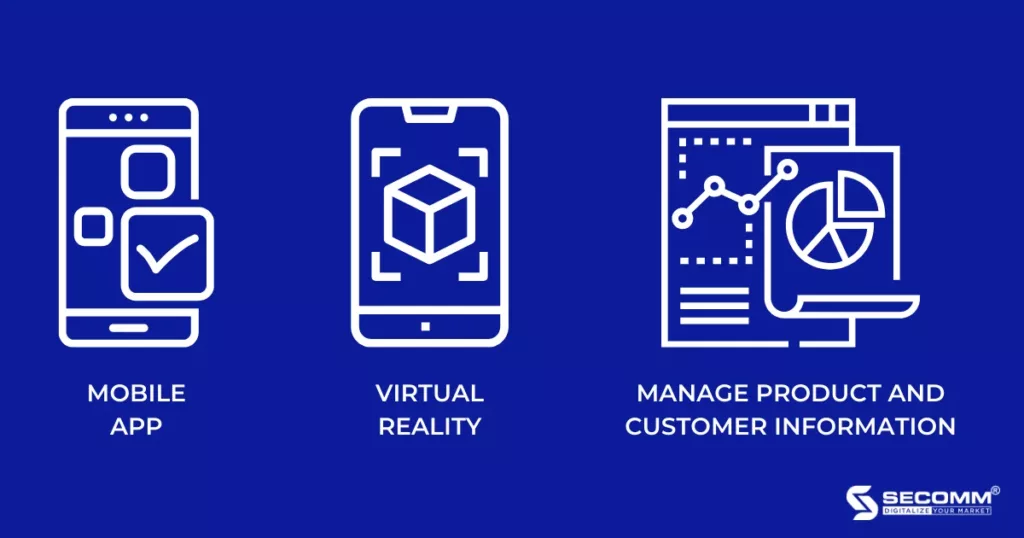
Headless Commerce finds widespread applications in eCommerce implementation. Some common use cases include:
Allows administrators to manage products, marketing campaigns, and inventory through the eCommerce website’s backend system.
Changes in the backend system do not impact the frontend user interface, and APIs can be controlled to display information on the user’s mobile app frontend.
Utilized by eCommerce businesses to implement AR technology.
Users can view dynamic simulated images of products through augmented reality devices, acting as a frontend linked to the backend through APIs in a Headless Commerce application.
PIM (Product Information Management) and CRM (Customer Relationship Management) function as back-office software for processing product information and customer data in the backend system.
In a Headless Commerce structure, backend data can be controlled and displayed on various frontend interfaces through API links, such as eCommerce platforms, websites, mobile apps, and social media.
Enables businesses to deploy eCommerce concurrently with Headless Commerce, offering various advantages.
The decision to adopt Headless Commerce depends on the long-term eCommerce business strategies of a company.
In summary, the implementation of Headless Commerce alongside eCommerce is becoming a realistic option for businesses with long-term market strategies, thanks to the numerous benefits it offers. Whether or not to adopt Headless Commerce and when depends on various eCommerce business strategies.
With over 8 years of experience designing complex eCommerce systems for companies like An Nam Gourmet, Laybyland, Jasnor, etc., SECOMM understands the challenges that businesses face when exploring new eCommerce technologies.
Contact SECOMM now for a free consultation on detailed eCommerce system development solutions!
 2
2
 10,435
10,435
 0
0
 1
1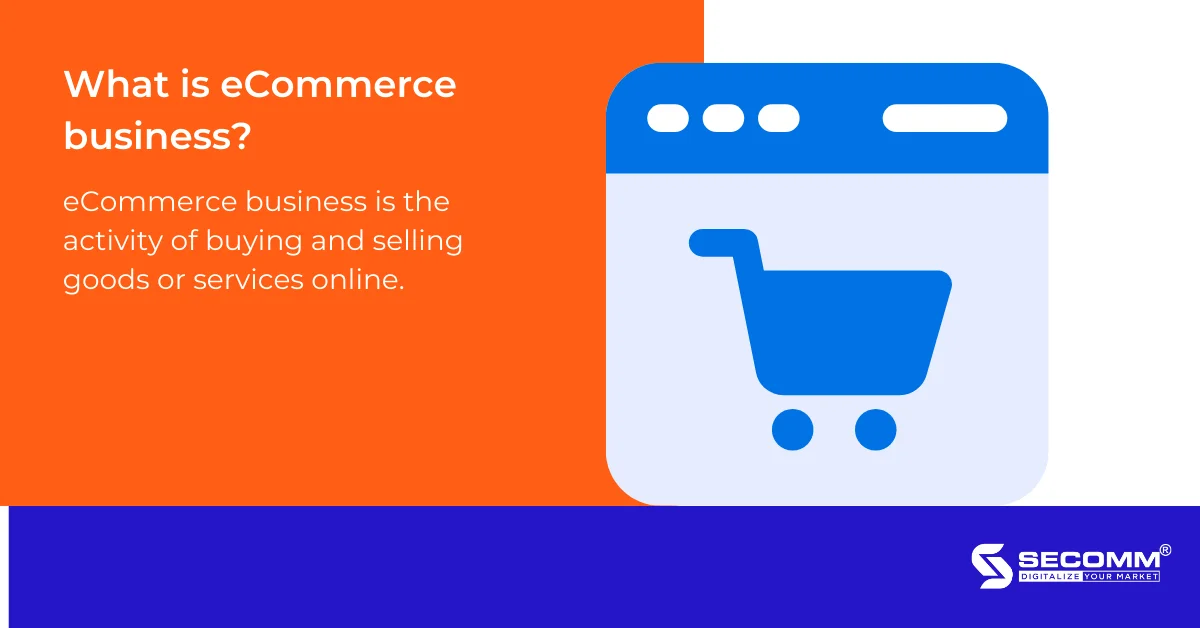
For businesses that are just entering the market, the term “eCommerce” is often recognized through eCommerce marketplaces. Most managers are often unsure of where to start, including which systems to use, which eCommerce platform to choose for development, and what steps to take next.
Therefore, in this article, SECOMM will share comprehensive information from basics to advanced levels to kickstart eCommerce business in Vietnam.
According to Decree No. 52/2013/ND-CP on eCommerce: “eCommerce activities involve conducting all or part of the commercial process through electronic means connected to the Internet, mobile telecommunications networks, or other open networks.”
In simpler terms, eCommerce business is the activity of buying and selling goods or services online.
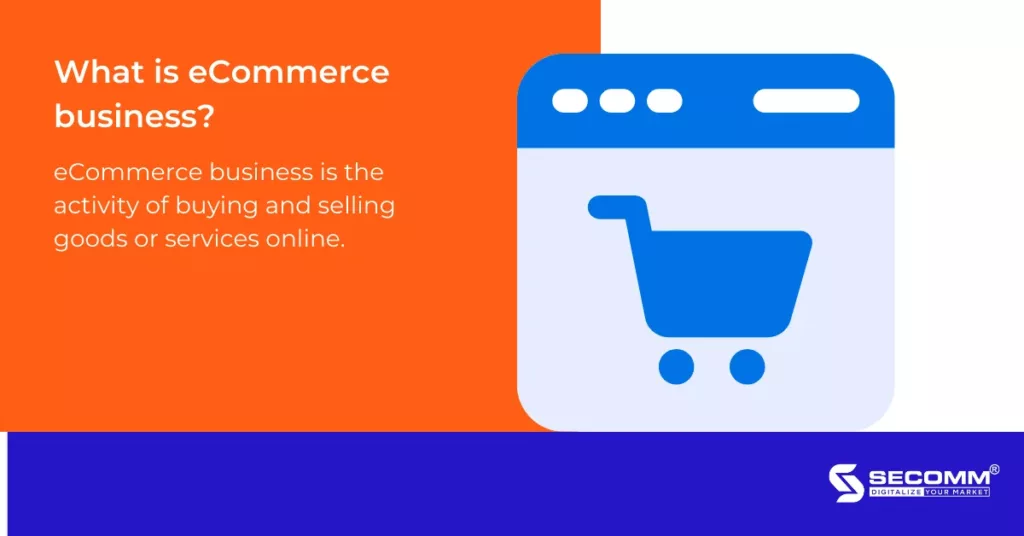
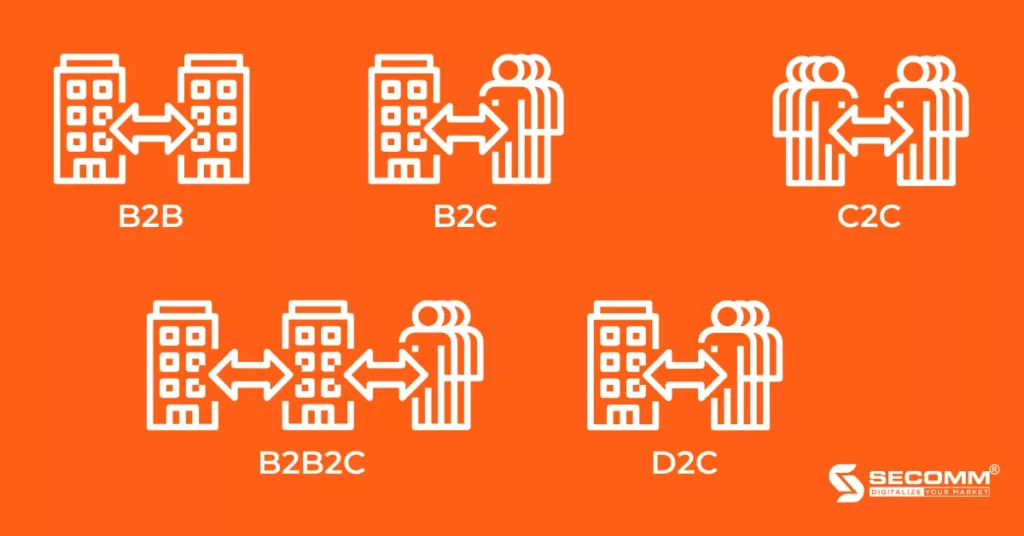
B2C (Business to Customer) involves transactions between businesses and customers. This is also the most common model in the Vietnamese market.
Example: Thế Giới Di Động is the number one retail model in Vietnam’s eCommerce market for devices such as phones, laptops, tablets, and accessories.

B2B (Business to Business) involves commercial transactions between two businesses.
Example: TELIO is Vietnam’s first B2B eCommerce platform, facilitating the connection between small-scale traditional retailers and brands by aggregating demand, providing more choices, better prices, and more efficient logistics support.

B2B2C (Business to Business to Customer) is a business model that involves collaboration between two businesses (B2B) to create and deliver products or services to end consumers (B2C).
Example: Shopee is the most popular eCommerce platform in Vietnam. Shopee Vietnam initially operated under a C2C model, serving as an intermediary in the buying and selling process between individuals. However, Shopee Vietnam has evolved into a B2B2C hybrid model by offering various services and conveniences to support the shopping process for both businesses and consumers.
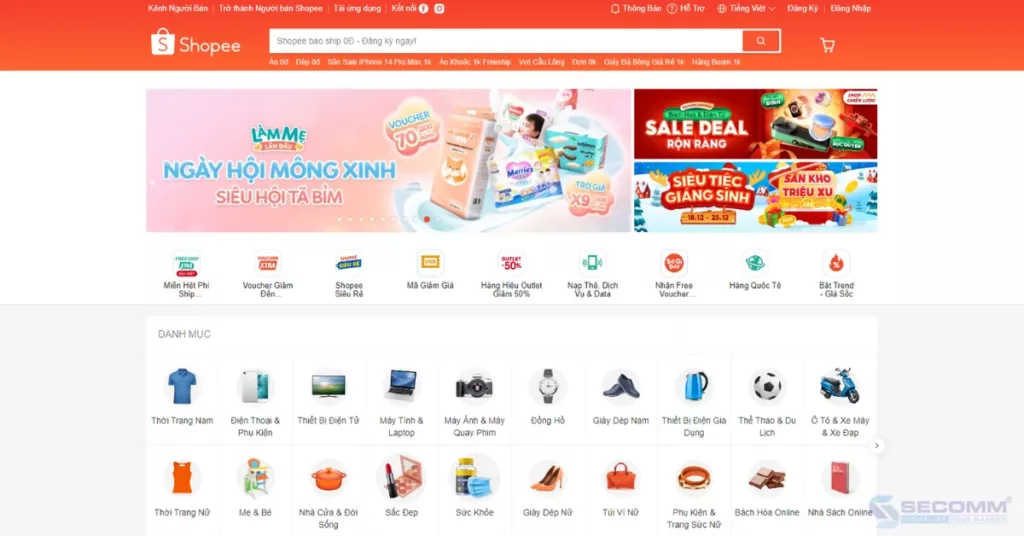
C2C (Consumer to Consumer) is a form of business where transactions occur directly between two individuals rather than involving businesses.
Example: Chợ Tốt is an eCommerce website that facilitates transactions between individual sellers and buyers for items such as real estate, cars, job postings, used electronics, pets, and various home services.

D2C (Direct to Customer) is a business model that delivers products directly from the business to the customer, bypassing intermediary distribution channels.
Example: Coolmate is a men’s fashion startup established in 2019. Within just 2 years of operation, the brand raised a rapid $500,000 in funding for Sharktank.
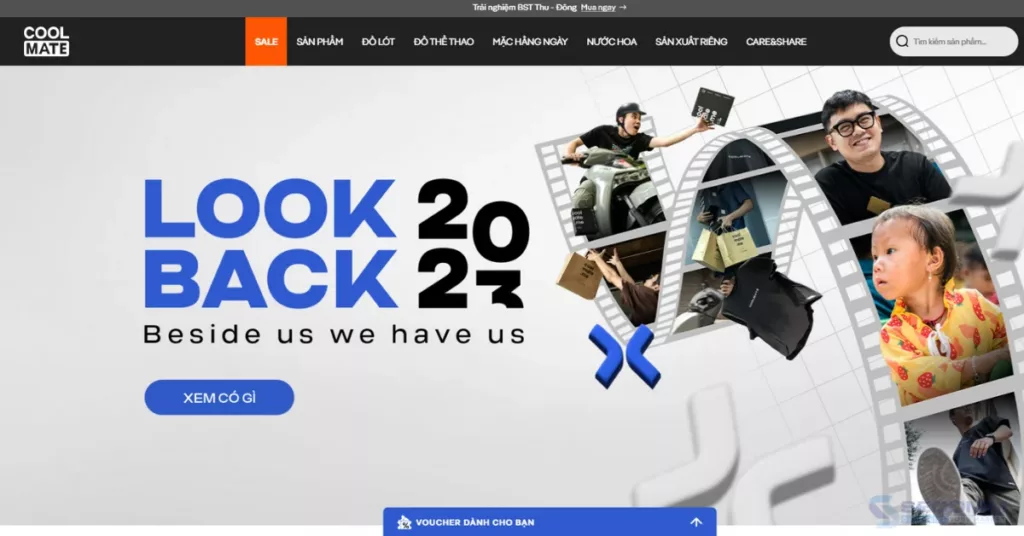
When starting to plan a business, the first step that managers should take is market research to understand the overall market situation, details about competitors, trends, and consumer behaviour. Some free and reputable sources businesses can refer to include the White Paper on eCommerce in Vietnam by IDEA, the e-Conomy SEA report by Google & Temasek, the eCommerce Index report by Vecom, etc.
After conducting market research, the next thing businesses should pay attention to is defining objectives, such as adding sales channels to increase revenue, positioning the brand in the eCommerce market, supporting marketing campaigns, enhancing user experience and interaction, etc.
Following market research and goal setting, businesses should also budget and plan the implementation timeline for each stage of eCommerce operations. Depending on the goals and strategies, each business will set budgets and timelines for the most effective eCommerce operations.
Next, businesses need to choose an eCommerce platform to build a system that aligns with the brand’s scale and strategy. The components of an eCommerce system typically include a website and an eCommerce website application.
There are two main types of platforms nowadays: SaaS (Software as a Service) and Open Source.
For Open Source platforms:
For SaaS platforms:
Once the eCommerce platform is selected, businesses have two options for resources to build the website: building an in-house team or using services from developers.
For building an in-house team, businesses need to recruit and train IT and eCommerce professionals with expertise and experience on the chosen platform. This process may take time and budget to build a suitable team but provides better control over resources, allowing adjustments or developments according to specific requirements.
For collaborating with development firms, businesses should seek developers based on criteria such as deep experience in eCommerce, an experienced team, a clear process, quick handling and support, and commitments to warranty and maintenance. This approach helps businesses gain professional expertise, enhance experience, and develop a suitable website.
In the eCommerce market, there are various payment methods, with Cash on Delivery (COD) being the most common. However, due to the rise of “cashless” payment trends amid the Covid-19 pandemic, electronic payment methods are gaining more prominence.
Some payment methods chosen by eCommerce businesses include:
Usually, a fulfilment process includes the following steps: Importing goods or manufacturing → Shipping to warehouse/distribution centre → Warehousing → Processing goods upon request (Shipping, invoicing, packaging, labelling) → Delivery → Handling post-sale requests (Returns, refunds, exchanges).
Therefore, a comprehensive eCommerce system needs to build or integrate functionalities such as eLogistics, blockchain, QR codes, etc., to automate the shipping process, track orders, and thereby enhance the quality of delivery to end consumers.
A Customer Relationship Management (CRM) system is an essential component in the operation of eCommerce businesses. Building and continuously improving the CRM system, as well as implementing a multi-channel customer care centre, helps expedite the processing of complaints, returns, and refunds. Additionally, a CRM system assists businesses in gaining insights into customer needs, facilitating the establishment of interactions between the brand and its customers.
Maintaining the eCommerce system 24/7, continually updating and upgrading it helps businesses promptly address arising issues, achieve sustainable sales growth, and adapt quickly to the ever-changing market. Simultaneously, continuous monitoring and maintaining eCommerce operations aim to prevent risks from hackers, data breaches, etc.
One of the crucial strategies in current eCommerce operations is omnichannel selling. By following customers’ “footprints” across eCommerce platforms (Shopee, Lazada, Tiki, Sendo), social media (Facebook, TikTok, Instagram, Zalo), websites, and eCommerce apps, this strategy centralizes customer data, reaches diverse shopping behaviours, and optimizes personalized experiences in the eCommerce system. Additionally, various eCommerce marketing campaigns are being developed, such as Affiliate Marketing, Shoppertainment, SEO, Email Marketing, etc. This strategy optimizes brand visibility and boosts online sales.
Building reporting functions to exploit the efficiency of data, including reports on Sales, Marketing, Customers, Inventory, and Operational Performance, to improve and enhance business efficiency. Integrating analytical tools such as Google Analytics, Facebook Pixels, Microsoft Power BI, etc., supports tracking and measuring system performance to provide detailed reports on business results in eCommerce.
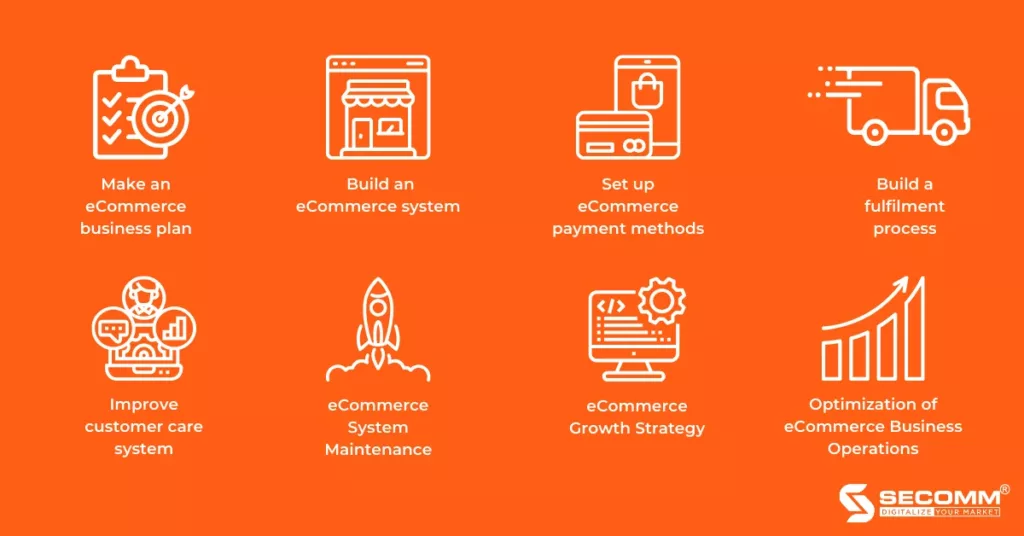
In summary, conducting eCommerce based on the above 8 steps is not an easy task for business managers. To stay competitive in the eCommerce race, various factors come into play, including financial strength, human resources, the general economic situation, changes in consumer behaviour, etc. Therefore, managers need to be cautious when making critical decisions to bring business efficiency.
With over 9 years of experience in designing complex eCommerce systems for companies like Annam Gourmet, Laybyland, and Jasnor, SECOMM understands the challenges businesses face in researching and efficiently implementing eCommerce.
Contact SECOMM now for free consultation on detailed eCommerce system development solutions!
 2
2
 15,087
15,087
 0
0
 1
1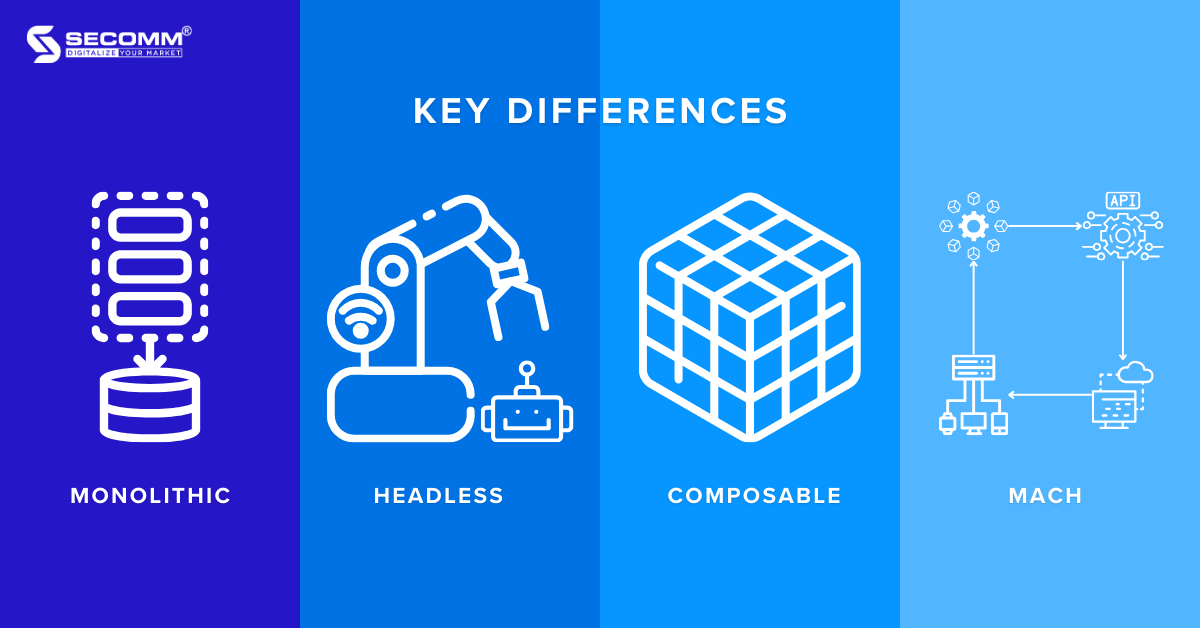
The eCommerce sector is experiencing rapid growth, with global retail sales reaching 5.7 trillion USD in 2022 and projected to hit 6.3 trillion USD in 2023, as reported by Insider Intelligence. This requires businesses to adopt more efficient and flexible eCommerce architectural solutions to meet customer demands for online shopping experiences.
However, there is no one-size-fits-all eCommerce architectural solution. Each architecture comes with its own set of advantages and disadvantages, catering to different goals and requirements. Hence, businesses must discern between eCommerce architectures to choose the most fitting one for their business model.
This article will introduce the four most common eCommerce architectures: Monolithic, Headless, Composable, and MACH. Also, it’ll compare and evaluate these architectures based on criteria such as cost, scalability, customization, security, and performance.
Monolithic architecture is a traditional and long-standing model in eCommerce development. In this approach, the entire eCommerce website is built as a unified application on a single source codebase.
This means that both the user interface (frontend) and business logic (backend) are combined and implemented within a comprehensive “all-in-one” system. So, modifications to specific eCommerce components may have repercussions on the overall functionality of the system.
Pros:
Cons:
The Monolithic architecture can be used in case your business is implementing a small-scale, straightforward eCommerce system, seeking a rapid market launch without immediate plans for significant future development. However, architectures like Headless or Composable would be more appropriate as the system grows and expands, requiring increased customization and scalability
The Headless architecture is a popular architectural solution in eCommerce, where the user interface (frontend) of the eCommerce website is decoupled from the operational system (backend). The Headless architecture is often called “API-first” because the frontend and backend communicate with each other through an API layer.
Many businesses opt for the Headless Commerce model to create and customize user interfaces (frontends) to provide customers with a rich and seamless shopping experience across various channels such as websites, mobile apps, IoT, and POS. These user interfaces can connect to a single backend system through an API layer, enabling businesses to engage in multi-channel commerce and rapidly expand internationally.
Pros:
Cons:
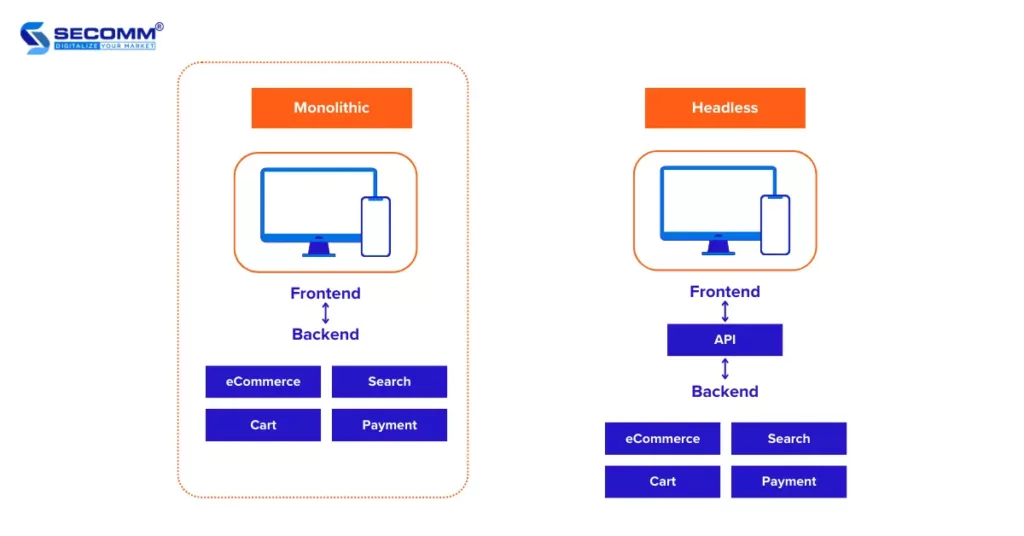
Deploying Headless Commerce may be suitable for businesses that require flexibility to create and customize multiple user interfaces for multi-channel sales purposes and expand their business globally. In particular, businesses that demand independent development of both frontend and backend, as well as the need for integration with various third-party systems, should prioritize the Headless architecture.
If the standout feature of the Headless architecture is the separation of frontend and backend, providing scalability and flexible customization, then the Composable architecture, also known as Module-driven architecture, takes it a step further by decoupling all eCommerce components such as Search, Payment, Cart, etc.
This allows businesses to select components and package them into Packaged Business Capabilities (PBC) to create a specialized and comprehensive eCommerce website solution.
Pros:
Cons:
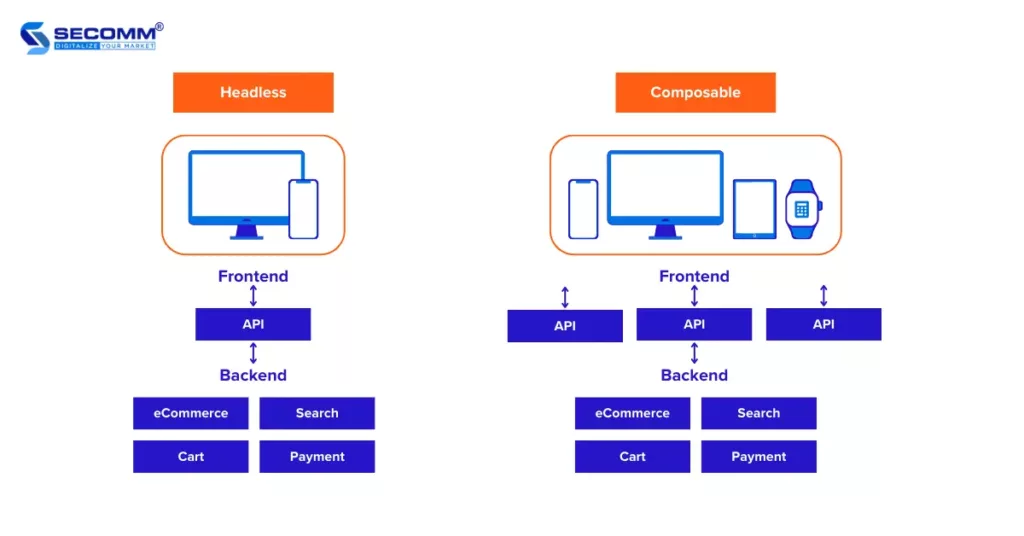
Composable architecture is suitable for cases where businesses undertake large projects, have high demands for flexibility and customization, need to integrate multiple services and third-party systems, as well as require complete independence between the components of the eCommerce system.
The MACH architecture is the most modern approach for building and developing highly flexible eCommerce websites. This architecture allows businesses to integrate leading technologies into a single system, incorporating Microservices-based, API-first, Cloud-native, and Headless components.
Pros:
Cons:
MACH architecture is suitable for businesses with ample budgets aiming to implement large projects based on the four MACH technologies and with high requirements for customization and scalability. It is also beneficial if they have in-house expertise or collaborate with highly specialized development teams.
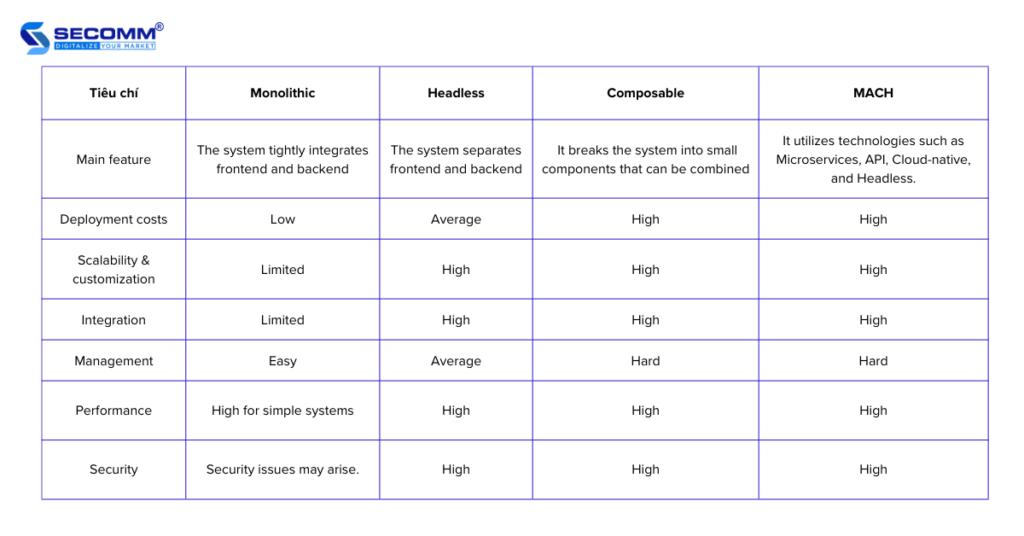
Above is a summary of the essence of the four eCommerce website deployment architectures: Monolithic, Headless, Composable, and MACH. While Monolithic may seem outdated and has many limitations, the Composable and MACH architectures are innovative, providing more optimal and flexible development solutions, but their deployment and operation processes are complex, requiring a highly skilled development team. Therefore, Headless becomes a valuable architectural solution compared to the other three choices for implementing eCommerce websites at the current time.
Headless Commerce is the most popular solution today, with a 25% increase in demand for Headless Commerce deployment in the past two years. Implementing Headless allows businesses to create a customized and multi-channel user experience by integrating with leading tools and technologies. To effectively develop Headless Commerce, businesses need to collaborate with a development team with high skills and expertise, as well as a well-thought-out strategy.
With extensive technical experience and high expertise in the e-commerce field, SECOMM has successfully consulted and implemented Headless Commerce for leading businesses such as Vinamilk, and Suzuverse, based on one of Shopify’s three solutions:
Contact SECOMM or call directly on the hotline (02871089908) to explore how we can support businesses in maximizing the potential of Headless Commerce and enhancing competitiveness in the eCommerce market.
 2
2
 5,438
5,438
 0
0
 1
1
The Juniper Research report titled “Buy Now Pay Later: Regulatory Framework, Competitive Landscape & Market Forecasts 2022-2027” predicts that the global user base for Buy Now Pay Later (BNPL) will exceed 900 million by 2027. In Vietnam, the BNPL payment method is expected to experience an annual growth of 126.4%, reaching 1,123.9 million USD in 2022.
Buy Now Pay Later (BNPL) is a short-term financial arrangement that allows consumers to make immediate purchases and defer the payment to a future date, typically without accruing interest.
In BNPL, the financial technology (Fintech) organization facilitating the service directly pays the purchase amount to the seller on behalf of the customer. The customer then repays this amount gradually to these organizations over a period, often extending from one to several months.
When using BNPL, customers can make payments through bank transfers or have the amount automatically deducted from their debit card, bank account, or credit card. While the specific terms and conditions may vary between companies offering BNPL services, the general operational mechanism is similar to credit card instalment plans. However, BNPL is often considered much simpler, and additionally, it typically does not involve interest charges; instead, late payment fees are calculated as a percentage of the product or service value.
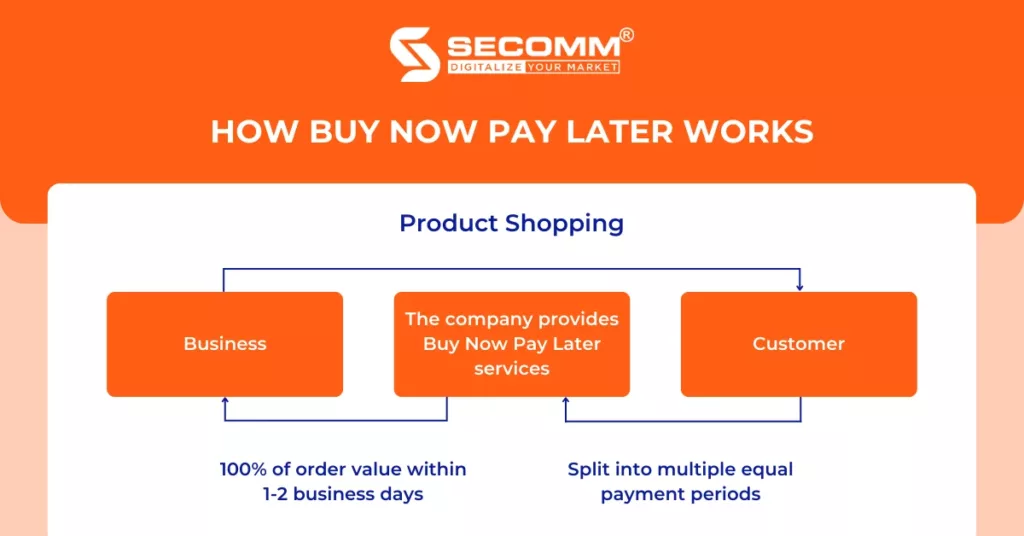
With the BNPL model, consumers can make immediate purchases even if they don’t have the financial capacity to pay the entire shopping cost upfront. This payment is divided into shorter instalment periods, corresponding to smaller amounts, reducing financial pressure on consumers. Additionally, BNPL typically does not entail annual fees or hidden charges, and the registration process is simple and quick, averaging less than 15 minutes. In general, BNPL companies usually only require customers to be at least 18 years old and own a bank card, without specifying a minimum personal income.
However, BNPL often comes with a relatively low consumer spending limit, typically ranging from 20 to 30 million VND, to meet the needs of purchasing items such as fashion, cosmetics, phones, laptops, electronic components, etc. If consumers do not know how to control their spending, they may easily engage in excessive shopping as there is no immediate need to pay the full amount at the time of purchase. This can lead to late payments for the instalment periods and additional penalty fees.
Collaborating with BNPL organizations to launch BNPL programs with 0% interest can help businesses attract more customers without incurring excessive marketing costs. With this approach, businesses can encourage customers to make purchasing decisions more quickly without extensive financial consideration, thereby significantly boosting revenue. Moreover, instead of offering discounts or freebies, the ability to pay gradually without urgency and without incurring interest aligns with customer psychology and needs.
However, many businesses still hesitate to implement BNPL models due to concerns about not being able to control the debt of individual customers. Additionally, this potential model is relatively new to the Vietnamese market, so there are not many payment service providers offering BNPL services, and there is a scarcity of experienced eCommerce website development units capable of efficiently integrating this functionality.
The BNPL model is revolutionizing the global consumer credit sector, but many people still confuse BNPL with credit card instalment plans offered by banks.
So, what are the differences between Buy Now Pay Later and credit cards?
| Format | Buy Now Pay Later | Credit Card |
| Unit accepting payment | The seller allows BNPL payment method | Banks issue credit cards |
| Registration process | Register quickly, completely online | The procedure requires a lot of paperwork |
| Time | 1 to 3 minutes | Have to wait for censorship, which can take up to several days, even weeks |
| Credit limit | Depends on buyer profile | Depends on buyer profile |
| Card maintenance fee | All free | Average 299,000 VND/year |
| Registration fee | All free | Average 50,000 VND/card |
| Conversion fee in instalments | All free | Average 200,000 VND/transaction, or calculated as a percentage of transaction value |
Comparison table of Buy Now Pay Later with Credit Card
Despite trailing behind the global trend, the BNPL model in Vietnam is forecasted to explode due to the market falling into a favourable timeframe. This is influenced by the impact of the Covid-19 pandemic, which has significantly propelled the development of online shopping and eCommerce. Additionally, the BNPL model aligns more with the preferences of Generation Z than traditional credit cards.
Two out of the four largest eCommerce platforms in Vietnam have begun implementing BNPL, affirming the tremendous potential of this model in the online shopping market.
In 2020, Sendo was a pioneer in eCommerce by early adoption of BNPL through collaboration with financial solution provider Atome, offering Buy Now Pay Later services. With BNPL, Sendo aims to make shopping more convenient for customers, removing concerns about financial issues often associated with credit cards, such as increasing interest rates for late payments over an extended period.

Since the beginning of 2022, Tiki has collaborated with two financial service providers, Home Credit and Lotte Finance, to launch the ‘Buy Now Pay Later’ project, enhancing smart payment solutions directly within the Tiki app. This initiative not only supplements intelligent payment options for Tiki users but also empowers customers to manage their personal finances better when engaging in online shopping, thereby further enriching the overall eCommerce experience for consumers.

Laybyland was established in 2012 in Australia with two key eCommerce business models: Layby (Pay Later) and Shop Now Pay Later (Shopzero). Over its 10 years of eCommerce operations in the Australian market, the business has witnessed remarkable growth. Starting with +10,000 products across two initial websites, it has expanded to offer over +400,000 products daily across five online stores, including Laybyland, Shopzero, Mylayby, and Layawayland.
Shopzero, a part of Laybyland, provides BNPL services through seven main partners: Afterpay, Zip, Openpay, Humm, Latitude, Klarna, and Wizpay. Notably, Shopzero maintains complete control and operation over all BNPL activities and payment processes within its system. Pioneering the BNPL market has brought Shopzero significant success, especially in the electronics, office supplies, fashion, cosmetics, furniture, gardening tools, children’s toys, and travel sectors.
It is evident that BNPL is contributing to a significant revolution in consumer payment habits, shifting from a payment method choice to a crucial factor in customer purchasing decisions.
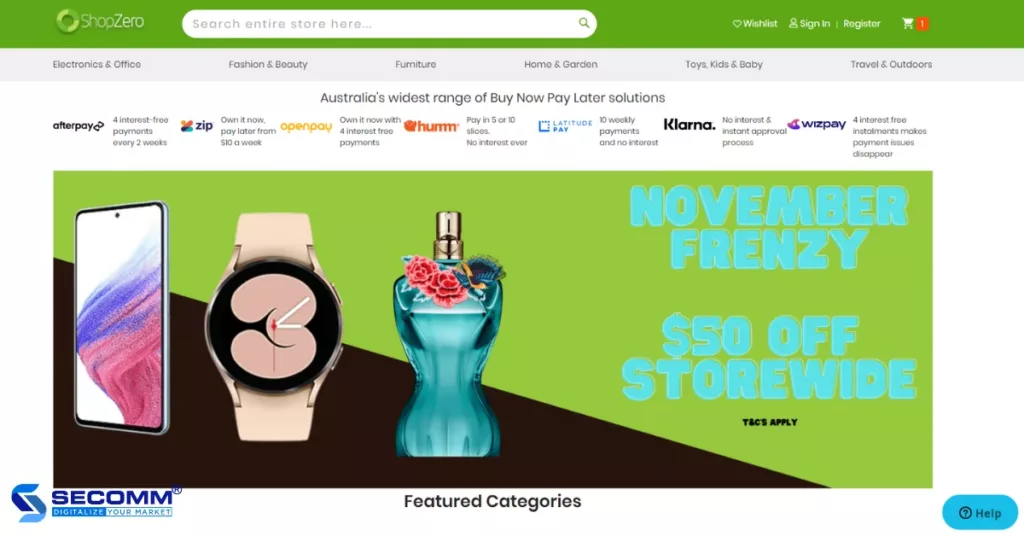
With extensive experience in implementing eCommerce solutions in various countries, especially in the Buy Now Pay Later market, SECOMM understands the challenges businesses face when exploring how to establish Buy Now Pay Later systems.
Contact SECOMM now or call us via hotline (+84)28 7108 9908 for a free consultation on detailed eCommerce system development solutions!
 2
2
 10,661
10,661
 0
0
 1
1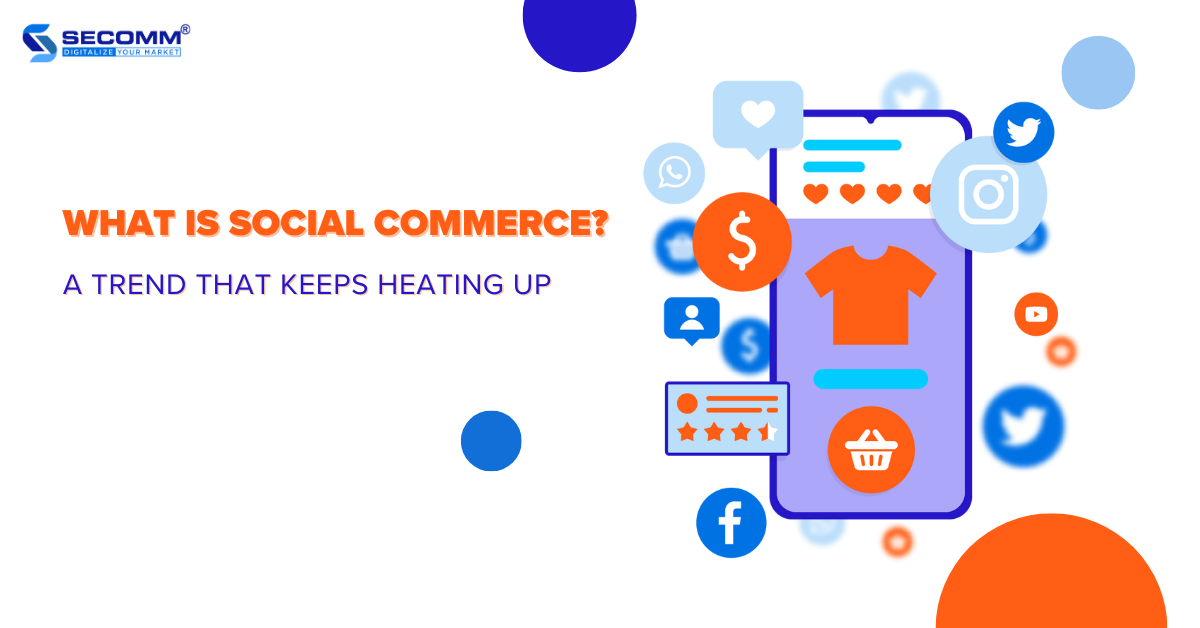
As per Statista’s data, Social Commerce worldwide generated 992 billion USD in revenue in 2022, with projections indicating a potential surge to 2.9 trillion USD by 2026. This positions Social Commerce as a highly valued and potential trend in the future of eCommerce.
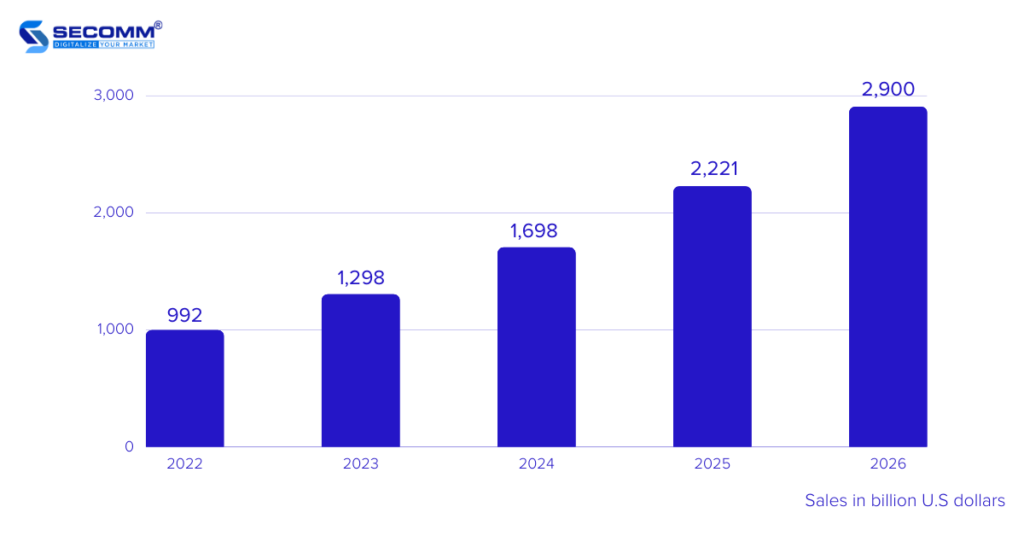
Social Commerce is a term that combines two key concepts: “Social” and “Commerce”.
It represents a business model that seamlessly integrates social media and eCommerce, aiming to create a shopping experience that is more interactive and connected for customers.
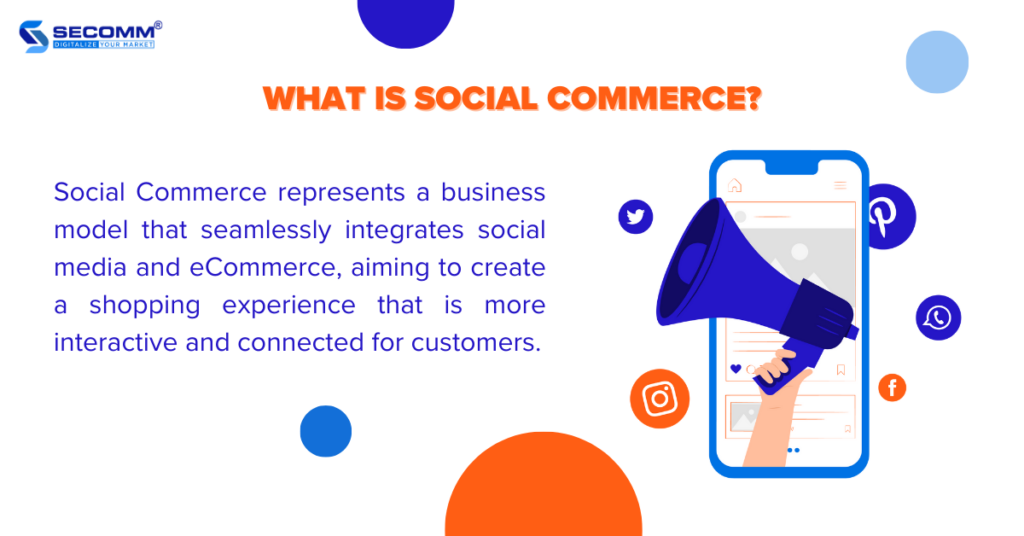
Social Commerce enables users to view and purchase products directly through social media platforms such as Facebook, Instagram, TikTok, etc.
This approach allows customers to delve into product details, read reviews, engage with comments from other users, and even make direct purchases through business posts, advertisements, or social platform storefronts.
The Social Commerce model often comes with interactive features, product-sharing capabilities, and personalized product recommendations.
Social Commerce takes advantage of the widespread popularity and extensive user base on social media platforms to naturally amplify the reach and influence of products and brands.
Social Commerce and eCommerce are two distinct online business models, yet they share the common goal of online commerce. Here are the differences between these two models:
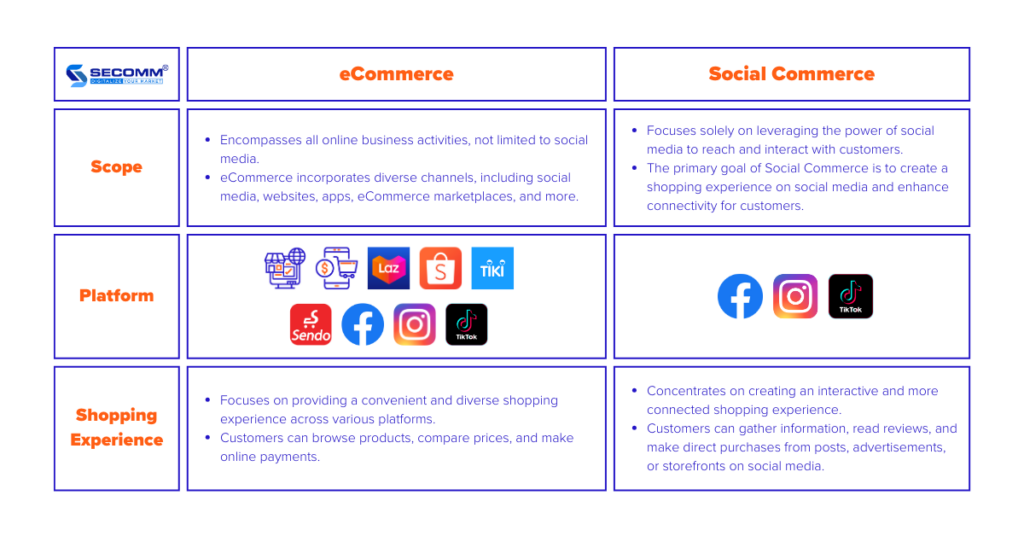
There are various popular types of social commerce, and the choice depends entirely on the scope and objectives of each business. Here are some common types of social commerce:
Social Commerce facilitates businesses in reaching millions of users across various social media platforms, particularly globally popular ones like TikTok, Facebook, Instagram, and Pinterest.
This approach not only boosts brand awareness but also promotes businesses’ products and services to the extensive user base on these platforms, creating organic traction through user sharing and interaction.
The renowned sportswear brand Nike has successfully implemented Social Commerce by leveraging engaging posts, videos, and advertisements on social media platforms such as Facebook, Instagram, and Twitter.
The brand consistently runs advertising campaigns encouraging users to share their product experiences. Through user-generated posts and the strategic use of specific hashtags, Nike has sparked natural virality, resulting in an increased level of brand recognition.

A key feature of social commerce is its focus on creating a seamless online shopping experience for users, simplifying the transition from product browsing to actual purchases. Customers can buy directly from posts, advertisements, or online stores on social media platforms.
This not only streamlines the shopping process but also enables businesses to optimize customer experiences, save time, and boost the eCommerce sales volume for the brands.
The cosmetics brand L’Oréal has created various TikTok channels for each target market in its beauty chain, such as lorealparis (global), lorealparisusa (U.S. market), lorealparis_vn (Vietnamese market), lorealparisid_shop (Indonesian market), lorealparisth_store (Thai market), and so on.
This approach not only allows the brand to reach the right target audience but also takes advantage of TikTok Shop, enabling customers to purchase products directly through L’Oréal’s TikTok channel.
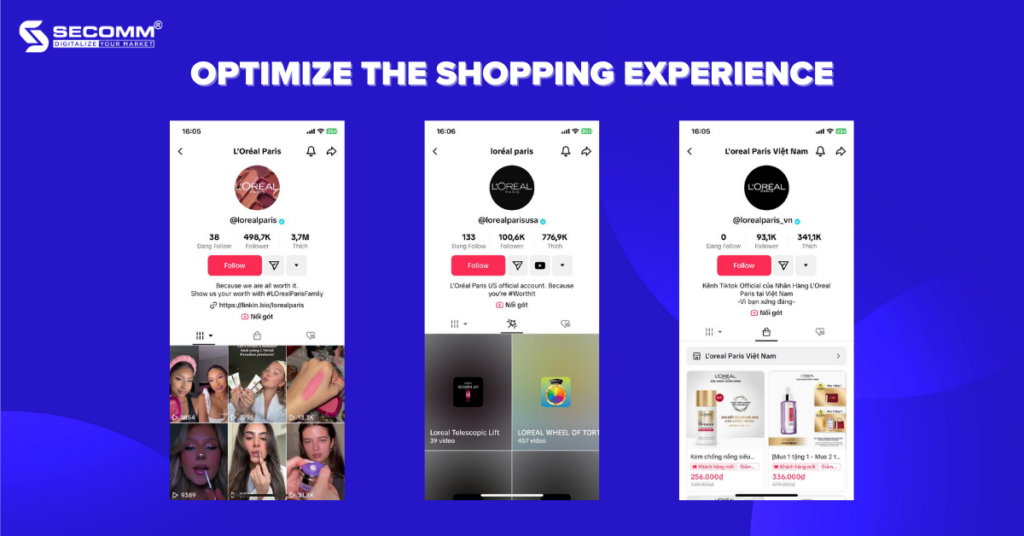
Presently, social media platforms offer comprehensive analytics and data measurement tools for businesses. For instance, Instagram Insights provides demographic information such as gender, age groups, and geographic locations.
Facebook Audience Insights goes a step further in collecting detailed data about a business’s target audience, while TikTok Pixel allows tracking vital metrics like clicks, views, and conversion rates, and assessing the effectiveness of advertising campaigns.
Leveraging these data sources assists businesses in creating more efficient social commerce campaigns compared to traditional retail operations. A noteworthy example of the successful implementation of Social Commerce with optimized tracking and measurement is Fashion Nova.
This prominent American fashion brand specializes in offering women’s clothing and accessories. Fashion Nova’s Instagram posts often incorporate sharing and user tracking features, enhancing the dissemination of information about products and the brand.
Furthermore, Fashion Nova utilizes Instagram’s measurement features and analytical tools to evaluate the effectiveness of the brand’s marketing and advertising campaigns.
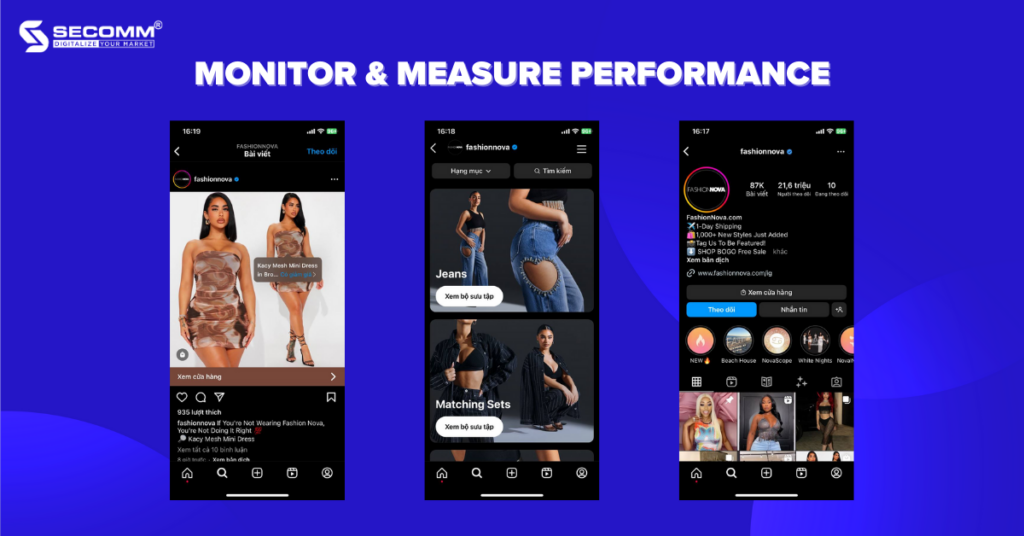
Embracing social commerce enables businesses to seamlessly engage in direct interactions with customers and gather their feedback regarding the brand or product through posts, direct conversations, comment responses, and messages.
This facilitates quick customer support, addresses inquiries promptly, fosters satisfaction and fortifies customer relationships. Moreover, based on this valuable customer feedback, businesses can refine their products/services to align with customer expectations.
Tarte Cosmetics, a renowned cosmetics brand specializing in makeup and skincare products, has effectively utilized social media platforms such as Instagram, Facebook, and Twitter to implement social commerce. The brand consistently engages with customers across social media channels.
The administrative team promptly responds to user comments and messages, addressing inquiries and offering technical support. This approach builds trust and satisfaction among customers, actively strengthening positive customer relationships.
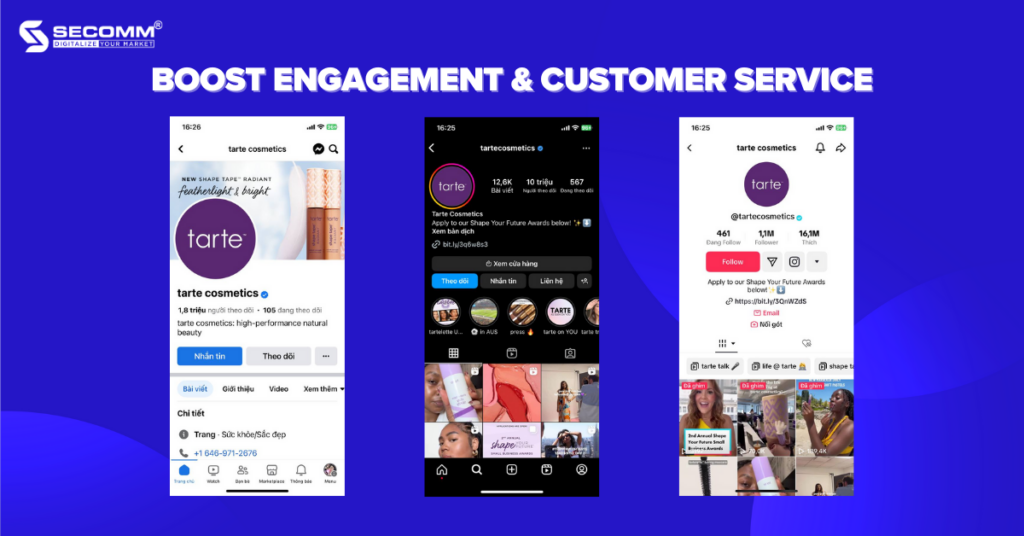
Here are insights, advantages, and examples of businesses effectively embracing Social Commerce. Depending on each business’s strategy, administrators can blend social media and eCommerce to engage customers and establish a brand in the current digital era.
Related Reading: eCommerce: Inbound Marketing vs Outbound Marketing
Contact SECOMM or directly call the hotline at 02871089908 today for complimentary guidance on implementing eCommerce Marketing overall and Social Commerce specifically.
 2
2
 6,572
6,572
 0
0
 1
1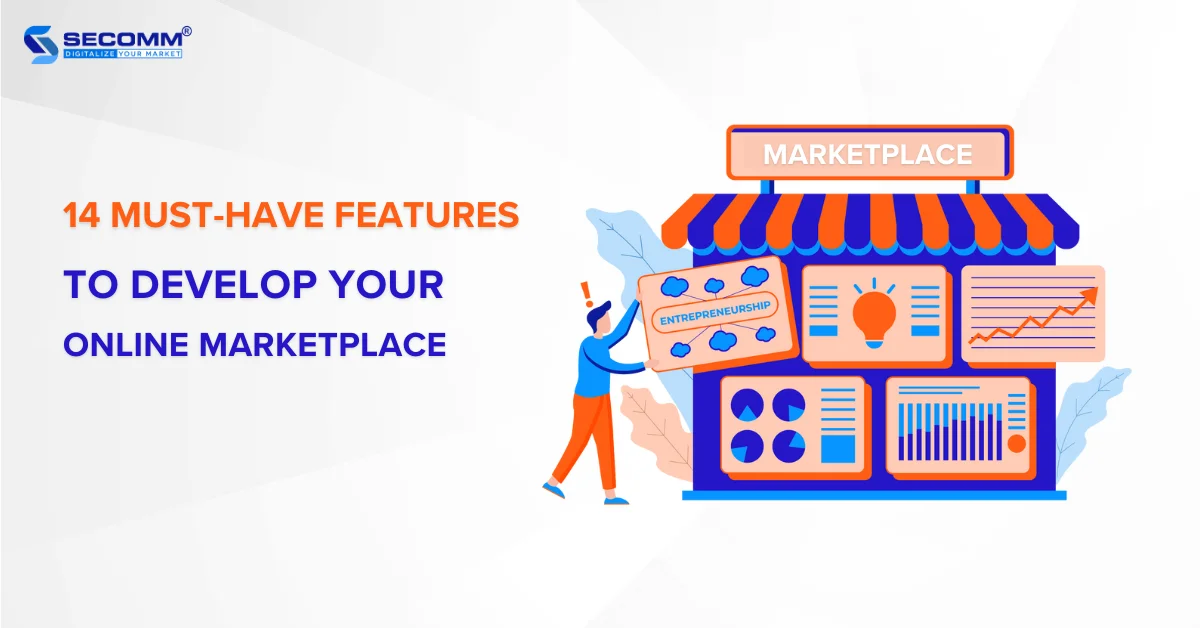
The surge in demand for online shopping via eCommerce marketplaces over recent years has been remarkable. So, it comes as no surprise that numerous businesses are looking for ways to build their own marketplaces to diversify their product offerings and engage with a wide range of customer segments.
Operating an eCommerce marketplace differs significantly from managing an eCommerce website. The key is to ensure that the experience is user-friendly and efficient for all involved parties, including administrators, sellers, and buyers, during both the operational and transactional phases.
Depending on the strategy, scale, budget, market, and target audience, businesses will make suitable adjustments. However, the following online marketplace features continue to be crucial when implementing the majority of eCommerce marketplaces today.
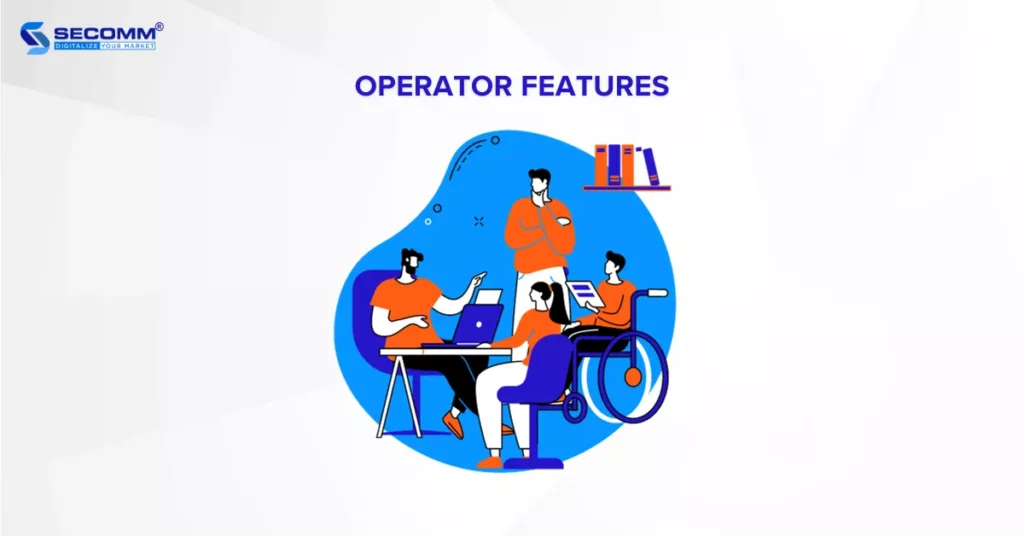
The operator, also known as an administrator or owner of the online marketplace, holds a pivotal role in managing and running the platform. They possess the authority to access and govern all data and carry the responsibility for the platform’s overall performance and growth.
As a result, essential features for operators include:
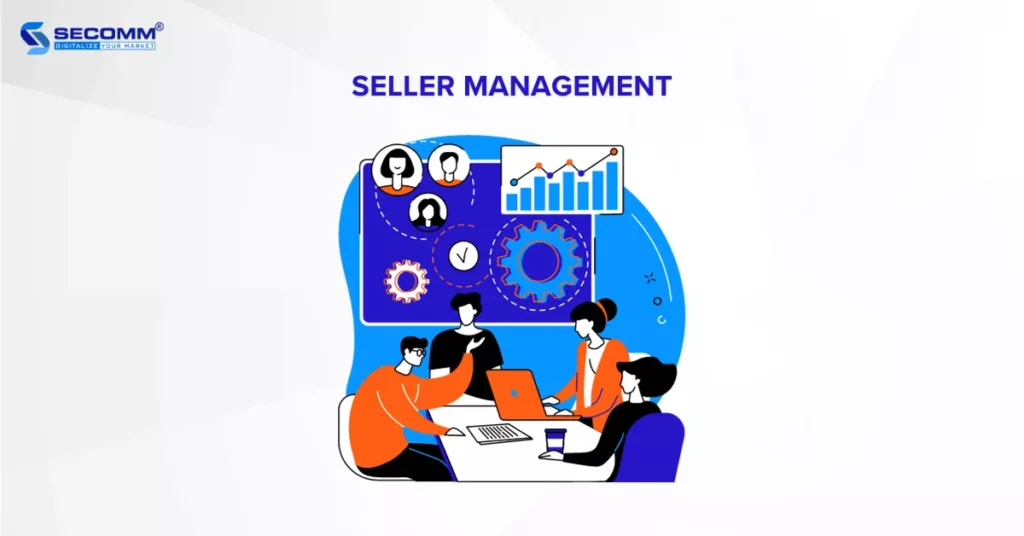
The operator’s role involves helping sellers register on the platform, gather their information, and grant access to tools that aid their business operations. Additionally, other aspects of ‘Managing Sellers’ that businesses should consider include:
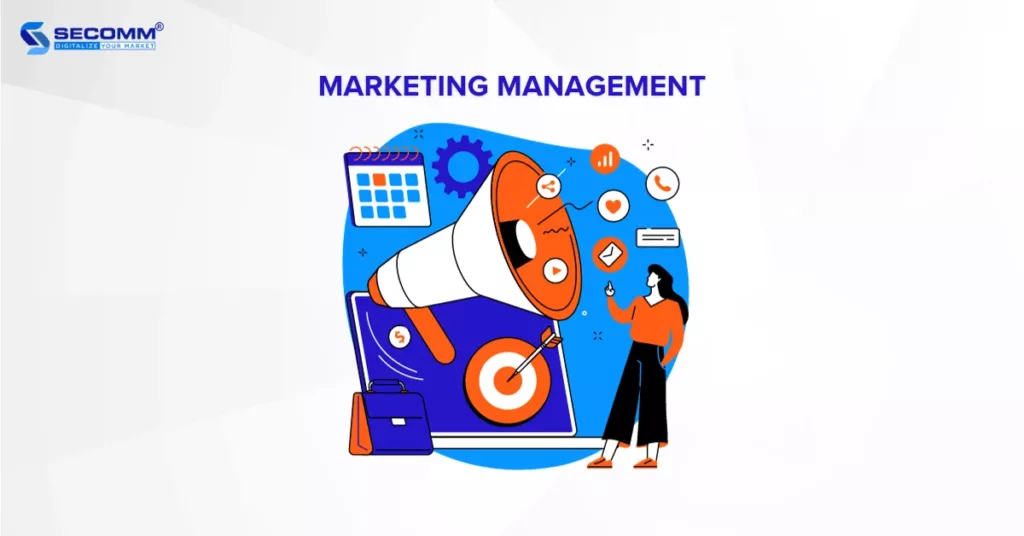
To expand the pool of registered sellers and draw more customers to shop on the online marketplace, operators continually rely on marketing efforts. Some methods include optimizing SEO, leveraging influencer marketing, running targeted advertisements, devising in-platform promotional initiatives, and more.
However, it’s crucial for businesses to possess a set of features and tools to proficiently craft and manage marketing campaigns across multiple channels. This aids in the effective promotion of their marketplaces, the attraction of additional sellers and customers, and the establishment of a distinctive presence within the competitive eCommerce landscape.
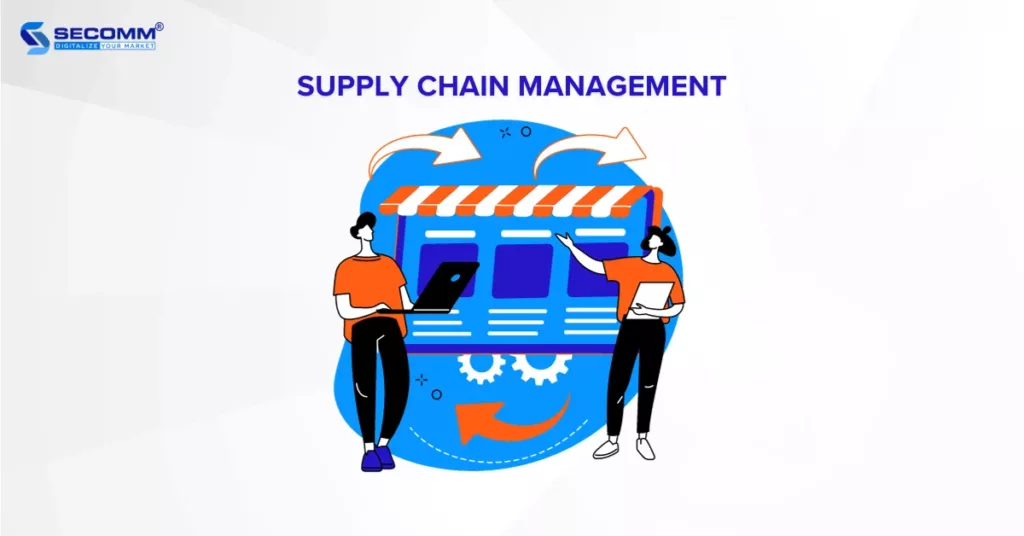
Given the substantial order volume, operators need features that offer them full control of order fulfillment. This includes inventory management, overseeing multiple warehouses, configuring automated workflows for handling and transporting orders between warehouses, and delivering them to end-users.
Plus, to optimize the delivery process, businesses can partner with third-party shipping providers to provide customers with various choices, such as standard, express, or expedited shipping methods.
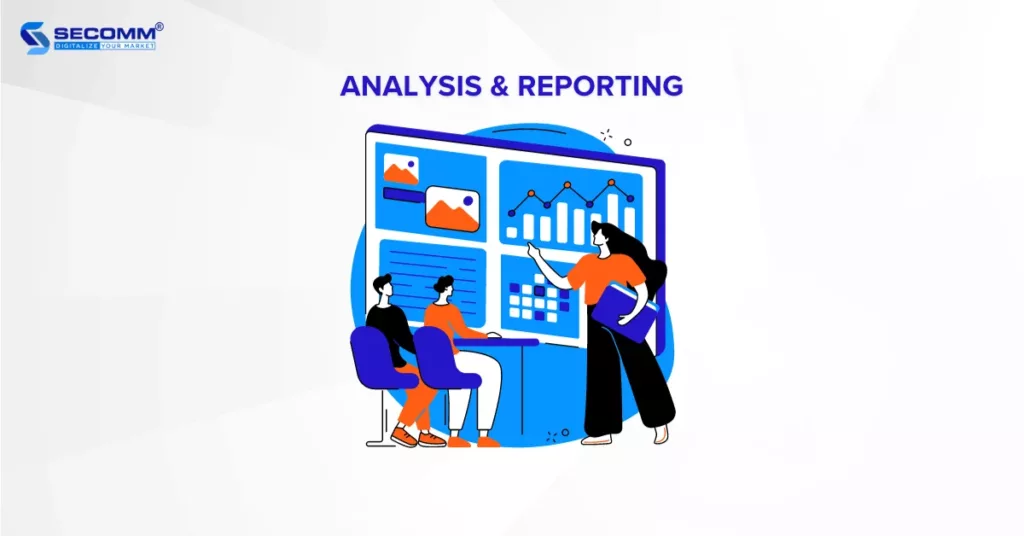
Through comprehensive data analysis and detailed reporting, businesses can gain insights into their overall operations and make informed adjustments. Key data points include:
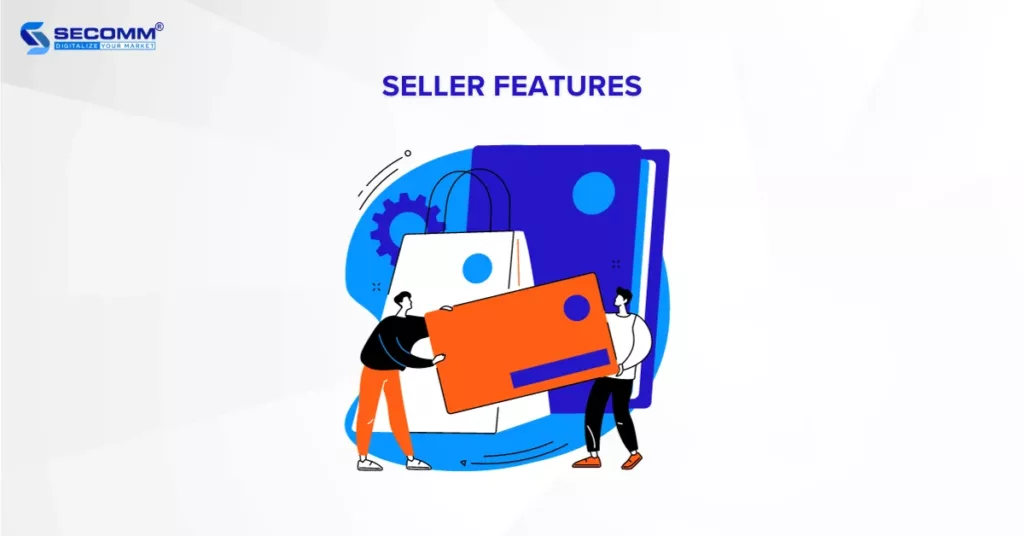
Sellers, also known as suppliers or merchants, are individuals or businesses that offer products or services on the online marketplace. Their responsibility is to manage their operations and optimize sales performance.
Therefore, eCommerce marketplace features for sellers to conduct efficient business operations include:
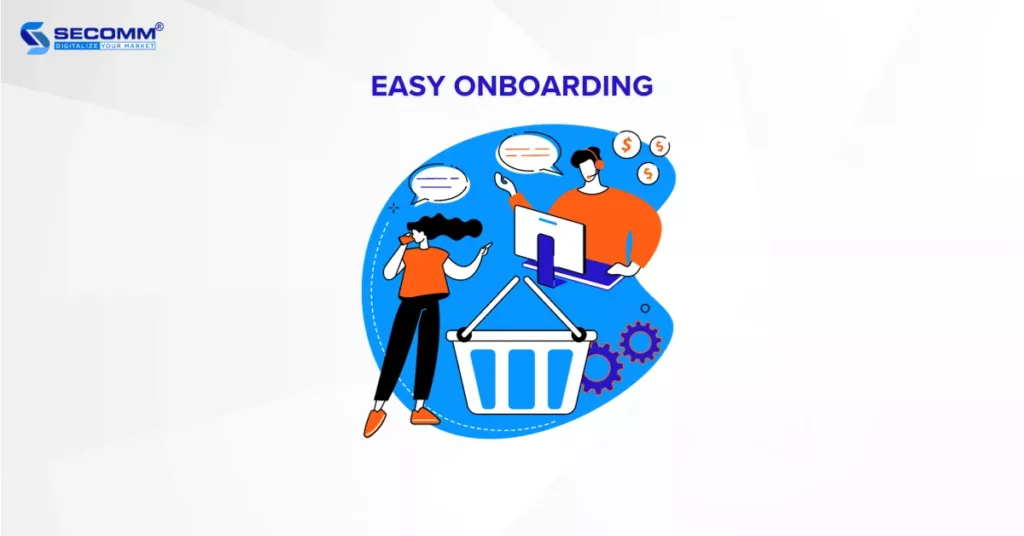
Sellers have many choices in the midst of multiple online marketplaces. So, offering a swift and uncomplicated registration and store setup process is an effective way to attract a wide pool of new sellers to open their stores.
Businesses can offer detailed step-by-step guidance to sellers, from creating an account and verifying their seller identity to decorating their store and listing products. Furthermore, businesses can provide instructional videos, FAQs, and blogs to guide them on optimizing their store, promoting products on the platform, as well as understanding the fees associated with the eCommerce marketplace’s sales policies.
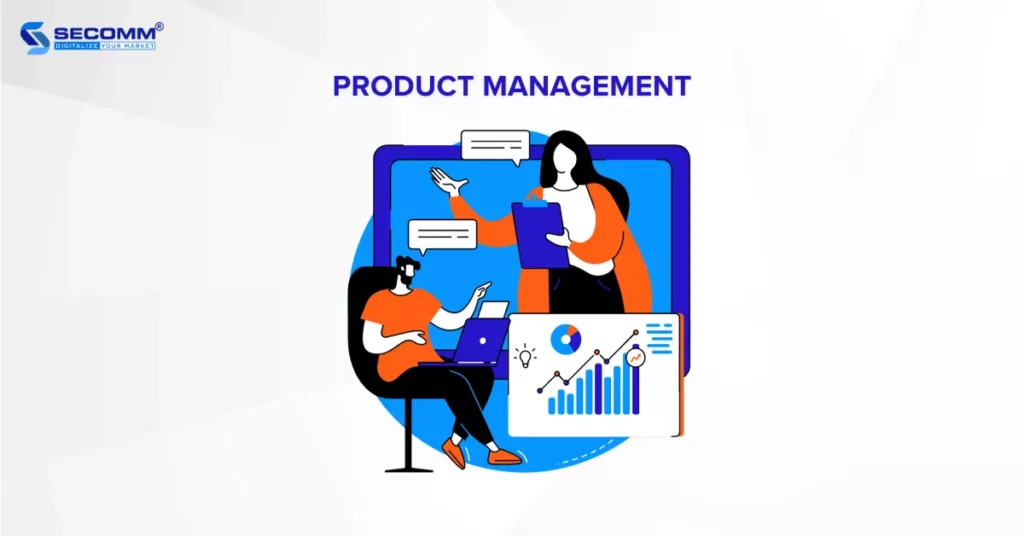
Beyond listing products, helping sellers manage their product catalog effectively on the marketplace is equally important.
This includes tasks like adding and removing products, maintaining high-quality product descriptions, images, and videos, handling product variations and attributes, updating inventory, setting product prices, applying discounts, prompting product reviews, and moderating and verifying reviews based on the platform’s standard.
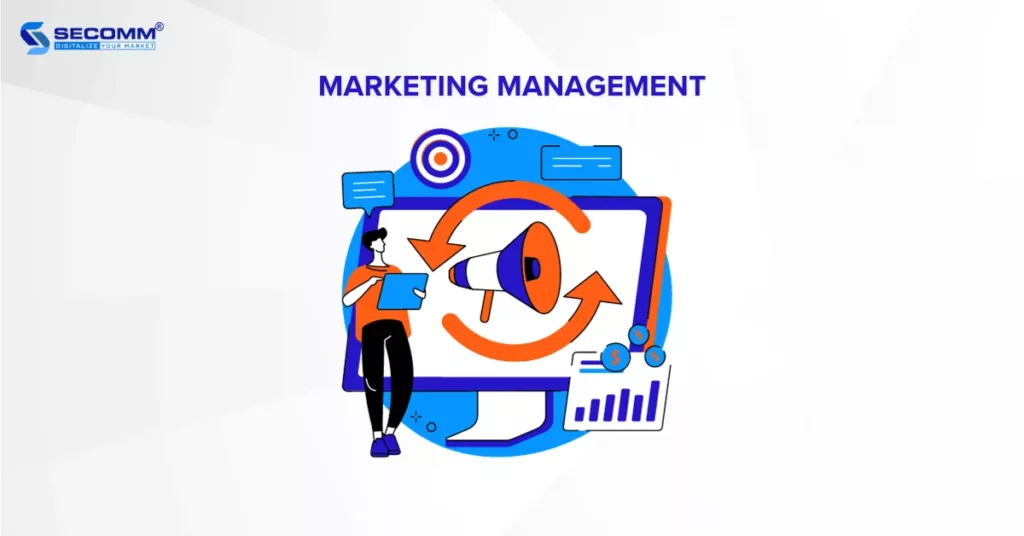
Sellers need tools and features for setting up marketing campaigns to promote their stores and products, driving increased sales. These commonly used marketing tools on online marketplaces include in-site and off-site advertising, promotional messaging, flash sales, bundled deals, shipping discounts or free shipping promotions, creating discount vouchers, live-streaming sales events, and participating in platform-wide promotional activities.
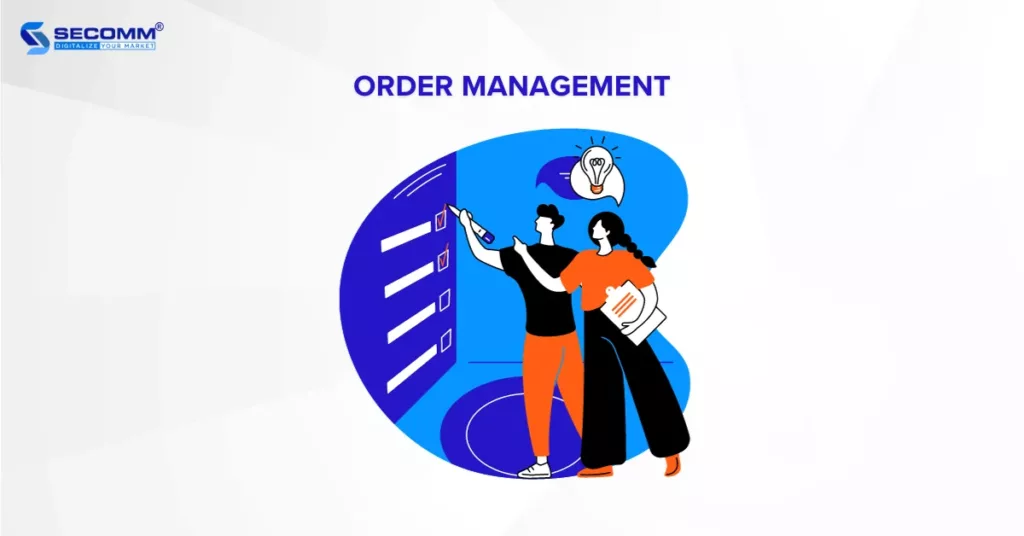
Providing sellers with effective order management capabilities also impacts the customer experience on the eCommerce marketplaces. This means offering sellers features to manage their order lists, track the status of orders, fulfill orders, handle returns, and efficiently address any issues that may arise.
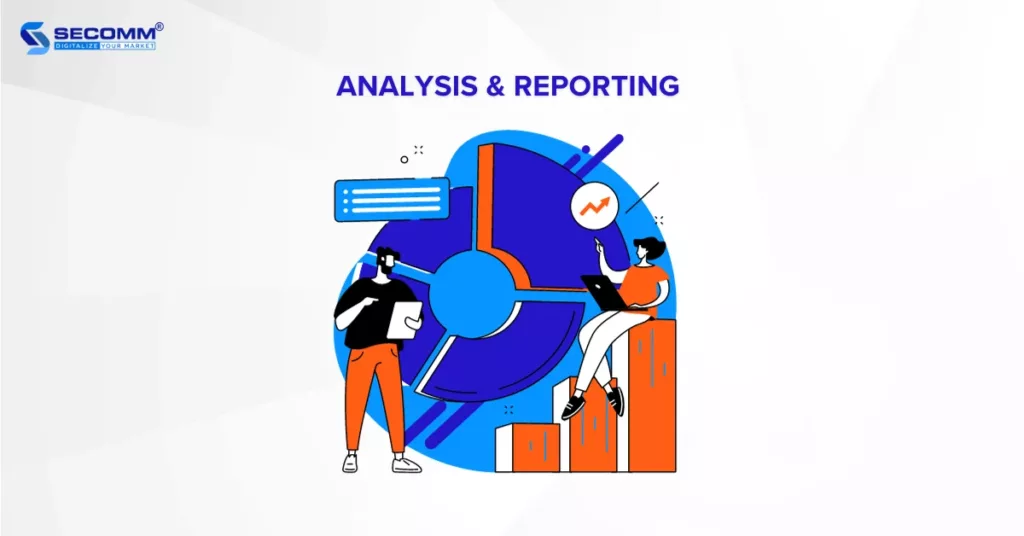
Sellers rely on data analysis and reports to track and manage their business performance on the online marketplace effectively. These reports provide valuable insights for making data-driven decisions and optimizing their operations.
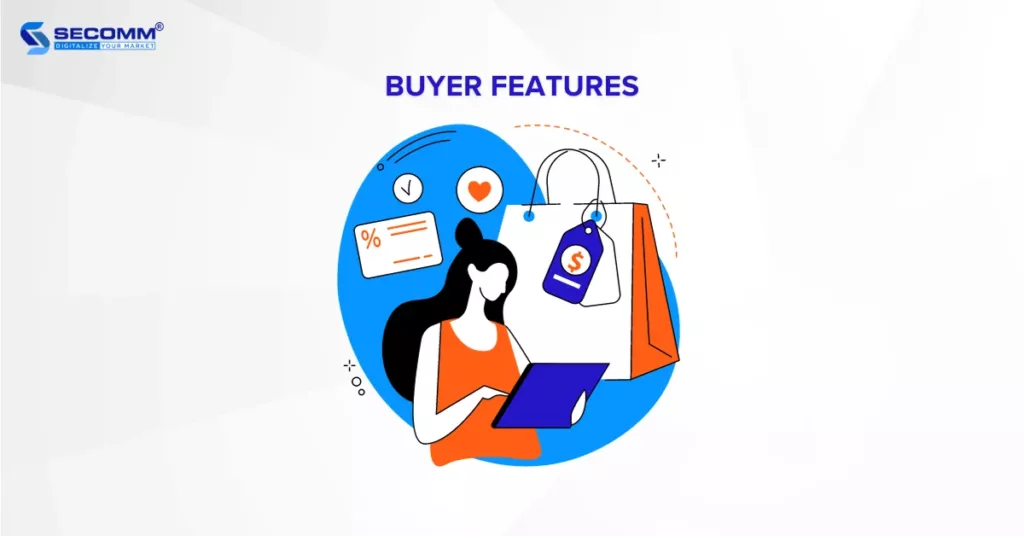
Buyers, also known as customers, refer to individuals or businesses that purchase goods or services from sellers on the eCommerce marketplace. Customers play a crucial role in driving the success of the marketplace. Therefore, feature development is focused on enriching the shopping experience.
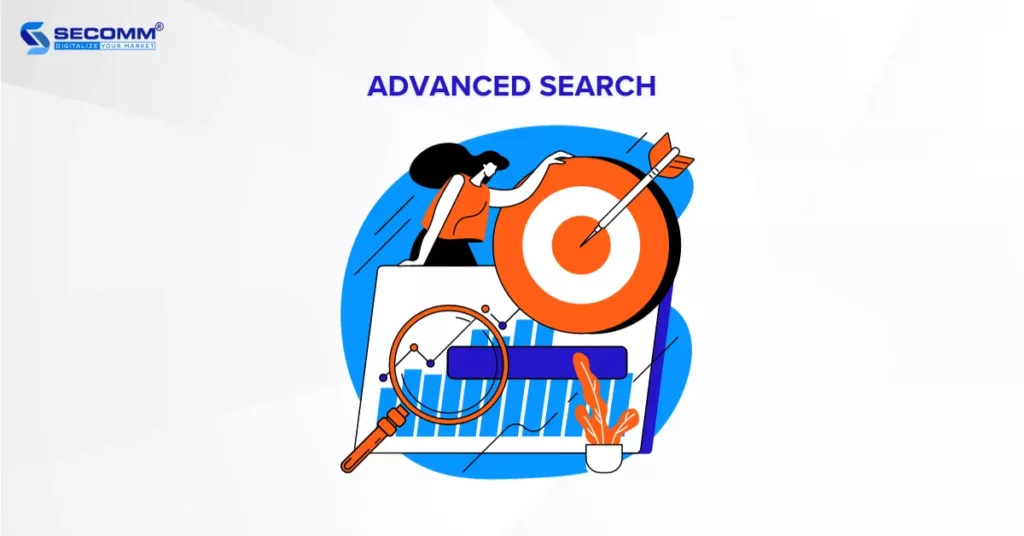
When accessing an eCommerce marketplace, the first thing most users do is use the search bar to find the information and products they desire. However, the product catalog on marketplaces is extensive and can be overwhelming for buyers.
Therefore, beyond maintaining well-structured and organized product categories, businesses should offer advanced search capabilities to simplify and enhance the customer’s product discovery experience process. Common advanced search options include filtering, image-based, or voice-based search (optimized for mobile devices).
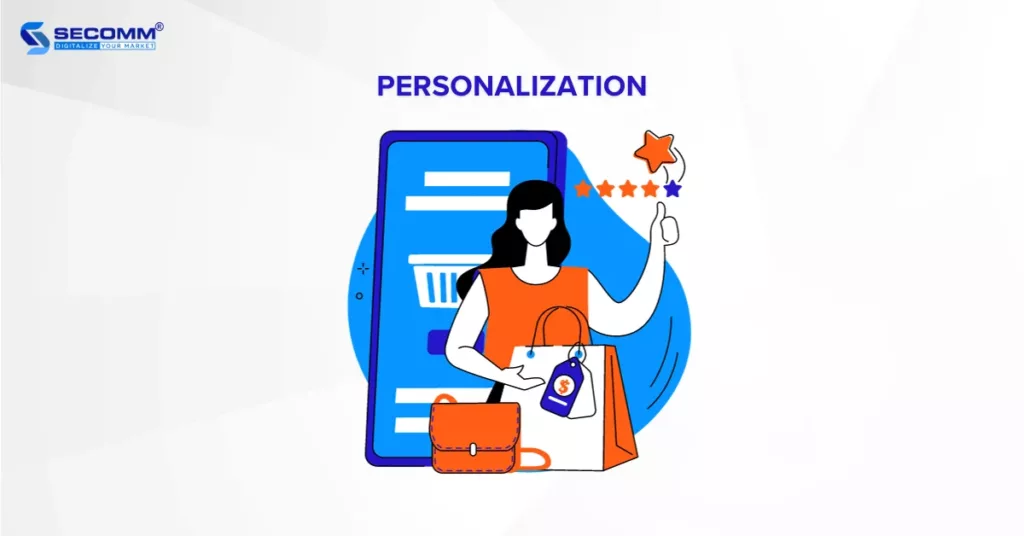
Features like product recommendations, push notifications, personalized content, and customer service tailored to individual shopping behavior and preferences are crucial for enhancing the eCommerce experience. Studies have revealed that 74% of customers feel frustrated when encountering non-personalized shopping experiences on websites.
By integrating advanced search capabilities with personalization, companies can offer a more enriching user experience, leading to greater satisfaction, higher levels of engagement, and increased customer retention. This transforms their marketplace into an ideal shopping destination for buyers.
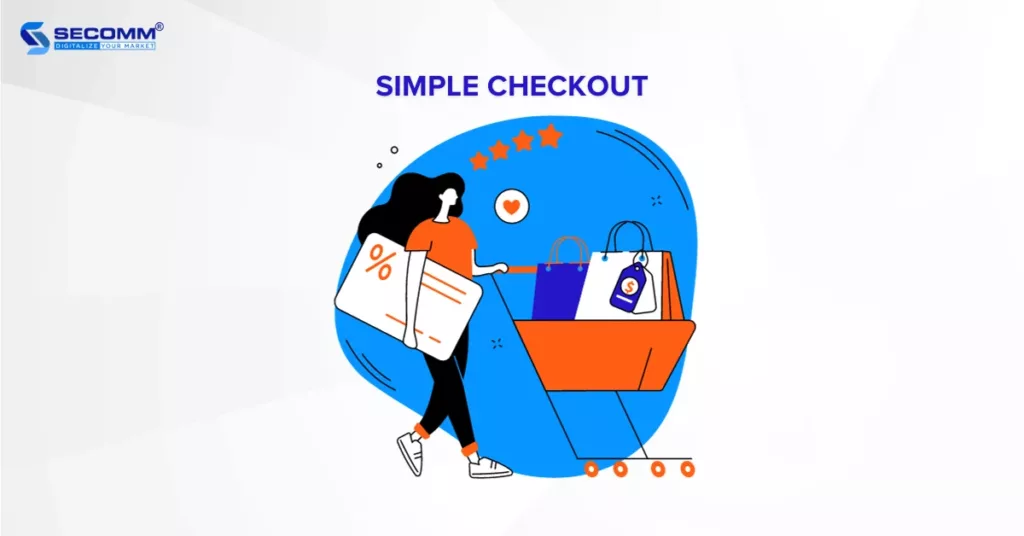
Out of the various reasons for cart abandonment, issues related to long and complicated checkout procedures make up 17%, according to Baymard. it is essential for businesses to streamline the payment experience for customers, removing unnecessary steps, offering a transparent payment process, or implementing a one-page checkout.
Moreover, businesses can diversify their payment methods to suit their target markets, including options such as Cash on Delivery (COD), credit card payments, eWallets, and buy now, pay later options.
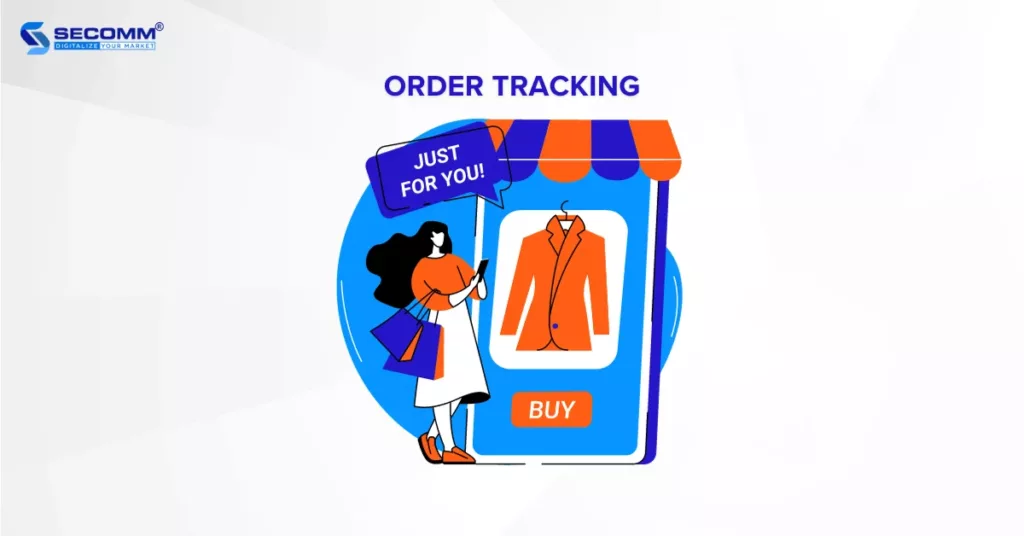
To boost the trust of buyers and sellers in the eCommerce platform, it is crucial for businesses to offer real-time order tracking and status-checking capabilities.
Buyers can track their orders through the marketplace’s mobile app or website by using their unique order IDs. This way, both the seller and the buyer can communicate promptly if any issues arise with the order.
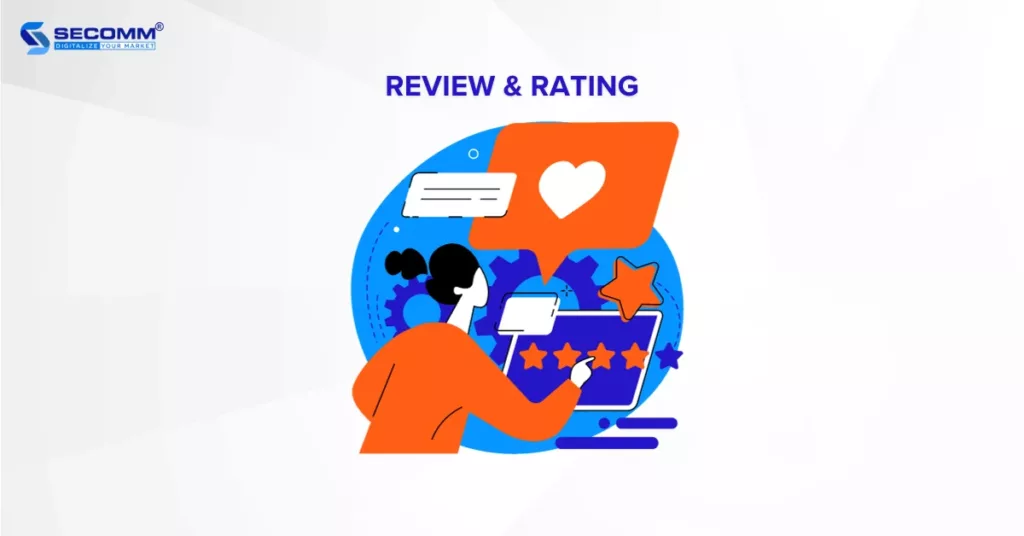
With a diverse range of product choices offered by different sellers, customers may find it challenging to make purchasing decisions when they lack trust in either the product or the seller. Hence, the review and rating feature is essential for building trust and expediting decisions.
The review feature allows buyers who have made purchases to leave comments, reviews, and ratings for a product, customer support, and product packaging, regardless of the seller.
Whether these reviews and ratings are positive or negative, they have a significant impact on a buyer’s decision-making process. Therefore, this serves as a motivation for sellers to enhance the quality of their products and services and for the eCommerce marketplace owner to provide an improved user experience.
Above are the 14 essential features for operators, sellers, and buyers that businesses should keep in mind when building an online marketplace. With many years of eCommerce implementation experience for numerous clients in various countries worldwide, SECOMM has gathered valuable insights to boost the development and operation of your business’s marketplace swiftly and effectively.
Contact or call SECOMM’s hotline (02871089908) today for a free consultation.
 2
2
 9,174
9,174
 0
0
 1
1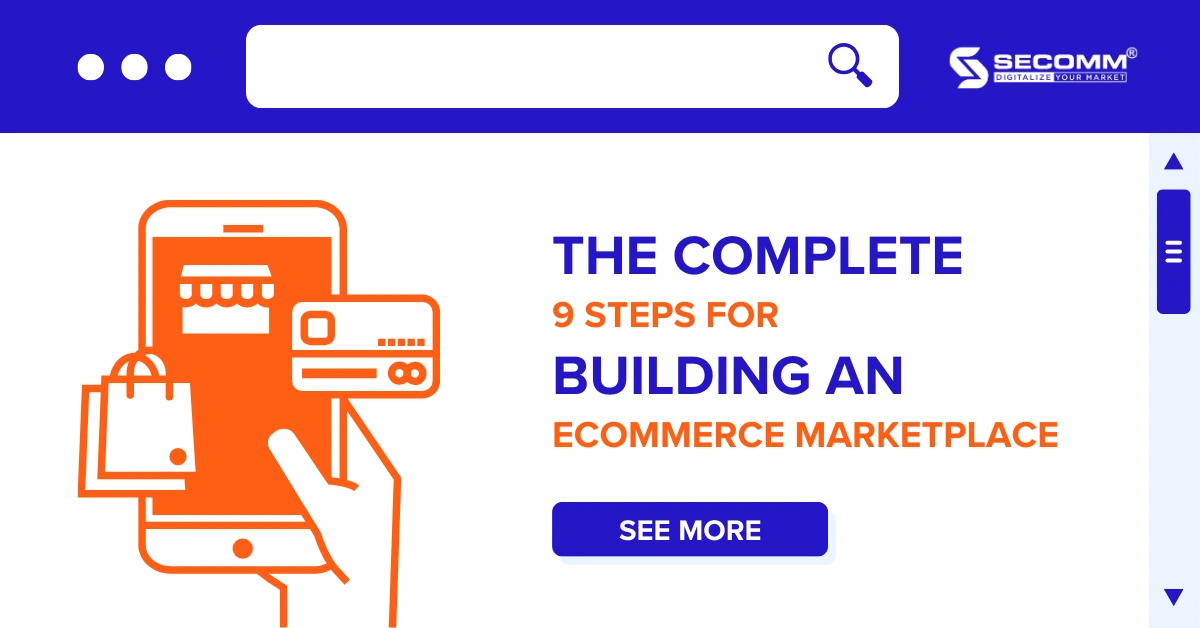
Unlike building eCommerce websites for simpler models like B2C or B2B, implementing an online marketplace requires a higher level of technical knowledge, programming skills, database management, system administration, and more.
In this article, SECOMM will share the essential steps for successfully developing an eCommerce marketplace, from market research and business planning to designing an appealing user interface, developing functional systems, and more.
Market research and business planning are essential and indispensable initial steps in starting an eCommerce marketplace or any business operation.
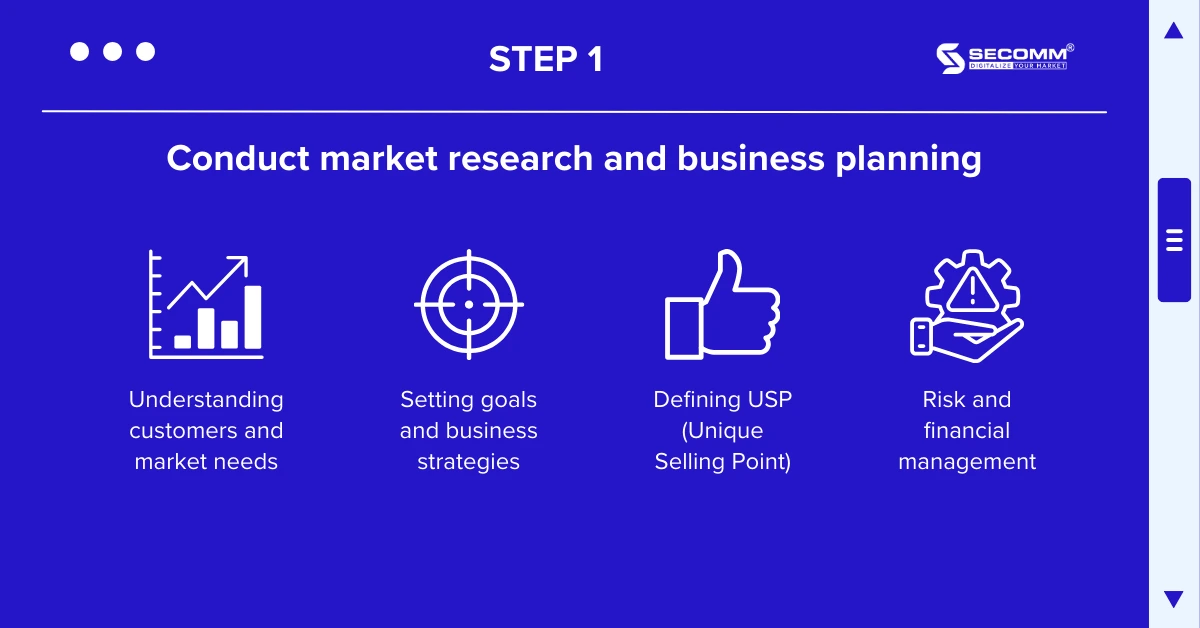
Here are some considerations for businesses when undertaking these activities:
The eCommerce platform is a crucial element in the process of building an online marketplace. If the right choice is not made from the beginning, businesses may find themselves entangled in the whirlpool of technology when implementing their marketplace.
Typically, there are two types of eCommerce platforms for businesses to choose from: SaaS and Open Source.
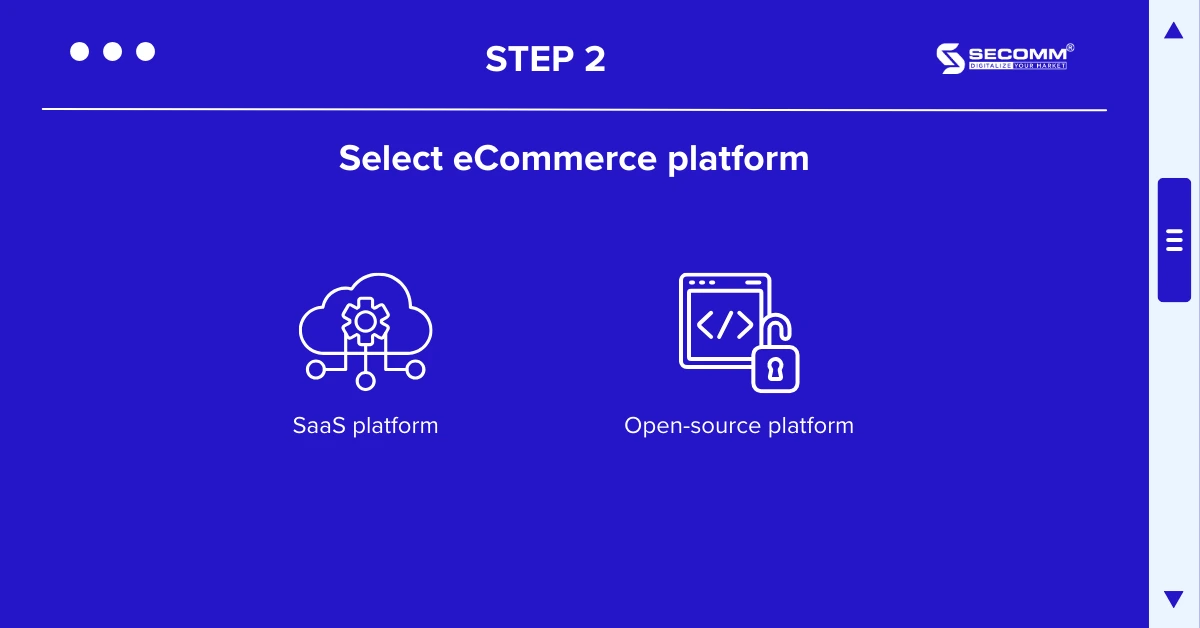
SaaS (Software as a Service) eCommerce platforms are a software distribution model for building websites.
In this model, data is stored on the provider’s server, and the platform is responsible for handling technical aspects for businesses. Some popular SaaS platforms today include Haravan, Shopify, BigCommerce, and more.
An Open Source platform, or open-source software, is software with publicly available source code that anyone can use for free. Open-source platforms are an optimal choice for businesses looking to develop complex eCommerce systems, especially tailored to the specific needs of an online marketplace.
Prominent examples of Open Source online marketplaces include Magento, WooCommerce (a plugin for WordPress), OpenCart, and more.
Each platform type has its own set of advantages and disadvantages. Therefore, businesses should either have an in-house team or collaborate with an experienced and highly skilled eCommerce marketplace development agency to effectively advise on the selection, development, and operation of the chosen platform.
The initial decision regarding resource allocation for starting an eCommerce marketplace system has a profound impact on a company’s early business direction. Companies can choose to either collaborate with specialised development firms or establish their own in-house teams.
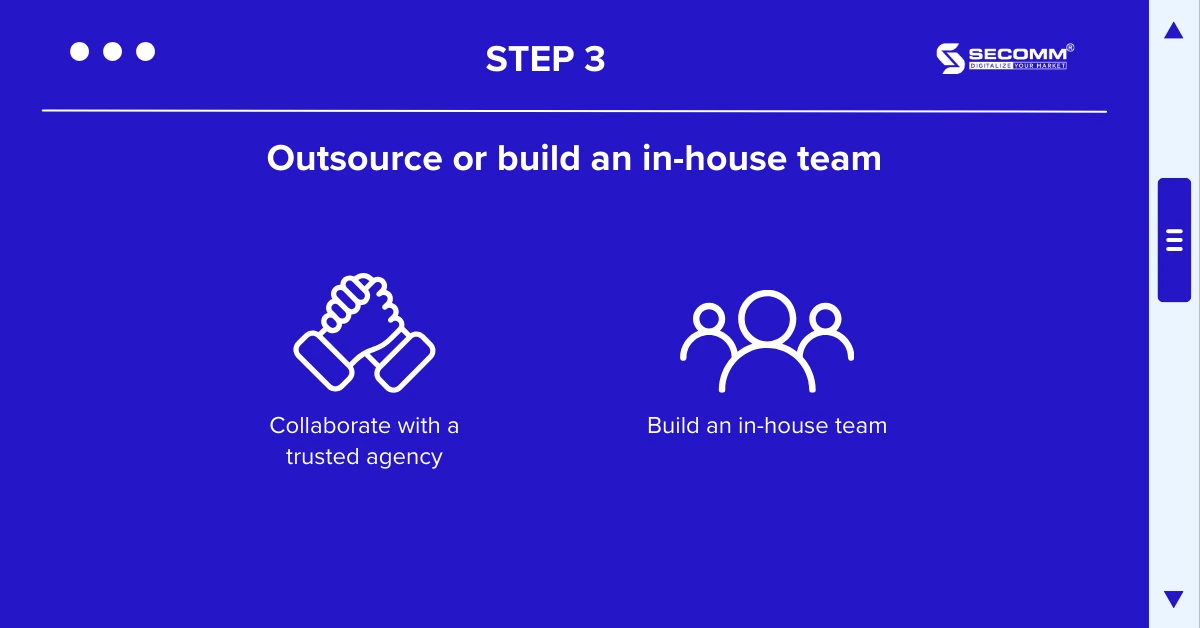
Opting for an in-house team entails investing time and budget into the recruitment and training of staff. However, it provides effective resource management, enabling businesses to adapt and develop the online marketplace system in alignment with their original vision.
Alternatively, when companies decide to seek external partners, they need to collaborate with various firms to identify the most reputable one. However, upon finding a partner with extensive practical experience in marketplaces across multiple platforms, businesses benefit from consultations and a multitude of solutions from diverse perspectives even before system development begins.
Moreover, these firms possess a wealth of experience in promptly addressing emerging issues during system development and operation. This not only ensures that the requirements are met as anticipated but also facilitates valuable knowledge and experience exchange among all parties involved.
The User Interface (UI) and User Experience (UX) are often considered two inseparable aspects in the process of designing the interface for an eCommerce marketplace.
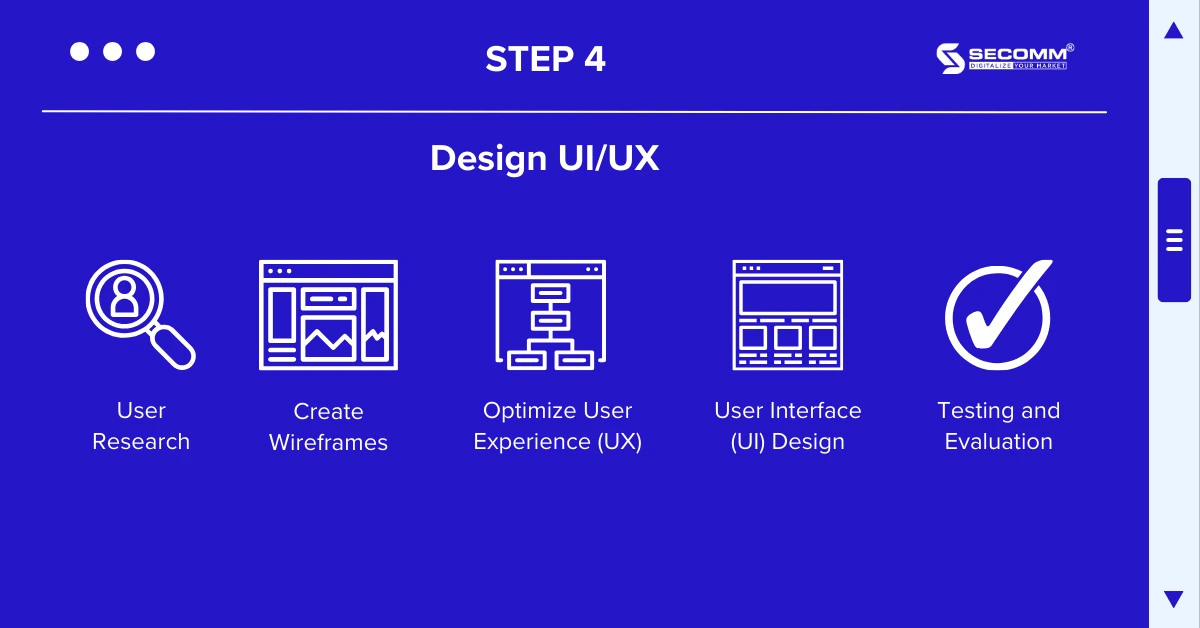
Here are the key steps in the UI/UX design process:
Starting from business requirements, the technical team will build the system architecture for the eCommerce marketplace based on the appropriate technology framework or platform. Various architectures can be used, such as three-tier architecture, microservices architecture, hybrid architecture, headless architecture, etc. Each type of architecture has its own advantages and limitations, so businesses need to carefully consider and work with experts on the team or partners to choose the most suitable system architecture for each stage.
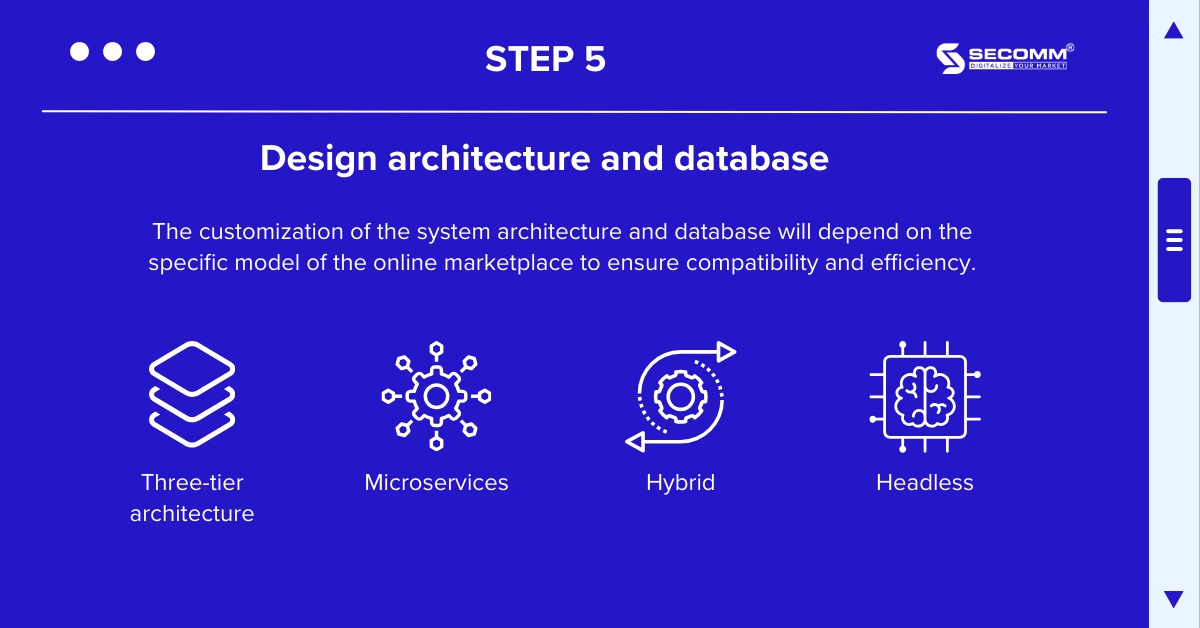
Another equally important next step is to establish security and data management. Businesses need to define security measures to protect user data, payment information, and other critical data. Ensure that data is encrypted and transmitted securely via an SSL connection. Implement data protection measures such as access control, user authentication, data encryption, and data integrity checks.
Depending on the operating model of the marketplace, system and database design may need to be customized to be suitable and effective.
After completing the essential functional systems, businesses should continue to develop specific features for their online marketplace, such as:
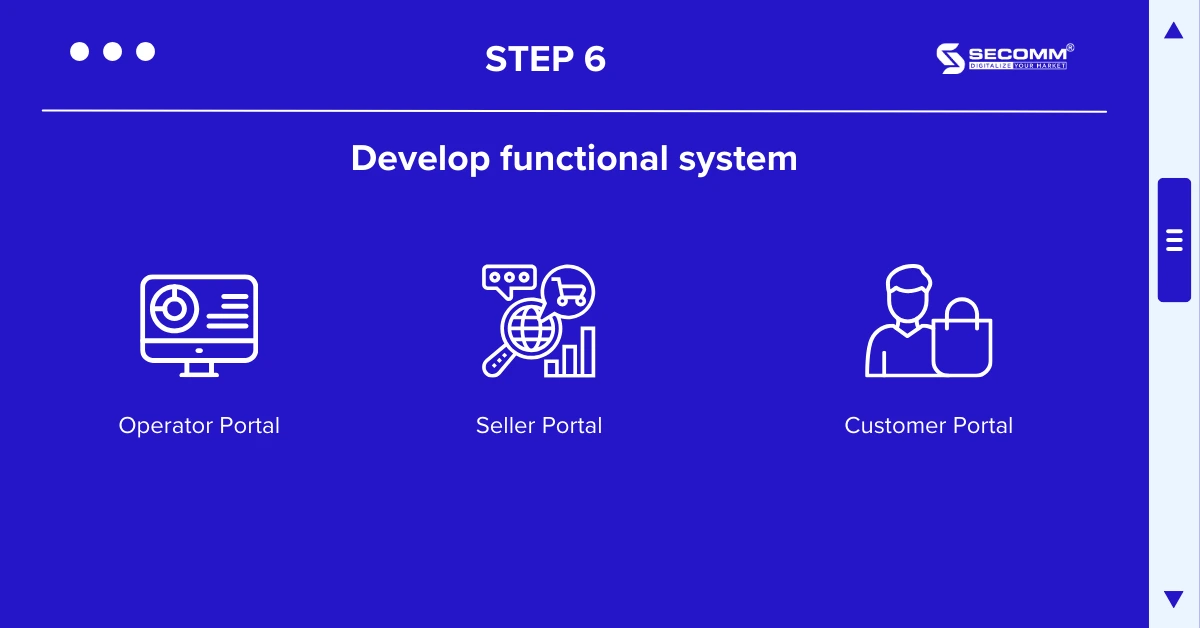
Operator Portal: Full control of platform information, including seller management, product categorization, customer segments, supply chain management, ad content control, and more.
Seller Portal: Sellers self-manage their presence in the marketplace, including product listings, orders, and activities, etc
Customer Portal: Allow users to perform and manage basic information such as phone numbers, email addresses, delivery addresses, adjust payment options, request quotes, manage shopping lists, check order status, etc.
Whether you’re building an in-house team or enlisting the services of external development agencies, the quality testing phase of a project holds immense significance. This critical stage is where businesses validate that the system functions as expected and complies with the initial requirements.
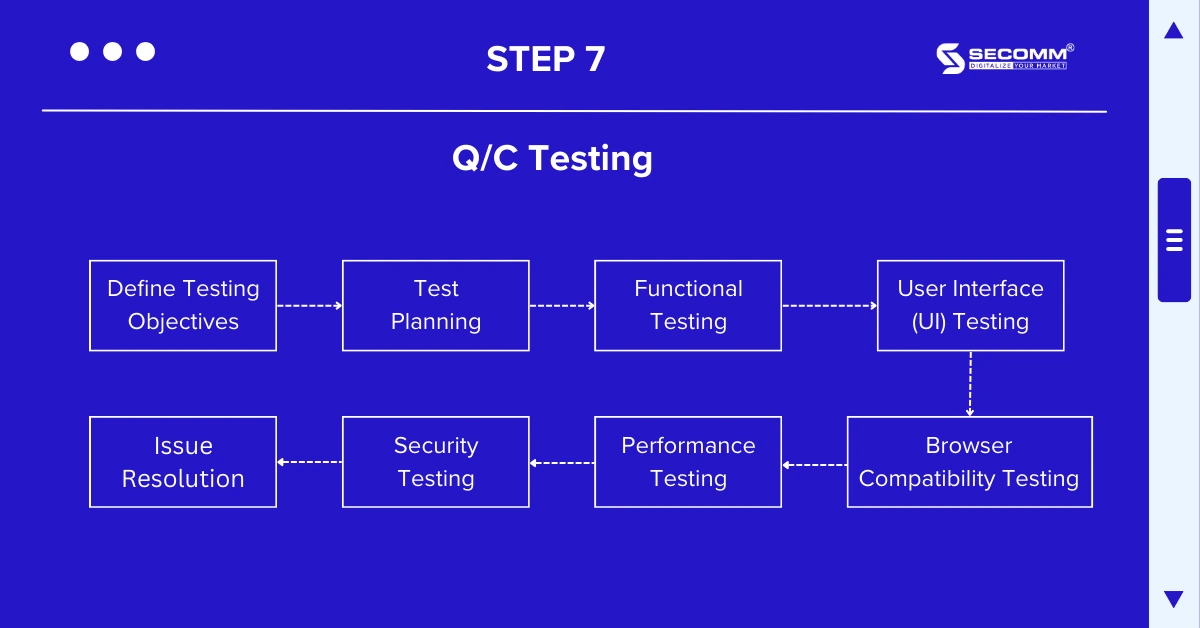
Step 1: Define Testing Objectives
Identify the objectives and scope of the testing process. Set specific criteria and requirements that the business wants to verify to ensure the platform operates accurately and meets the specified requirements.
Step 2: Test Planning
Determine a detailed test plan, including test cases, scenarios, and data. Identify the resources, timeline, and scope of the testing phases.
Step 3: Functional Testing
Verify all website functions to ensure they are working correctly as expected. If the business’s website supports multiple languages and regions, it should also verify compatibility and display of each feature in different geographical areas.
Step 4: User Interface (UI) Testing
Ensure the interface is designed beautifully and user-friendly. Evaluate information display, buttons, links, and user experience on various devices, including mobile and tablet.
Step 5: Browser Compatibility Testing
Test the website on popular browsers such as Google Chrome, Mozilla Firefox, Safari, and Microsoft Edge to ensure compatibility and correct display on all platforms.
Step 6: Performance Testing
Assess website performance, including page load speed, concurrent processing, and scalability. Ensure the website operates smoothly and can handle the expected traffic load.
Step 7: Security Testing
Examine the platform’s security by testing intrusion potential, data security, and user authentication. Verify security methods such as SSL, data encryption, and security certificates.
Step 8: Issue Resolution
Document and track any errors and issues that arise during testing. Identify the root causes, rectify the errors, and retest until the testing process is approved, and the entire system is ready for go-live and operation.
Go-live is the final stage in the process of starting an eCommerce marketplace when the system is officially launched and becomes operational.
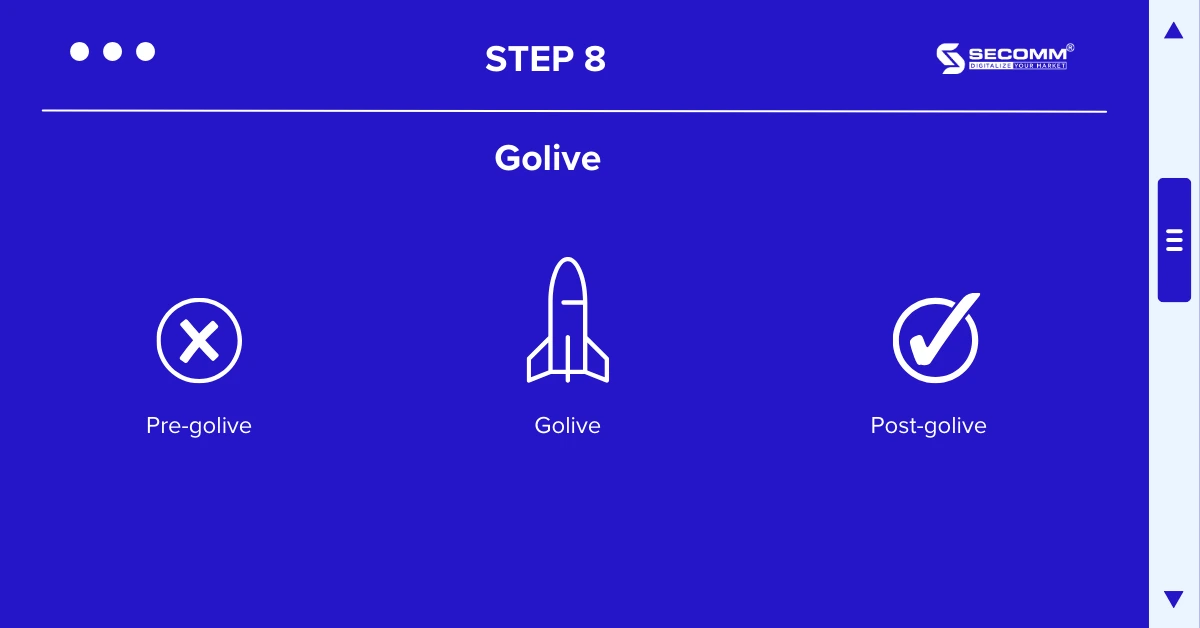
To ensure a successful go-live process, businesses should prepare a checklist known as the Go-live checklist. This is a list of tasks that the deployment team needs to perform to prepare the system for go-live. The checklist includes task items, responsible individuals, status, and how they affect the system.
Regularly updating the system is important for businesses to adapt to the ever-changing customer needs, improve customer experience, stay abreast of emerging technology trends, enhance competitiveness, and more. Moreover, continuous bug fixes and security patch updates enhance the brand’s credibility, safeguard users from internet threats, and so on.
Moreover, the development of new features empowers businesses to capitalize on market opportunities and scale their operations more professionally. For example, after a period of operation and accumulating a specific customer base, businesses can introduce features tailored to loyal customers.
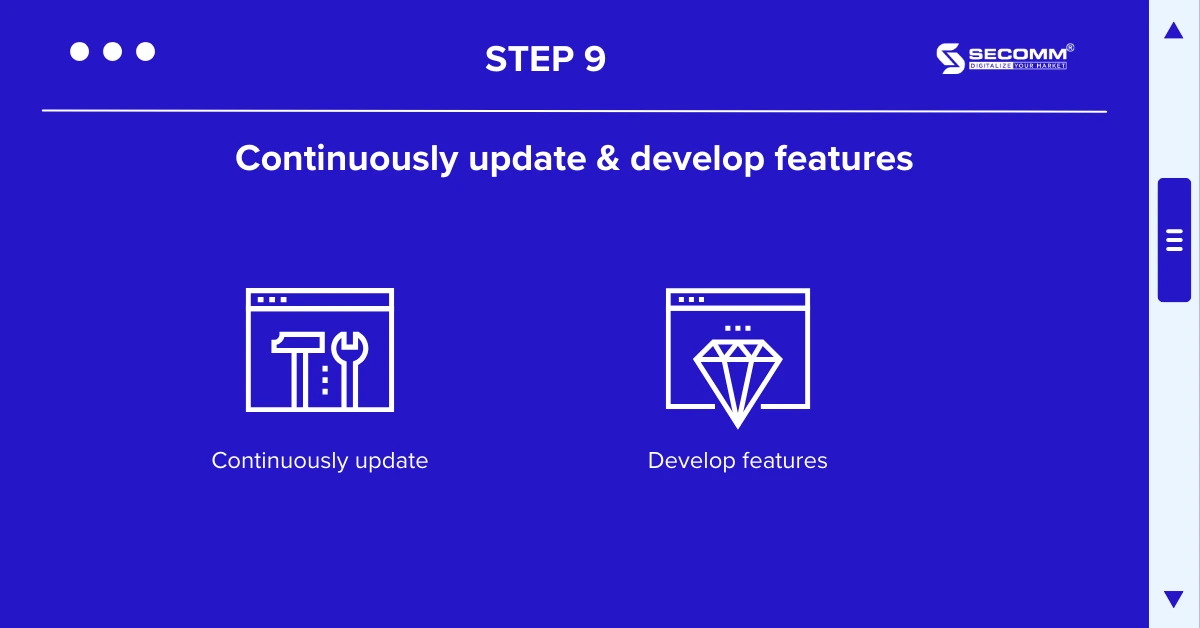
Running a thriving marketplace involves a multitude of factors, such as the business model, financial capabilities, and building strategic partnerships with diverse brands. However, a well-functioning eCommerce platform with high performance plays a vital role in the path to success. The journey of marketplace development is anything but straightforward. It requires substantial investments of time and resources for thorough research and the seamless alignment of solutions with each development phase.
Recognizing the challenges and hurdles that businesses face during the process of starting their eCommerce marketplace, feel free to contact or call SECOMM directly at (02871089908) for a free consultation.
 2
2
 13,668
13,668
 0
0
 1
1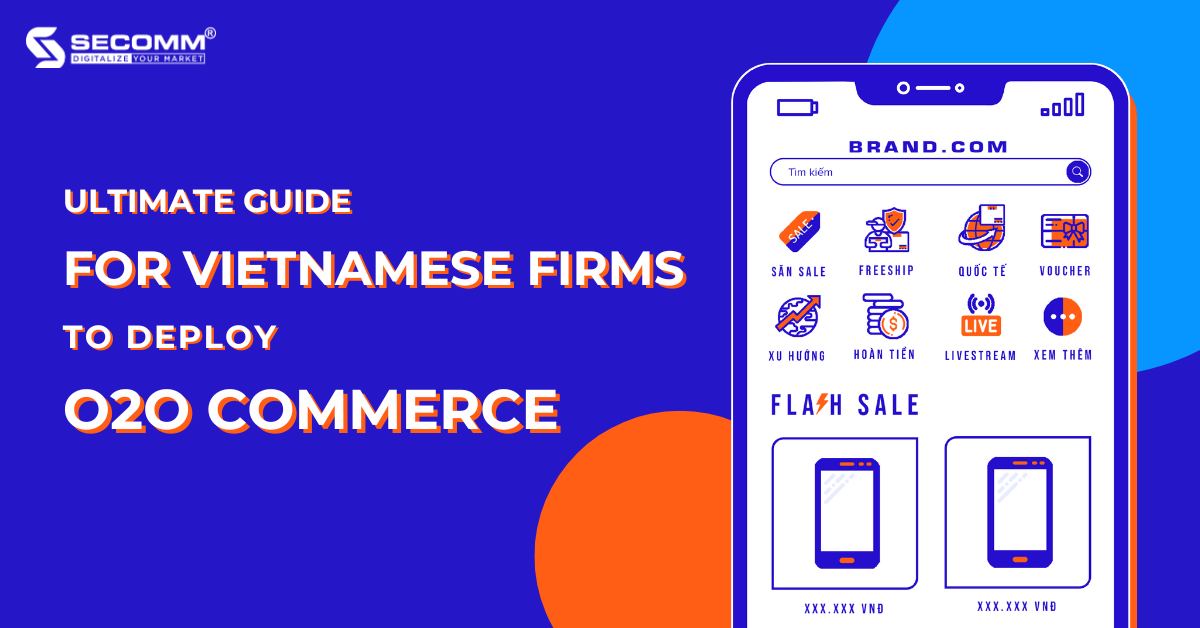
According to data compiled by Statista, over 82% of retail sales take place in brick-and-mortar stores. Within that, more than 81% of customers have spent time researching products online before deciding. This demonstrates both online and offline business activities must be aligned for the optimized overall operation. That means you, as a business, need to consider implementing an O2O commerce strategy in line with your business goals and capabilities.
To establish objectives, it’s important to determine your vision for O2O commerce implementation. It represents the future look that you aim to achieve, and then you will set specific and measurable goals. You can also use SWOT to make sure you understand your strength, weakness, opportunity, and threats.
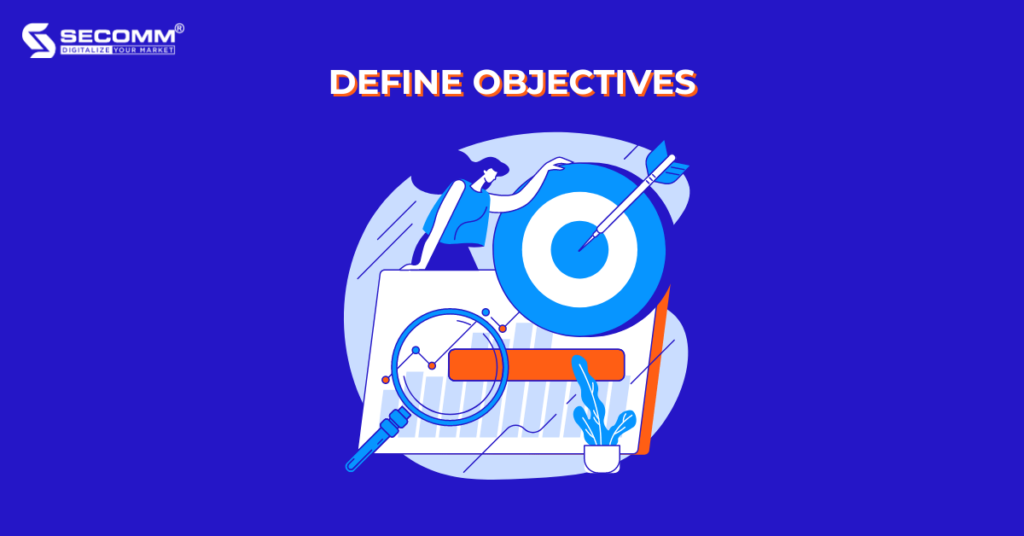
Clear objectives will keep you focused on what is important, minimize risks, and achieve O2O commerce success.
Next is to work with your team to develop O2O strategies to achieve the established objectives.
You can use performance analysis software to measure and analyze, identifying pain points and touchpoints throughout the purchasing journey. This way, you can determine which O2O model to implement and which channels are suited for the chosen model.
After choosing your business model, you will select resources to facilitate O2O commerce.
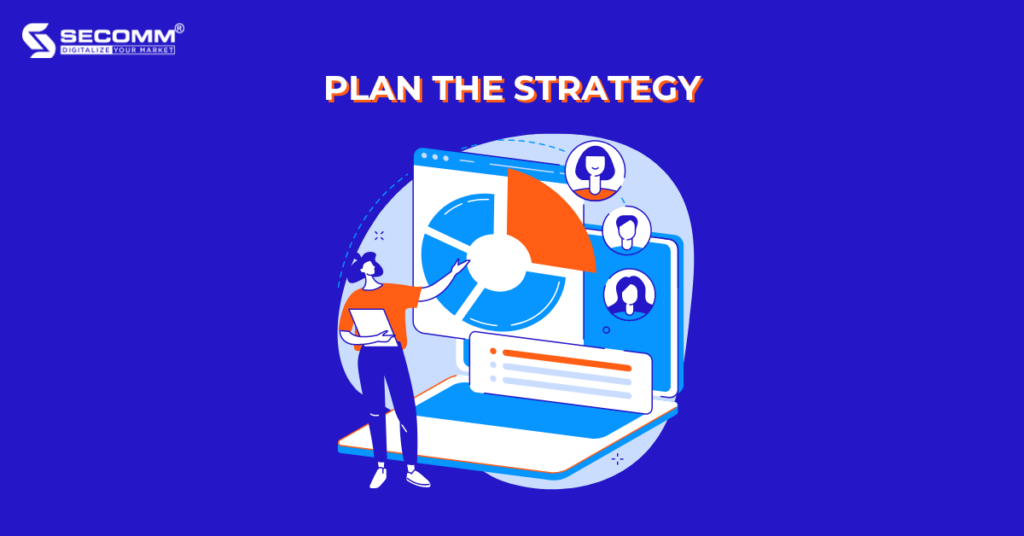
Here are 3 great ways to pool resources:
Number 1. Plan to build your in-house team for both online and offline sales channels
Pros: You can manage and shape your team to develop the business the way you want
Cons: It requires significant costs and time to recruit and train your in-house team, making your market entry to be slower than the competition.
Number 2. Collaborate with an O2O-experienced developer
Pros: You can learn a lot from your partner
Cons: It’s not easy to find trustworthy and professional partners with expertise that suits your needs.
Number 3. Facilitate the O2O commerce with an expert developer along with building the in-house team to maintain it.
Pros: You can quickly develop the O2O system and control it in the long run
Cons: It takes time to find a trustworthy vendor, as well as the costs to recruit and train your in-house team.
Those approaches can help you in effectively outlining your O2O commerce plan, encompassing aspects such as budget allocation and implementation timeline.
Typically, businesses that implement O2O strategies are those that already have an existing offline business system. However, to effectively fulfill O2O orders you must optimize your offline commerce capabilities. The optimized offline system will strengthen your O2O operations with some management software such as POS, CRM, ERP, and PIM instead of using manual management processes relying on paperwork or Microsoft Office tools (Word, Excel, OneNote, Access, etc).
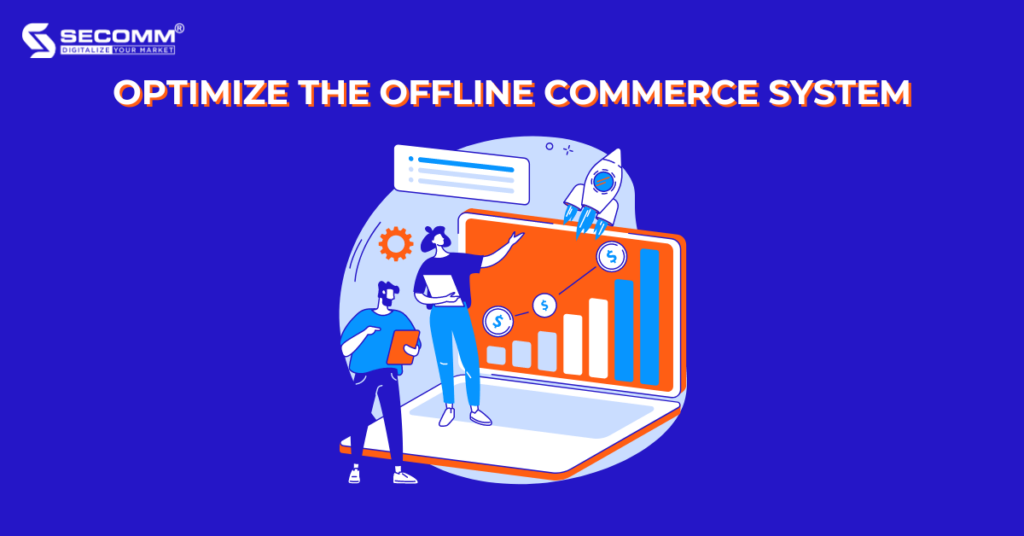
POS (Point of Sale) is where the buying and selling transactions take place. A POS system combines hardware and software to create a complete transaction process. Some popular POS systems include Magestore, mPOS, VNPAY, and KiotViet.
ERP (Enterprise Resource Planning) is software that helps plan and manage all operations of a business. Some world-renowned ERPs include Odoo, Sage, TomERP, Oracle, and SAP.
CRM (Customer Relationship Management) is a software that allows you to manage information and interaction of your existing and prospective customers. CRM helps you to collect, store, and analyze customer data to improve customer interactions and enhance sales capabilities. You can use CRM tools like Salesforce, HubSpot, Zendesk, Zoho, and Pipedrive.
PIM (Product Information Management) is a system used to store and manage your business’s product information in a centralized manner. Product information includes technical specifications, descriptions, images, videos, size and color information, multilingual product descriptions, and other relevant information needed by marketers or sales staff. There are some popular PIM solutions including Pimworks, Salsify, Akeneo, and Inriver.
Depending on the current level of digitization in your offline operations, you can consider upgrading existing systems, transitioning to different platforms, or implementing additional suitable software solutions.
Typically, building the online commerce system including websites, and apps, you can choose between 2 types of platforms: SaaS and Open Source.
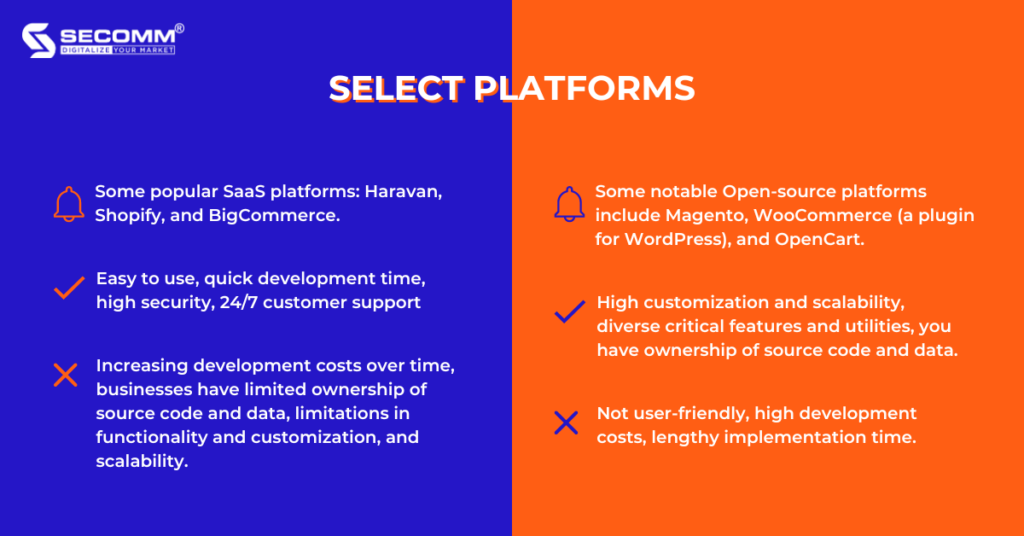
SaaS (Software as a Service) platform is a service delivery model where the website system is provided as software. In this model, data is stored on the provider’s server, and the platform is responsible for handling technical issues for the business.
Some popular SaaS platforms: Haravan, Shopify, and BigCommerce.
The SaaS platform is often a popular choice for startups or SMEs (Small and Medium-sized Enterprises) due to its reasonable cost and implementation time.
The Open Source platform refers to software with publicly available source code that can be used by anyone free of charge. Open-source platforms are the optimal choice for businesses to develop comprehensive websites and apps.
Some notable Open-source platforms include Magento, WooCommerce (a plugin for WordPress), and OpenCart.
The Open-source platform is the perfect choice for enterprise-level businesses requiring complex customization due to its high flexibility and scalability.
In addition, you can also build your store on popular eCommerce marketplaces such as Shopee, Lazada, Tiki, Sendo, and Amazon. Marketplaces give you a great opportunity to reach out to a wide pool of potential customers and increase sales. Moreover, using eCommerce marketplaces helps you save costs on ads, shipping, and customer relationship management (CRM).
To succeed on marketplaces, you will need optimized store pages and an effective strategy. It’s easier said than done, however, relying on eCommerce marketplaces in the long run may result in a loss of control over customers and their data. Marketplaces will have their own policies regarding customer data management and contact information making it difficult for you to directly access their customers and may lose these potential customers to your competition.
Overall, to effectively implement O2O commerce, you can choose to develop an online system alongside your offline system or proceed with it after getting the offline system done.
After choosing the platform to build the O2O e-commerce website and app, you will create the UI/UX design that aligns with your brand’s characteristics.

There are 3 recommended approaches:
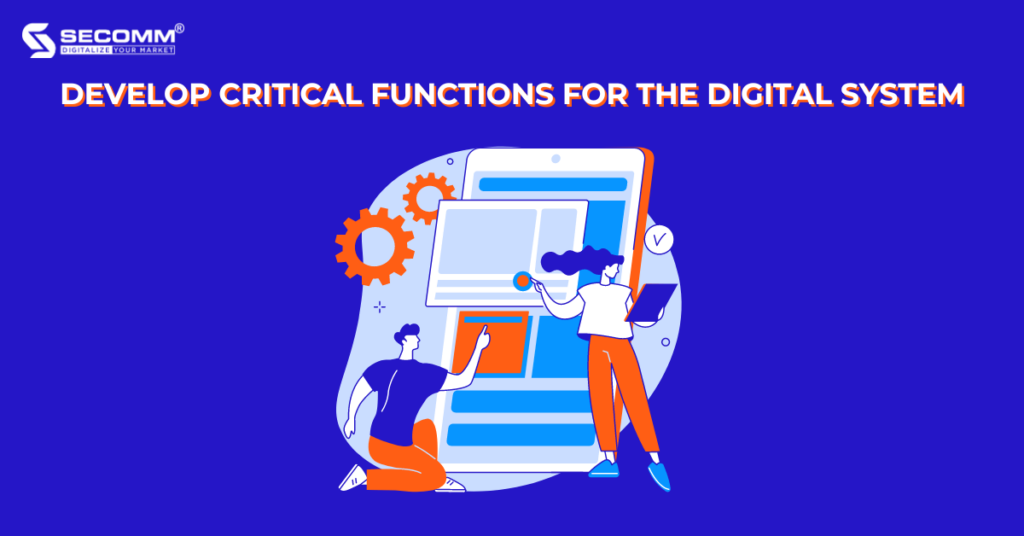
After you’ve done with your design, it’s time to develop some critical functions for both eCommerce website and app implementation. Below are a few suggestions:
Testing serves as a vital undertaking to help you uncover any lurking bugs that may emerge within a website and app, all in the pursuit of aligning the entire system seamlessly with the precise demands of your business. By doing testing, you will not only grant a comprehensive overview of your project but also provide the means to evaluate targets and even proactively manage risks as you navigate the realm of eCommerce.
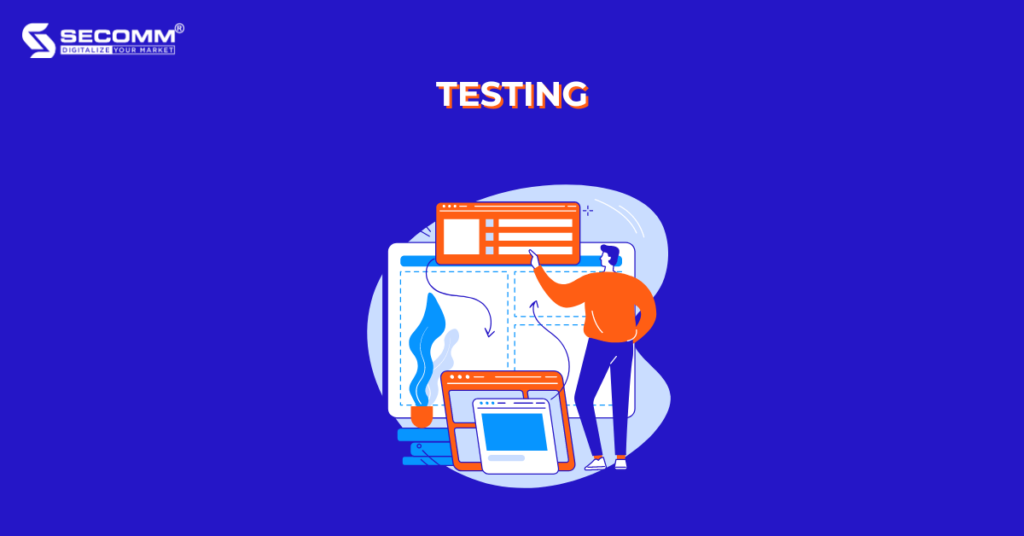
There are several testing methods:
In general, conducting testing based on test scenarios is an important step that helps you ensure quality and provides a solid foundation for a smooth operation.
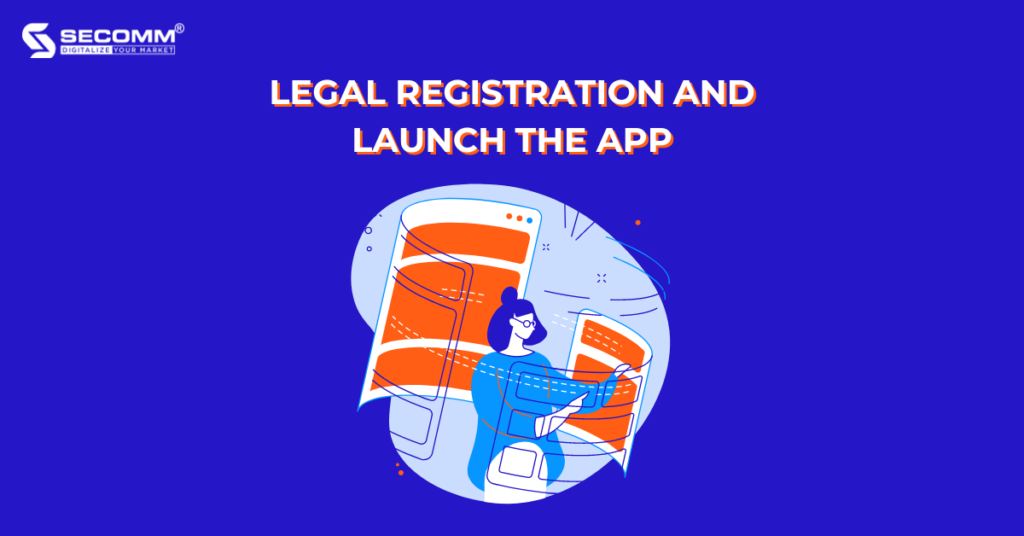
The final step to developing the online capabilities is to complete the legal procedures to make sure your eCommerce operation is legit. You can follow the step-by-step guide in the eCommerce Management Portal.
This is a mandatory requirement set by the Vietnamese Ministry of Industry and Trade for individuals or organizations having online businesses to fulfill their obligation to register/notify within the specified timeframe.
To publish the applications on these platforms, you need to follow these steps:
By pushing the app to Google Play and the App Store, you take one closer step to mobile users.
After facilitating your O2O commerce system, it’s time to take a look at the collected data to measure its performance for further critical decisions. Several tools can be integrated into your business system such as Google Search Console, Google Analytics, Facebook Pixel, TikTok Tracking Pixel, and more.
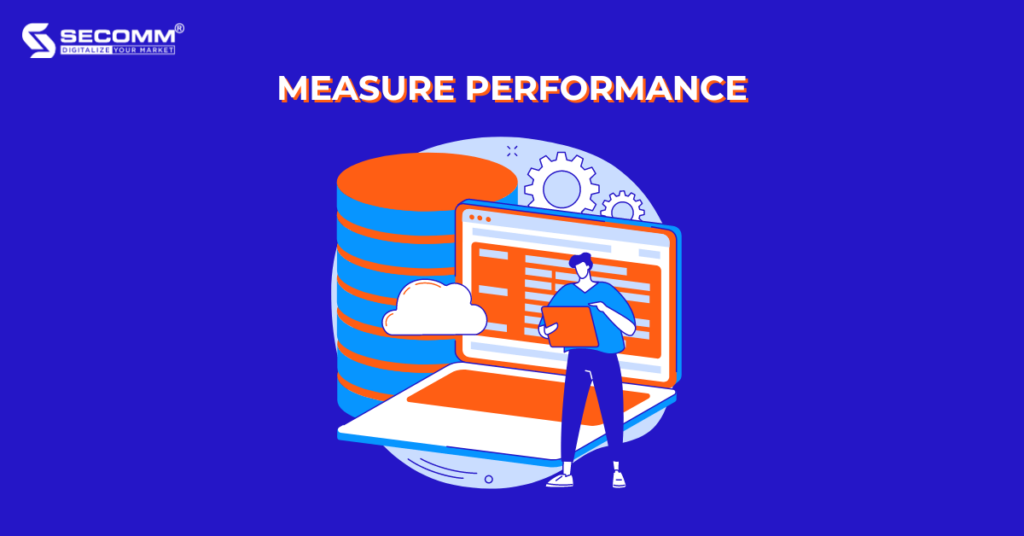
Moreover, you can integrate BI (Business Intelligence) tools, which are intelligent management reporting systems, to gather large amounts of data from various sources and use them to make predictions. Some popular BI tools include Magento Business Intelligence, Tableau, Power BI, and Looker.
Having the analysis and reports in place, you can now develop appropriate strategies to optimize customer experience. Some popular strategies include Loyalty Program and Omnichannel.
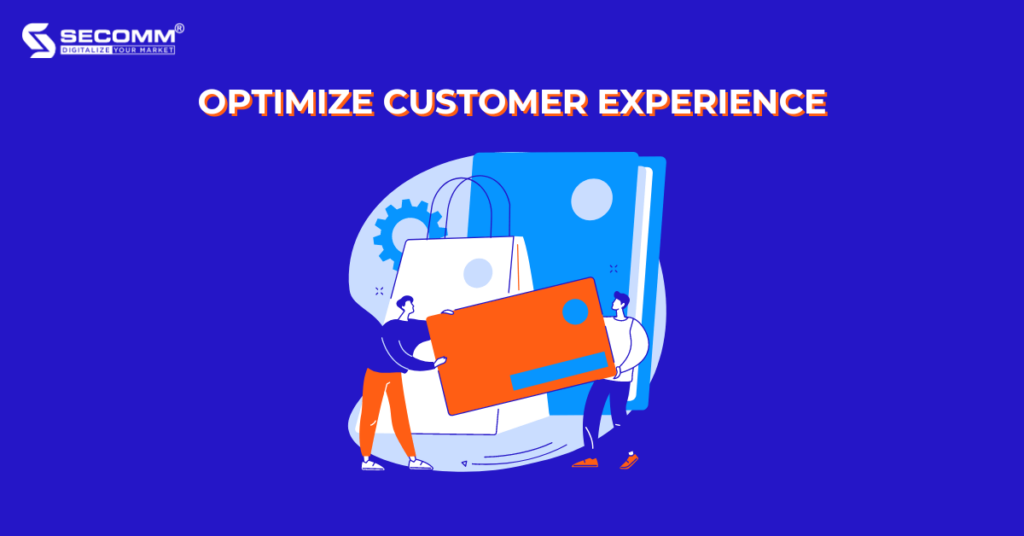
The Loyalty Program is a marketing strategy designed to encourage customers to continue to shop associated with the program. This enriches customer shopping experience and keeps them engaged with your brand.
Omnichannel is a multichannel sales approach that focuses on providing a seamless shopping experience by marketing and selling on all channels where potential customers are present, from mobile devices, social media, and eCommerce websites to brick-and-mortar stores.
Established in 2014, SECOMM is a company specializing in providing O2O commerce solutions. Over the years, SECOMM has accumulated a vast portfolio of O2O commerce projects with large domestic and international clients such as Annam Gourmet, Trentham Estate, and much more.
Regarding O2O commerce solutions, SECOMM offers a diverse range of services to help businesses enhance their competitive capabilities and dominate the retail market in the digital age. These services include Solution Consulting, Team Development, and O2O System Development including:
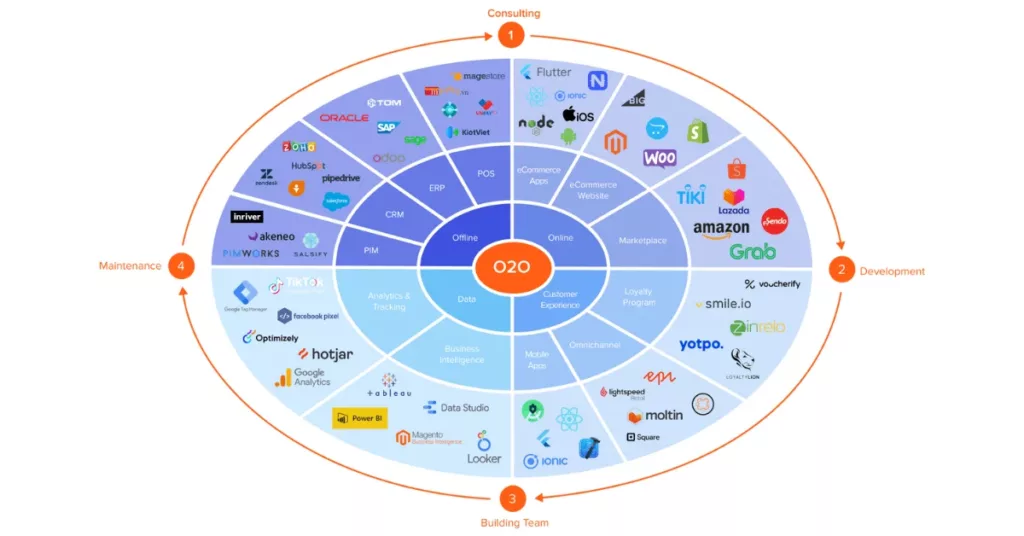
Developing an O2O commerce system to provide a comprehensive experience for customers:
Deploying and integrating management tools and software to efficiently operate business activities for the enterprise.
Building and integrating platforms to support businesses in enhancing customer experience.
Integrating tools to support the analysis and reporting for the business operations.
To learn more about the O2O commerce model as well as the best solutions to conquer the retail market, please contact SECOMM today for a free consultation.
 2
2
 7,110
7,110
 0
0
 1
1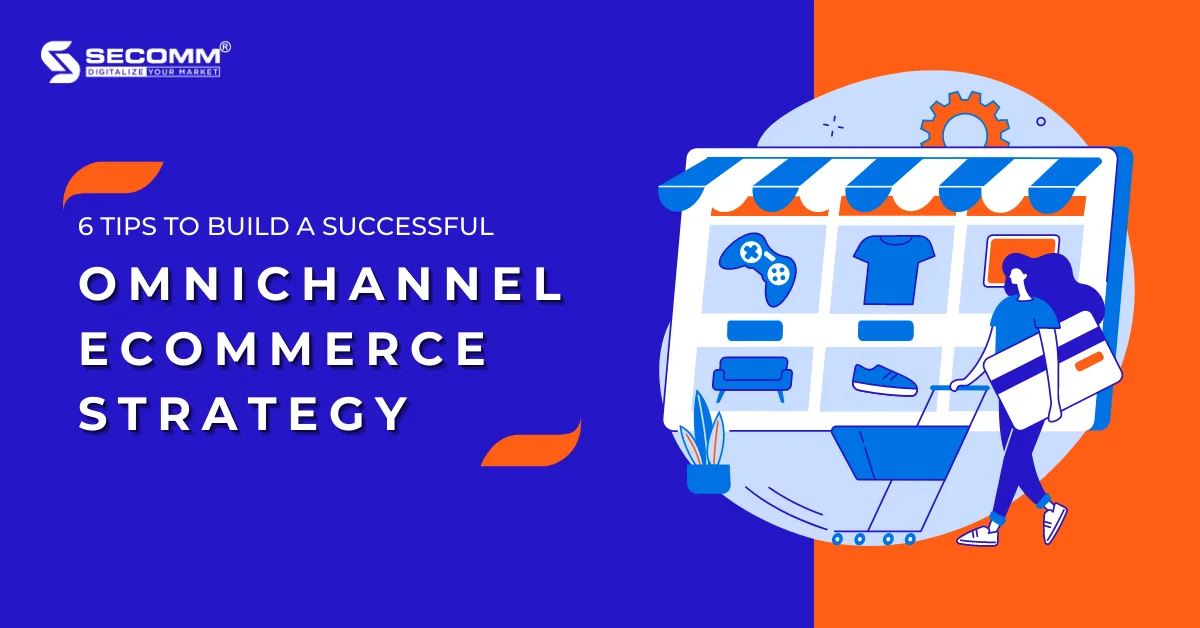
In 2021, The Vietnamese eCommerce market size reached 13.7 billion USD, which means the industry is growing rapidly and playing an important role in Vietnam’s economy.
It forces business owners to find ways to make their businesses stand out and connect with customers.
One of the effective approaches is to implement an Omnichannel eCommerce strategy. This is a marketing method aimed at providing a consistent customer experience across multiple channels. It may be confused with Multichannel eCommerce, where brands sell on various channels but provide different customer experiences on each channel. Although customers can shop on social media, eCommerce websites, physical stores, etc, their experience across these channels could not be seamless. There is also the Single-channel eCommerce model, where a brand only uses one channel for sales.
Retailers globally recognize the potential and impact of Omnichannel eCommerce on their business operations. According to Report Linker, the market for multi-channel retail platforms reached 5 billion USD in 2020 and is projected to reach 14.5 billion USD in 2027. Industry analysts and experts also emphasize that Omnichannel is the future of eCommerce and is a great way to attract customers and provide them with true value.
Here are 6 tips to help you, as a business successfully build an Omnichannel eCommerce strategy.
Tip number 1, regardless of any business strategy, you have to know who your target customers are and their shopping behavior. You can start by gathering relevant data about demographic information, purchase history, etc from various sources, including eCommerce websites, social media platforms, physical stores, etc. Then, you will analyze how they interact with the brand across different channels and create detailed buyer personas.
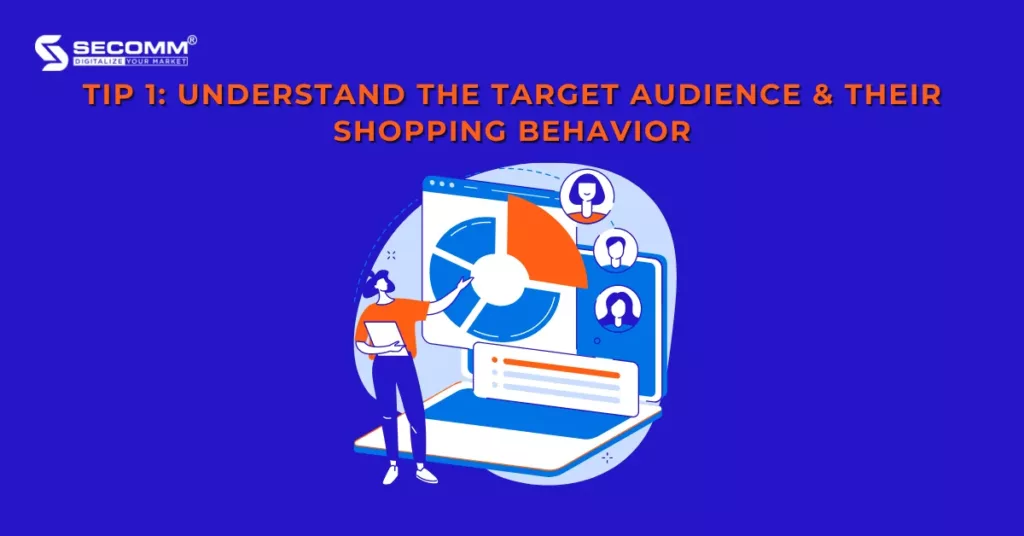
This helps identify effective approaches for each customer segment and tailor messages for each channel. For example, if a significant portion of your customers prefers shopping on mobile devices, you can optimize your suitable marketing campaigns alongside improving the website to attract more customers. Or, you can invest in developing mobile applications to enrich the customer shopping experience and drive conversions.
Tip number 2 is to map out the customer journey to visually understand the process that a potential customer goes through when interacting with your brand. It helps you clearly understand their needs, buying motivations, and so forth. When developing an Omnichannel eCommerce strategy, mapping the customer journey allows you to proactively provide personalized customer experiences across channels. It not only enhances cross-selling, and upselling but also improves customer intention and loyalty.
There are typically 5 stages in the customer journey: Awareness, Interest, Purchase, Retention, and Advocacy.
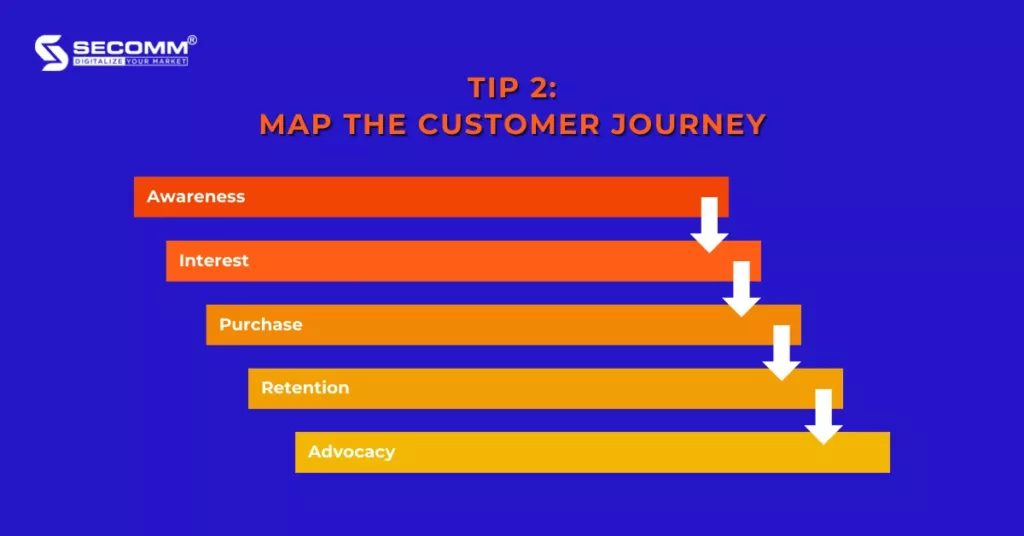
Here are the basic steps to create a customer journey map:
Another valuable tip is to develop a consistent brand message and image across channels. It requires you first to identify and understand the brand values, vision, and mission. For example, you can use consistent elements such as colors, fonts, etc, to help customers easily recognize your brand. Moreover, you need to train your staff on the brand message and image to ensure they understand and communicate the message properly across all channels.
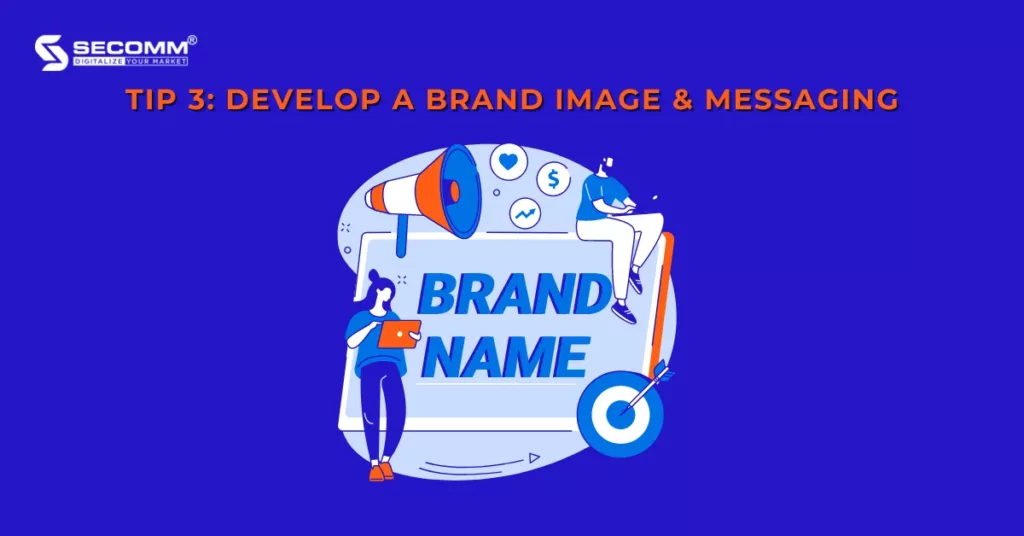
This tip not only helps increase brand recognition and customer loyalty but also creates a seamless customer experience.
Next, you can incorporate social media into your Omnichannel eCommerce strategy and focus on engaging with customers on social media platforms alongside other effective marketing channels. With over 3.6 billion social media users globally, building your brand presence in these places is no longer an option but an imperative measure to effectively connect your brand with customers.
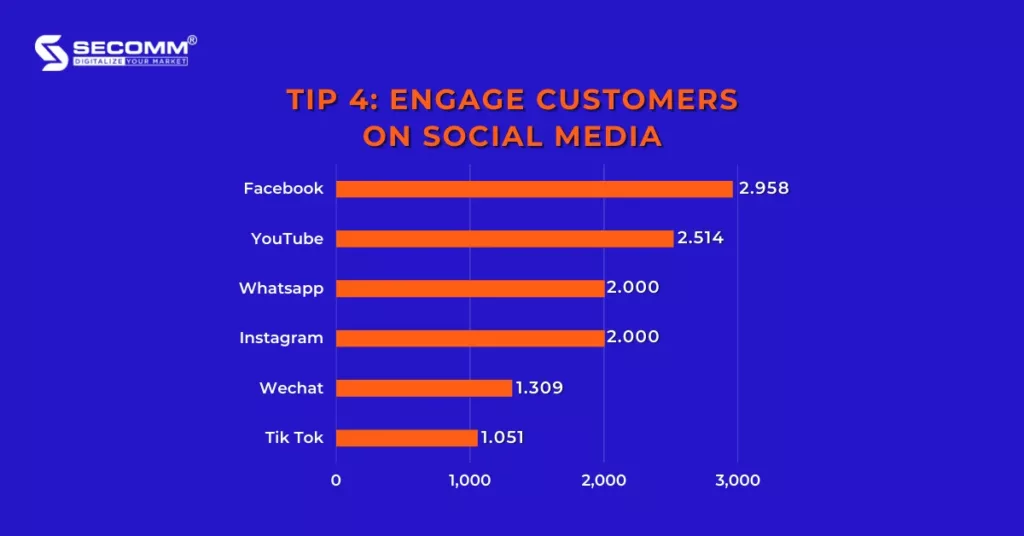
Leveraging social media enables you to engage with customers by responding to inquiries and addressing concerns through messaging or interactions on the news feed in a friendly and approachable manner. In addition, social media provides you with great space to deliver brand messages and voices to customers in a quicker and more intimate way to enhance brand awareness. You can create your own ideas and content or collaborate with influencers.
To tightly integrate social media with other channels in the Omnichannel eCommerce strategy, you can, for example, encourage users to like, comment, and share posts to receive attractive discount codes for purchases on websites or physical stores.
Tip number 5, for a seamless omnichannel experience, you need to ensure that customers can make purchases through any channel they interact with, such as eCommerce websites, marketplaces, social media platforms, and physical stores.
Additionally, to keep up with mobile commerce trends, you should optimize mobile-friendly and responsive websites as well as user-friendly mobile apps for easy navigation and usage.
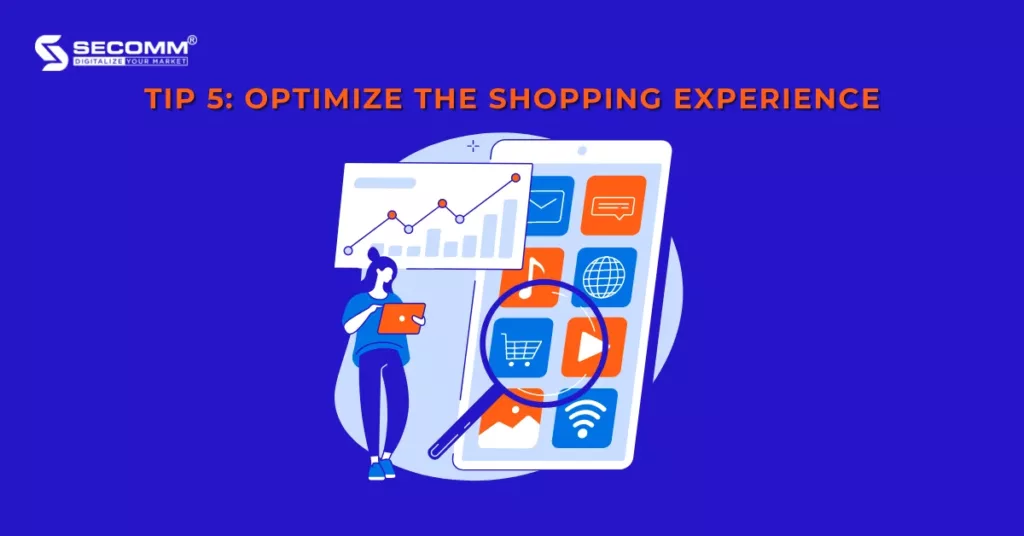
Since Omnichannel eCommerce emphasizes consistent experiences across all channels, content and customer-related information such as login credentials, payment details, and shopping carts should be synchronized. This enables customers to move seamlessly between channels and devices while preserving the items in their shopping carts or without the need to spend time logging in or re-entering payment information. Moreover, you can leverage data analytics to personalize product recommendations for each customer, displaying relevant or complementary products based on their behavior and purchase history across channels to increase cross-selling and upselling opportunities.
Tip number 6 is measuring and analyzing the results of the strategy. During the implementation process, you can utilize data analysis tools such as Google Analytics, Google Tag Manager, Facebook Pixel, and others to check, track and analyze customers across all channels. It helps identify which channels generate the most traffic, level of engagement, and sales revenue, and identify areas for improvement. In addition, you can gather customer feedback to enhance and optimize your strategy. The work should be conducted to make appropriate adjustments and achieve desired results.
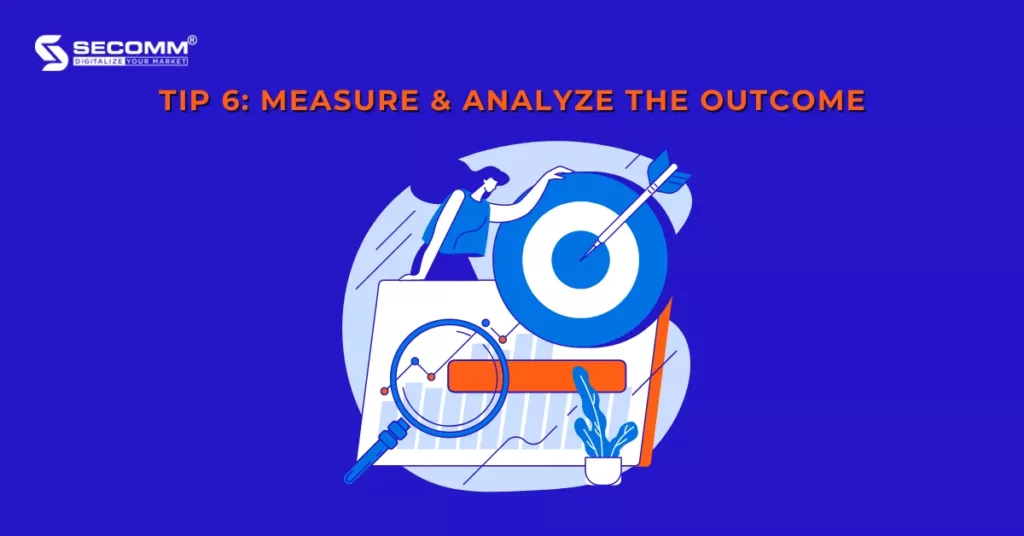
Contact SECOMM now for a consultation on building an Omnichannel eCommerce strategy.
 2
2
 7,134
7,134
 0
0
 1
1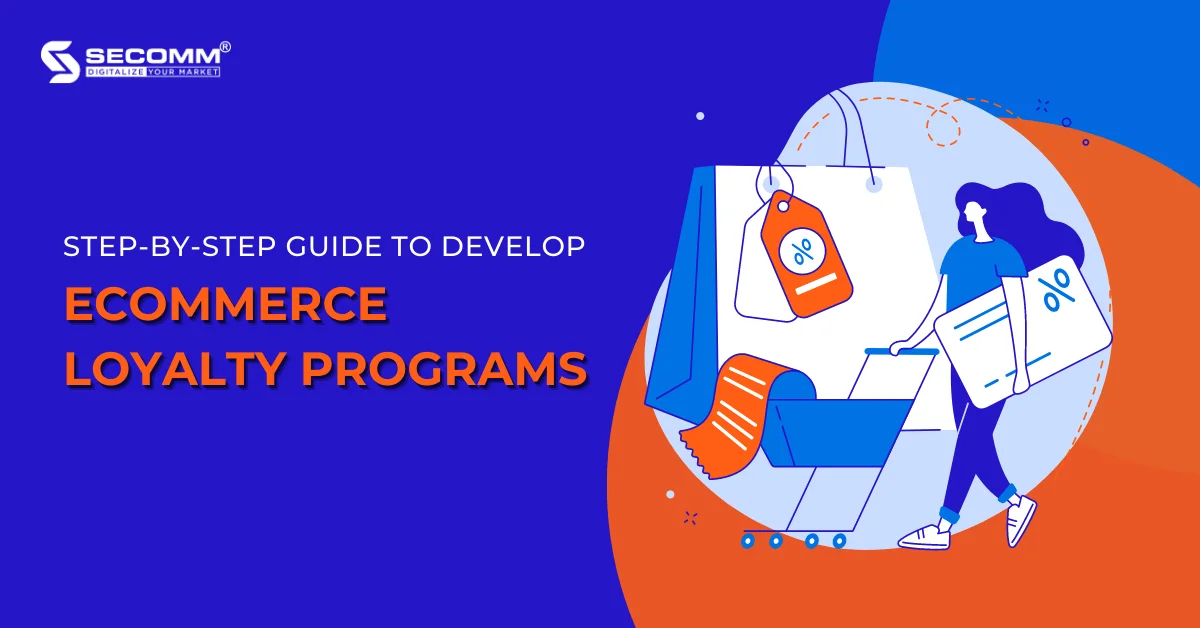
Loyal customers contribute significantly to the profitability and development of eCommerce businesses. Therefore, as a business, you need to focus on strengthening relationships with customers and encouraging repeat purchases. Among the methods available, building and convincing customers to participate in Loyalty Programs is an effective strategy.
Below is the ultimate guide to successfully build and implement an eCommerce Loyalty Program.
Related Readings: Everything To Know About eCommerce Loyalty Programs
The first step of the process is to establish the goals of the eCommerce Loyalty Program, which includes identifying the objectives (e.g. increasing customer retention rates, promoting repeat purchases, attracting new customers, increasing CLV). These objectives should align with the overall development strategy and business goals.
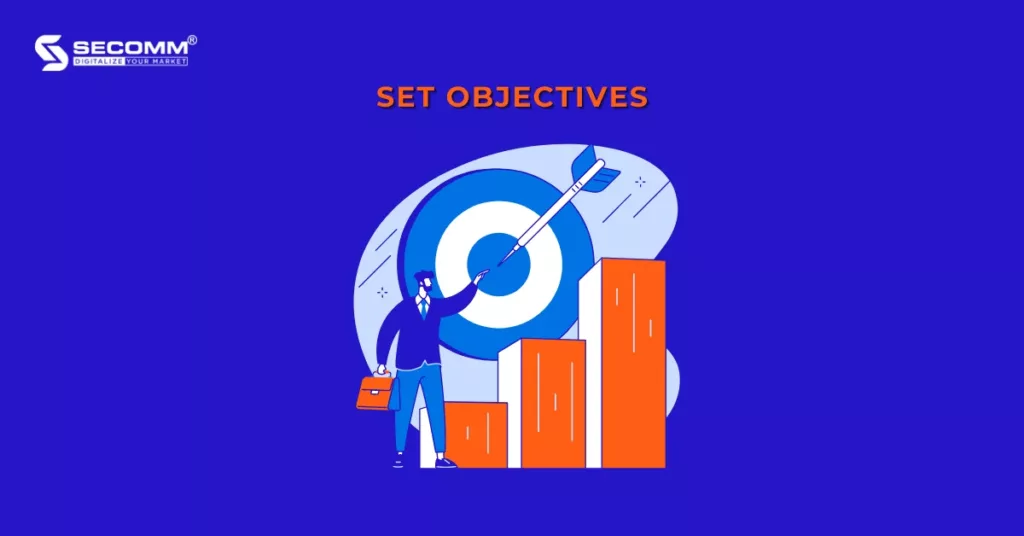
In addition, as a business, you need to clearly define the target audience of the Loyalty Program by analyzing the demographic and psychographic characteristics of those audiences to design a suitable program that meets their expectations.
You also can research the Loyalty Programs of competitors, analyze their strengths and weaknesses, and then create your own program to differentiate your business and provide unique value to customers.
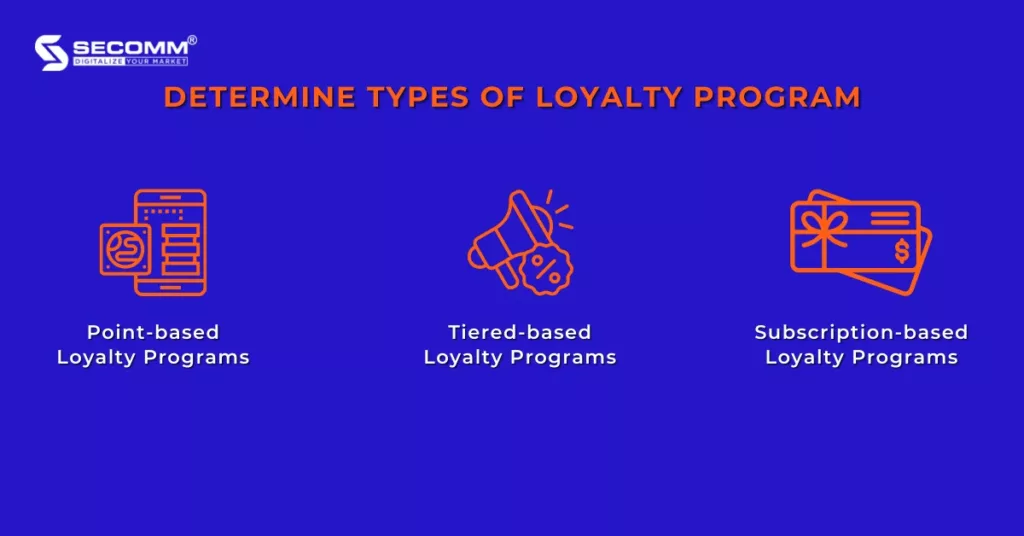
Currently, there are various types of eCommerce Loyalty Programs, but the most popular ones are point-based programs, tiered-based programs, and subscription-based programs.
This allows customers to earn points for each purchase or specific action and redeem them for rewards once they have accumulated a certain number of points. You should pay attention to the value of the rewards customers will receive and the reasonable time to redeem them to make the programs attractive.
This program encourages customers to strive for higher tiers to receive higher-value rewards and benefits. It will require customers to invest their time and money in shopping and engaging with your brand, meaning the more they spend, the more benefits they receive, and the higher their loyalty to your brand.
This Loyalty Program requires customers to register as members and pay a monthly, quarterly, or annual fee, depending on the terms of each program. Because of that, customers are more likely to commit to engaging with the brand, which is higher than other types of programs. Typically, these programs will have a trial period for customers to decide whether or not to join, and this is also an opportunity for you to convince them that the value they will receive is worth every cent.
The choice of Loyalty Program type depends on the budget, resources, and overall strategy of your business.
After choosing the right type of eCommerce Loyalty Program, you will want to select rewards that are suitable for that program. For point-based Loyalty Programs, common rewards include:
The SHEIN Bonus Point Program is a typical point-based Loyalty Program, where customers will earn 1 point for $1 spent. In addition, customers can also earn reward points by taking specific actions such as verifying their accounts, reviewing products, etc. When reaching the required number of points, customers can redeem them for discounts of up to 70%.
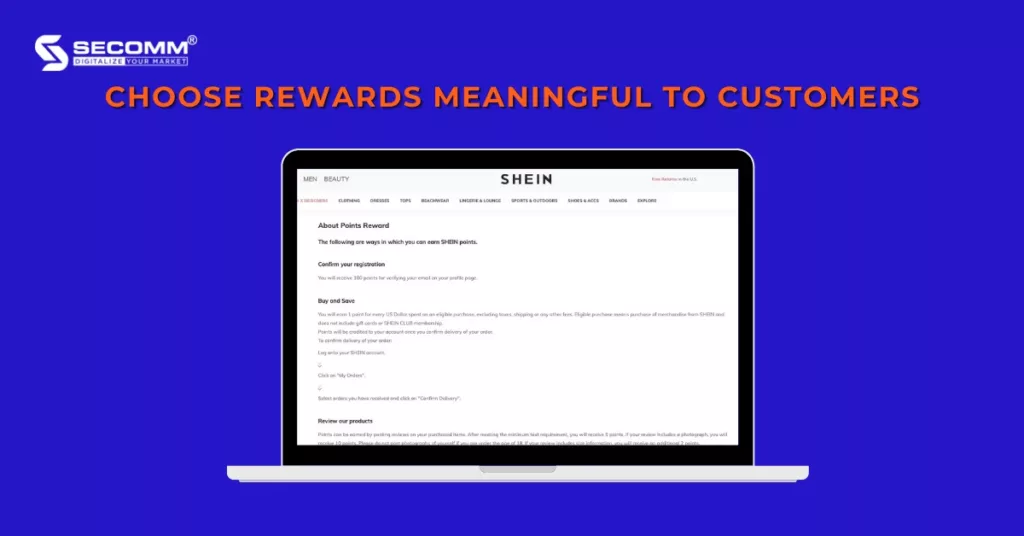
For the type of tiered Loyalty Program, the tiers will determine the equivalent benefits that customers will receive and require effort to maintain or upgrade. Therefore, rewards will be designed to reflect the brand’s characteristics and personalized for each customer at each specific tier. This makes the customer’s efforts worthwhile.
For example, Aldo Crew is a tiered Loyalty Program from the famous fashion brand – Aldo, with 3 main tiers: Crew, Plus, and VIP. The program offers customers attractive and personalized benefits such as special pricing, free birthday gifts, birthday discounts, 20% off handbags when purchasing shoes, exclusive privileges and surprises, and account sharing with friends.
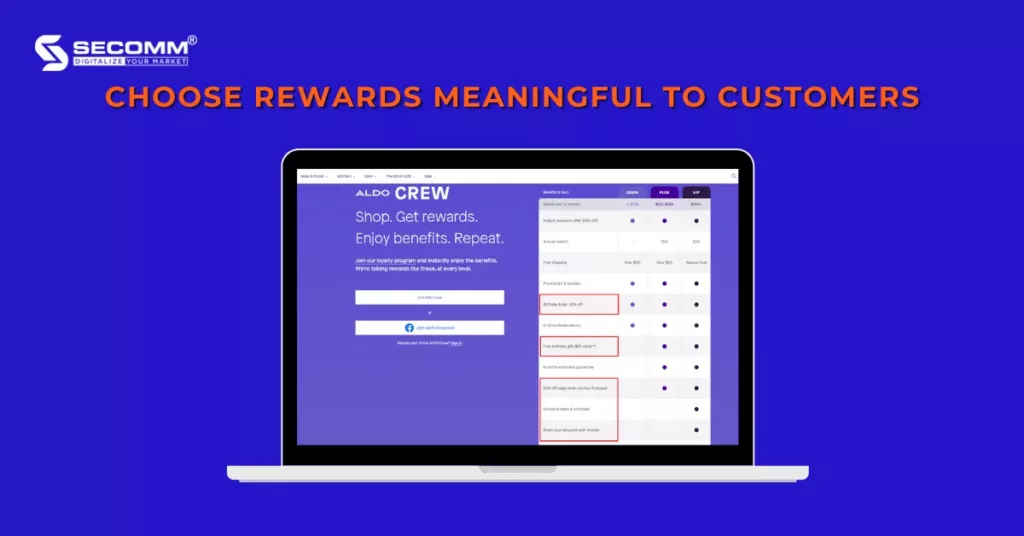
Most membership programs are applied by leading and well-known businesses worldwide due to their credibility, product value, and high-quality service that make customers trust them to spend their money to sign up. The rewards of this type of program tend to be exclusive, only available at the brand and for registered members.
For example, customers who register for the Walmart+ membership program will receive benefits such as product discounts, shipping policies, gas service, and movie watching with Paramount+ that non-members cannot receive.
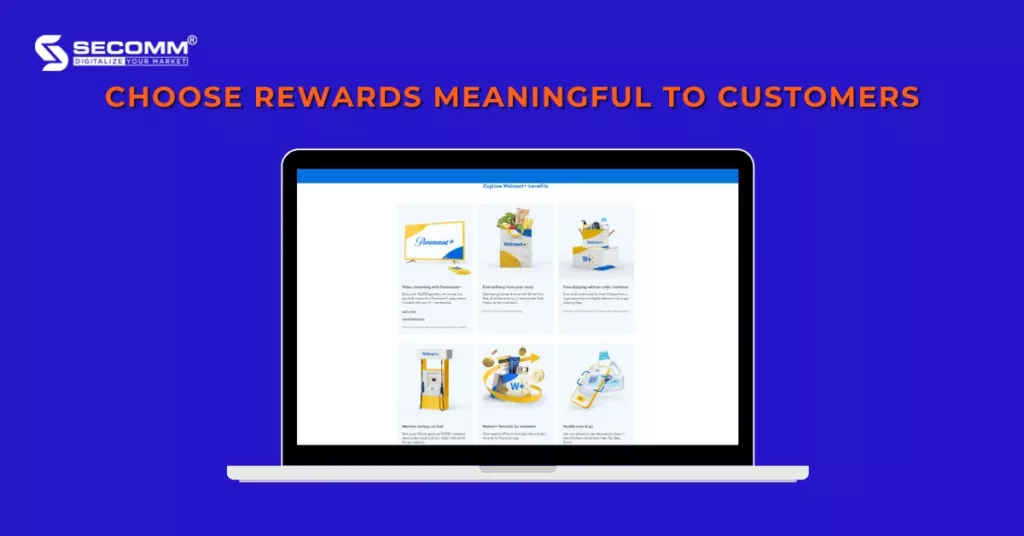
Depending on what Loyalty Program you choose, you will select rewards that are appropriate for both your customers and your business. However, you should consider the cost of each reward as well as the benefits it brings to the business before applying it to the program. Providing valuable rewards can not only increase customer retention and loyalty but also boost sales and increase the CLV.
Next, you will need software to develop, and manage eCommerce Loyalty Programs, track customer activities, and distribute rewards. The choice will be based on some factors such as ease of use, integration with eCommerce websites, and the price of the software. There are some popular Loyalty Program software on the market today, including Smile.io, Loyalty Lion, Yotpo, S Loyalty, and so forth. These softwares can be easily integrated and work effectively with eCommerce platforms such as Magento, Shopify, WooCommerce, etc.
The next step is to design the rules of the program. You need to ensure that the rules and conditions for participation are presented clearly, easy to understand, and easy to follow.
For example, the Sephora Beauty Insider program is based on a tiered system where customers earn one point for every dollar they spend, and the conditions for participation and advancement are clearly presented.
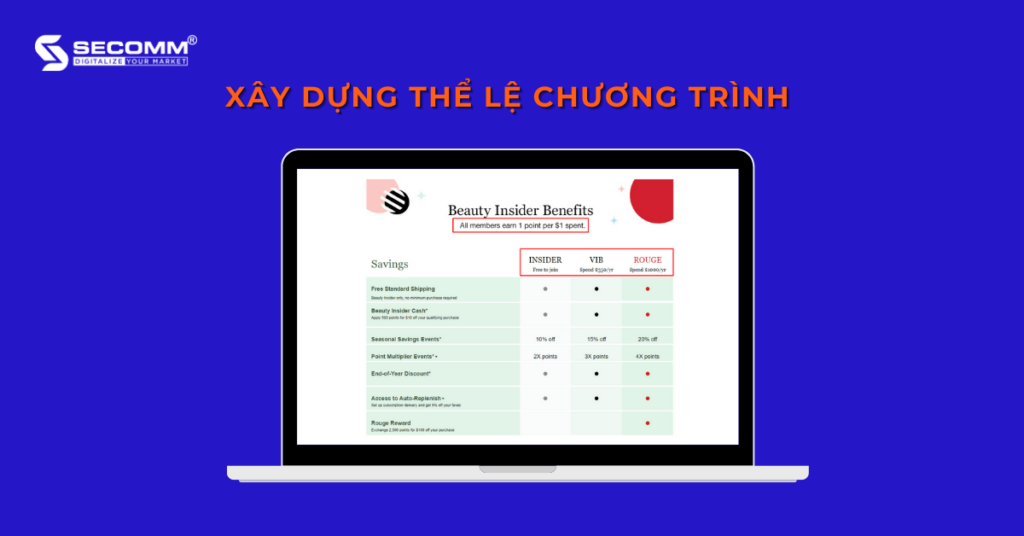
Again, with Walmart+ as an example, customers easily recognize the benefits they will receive for joining the program as a member, and the cost of $12.95/month after a 30-day trial as well.
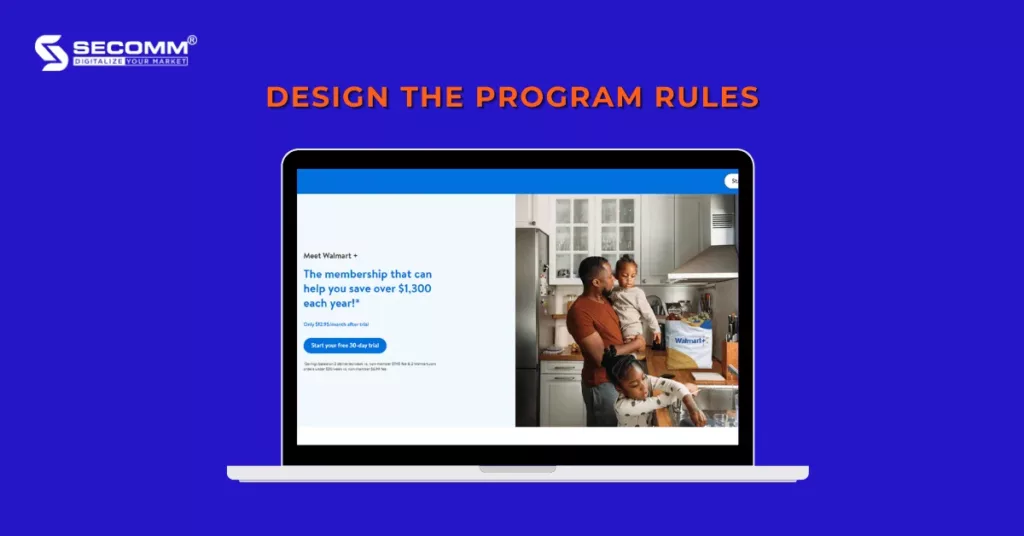
In addition, the registration process should be easy to execute. Typically, brands will require customers to create an account on their website or fill out a registration form, or even simpler, just log in with Facebook to participate. These actions are quick and easy to execute.
For example, in the Sephora Beauty Insider program, customers can click “join now”, fill out the form, and join the Insider tier. Or, if they already have an account, they need to log in to see their points balance and tier.
For the Aldo Crew program, customers need to fill out a registration form on the website or log in with their Facebook account to start.
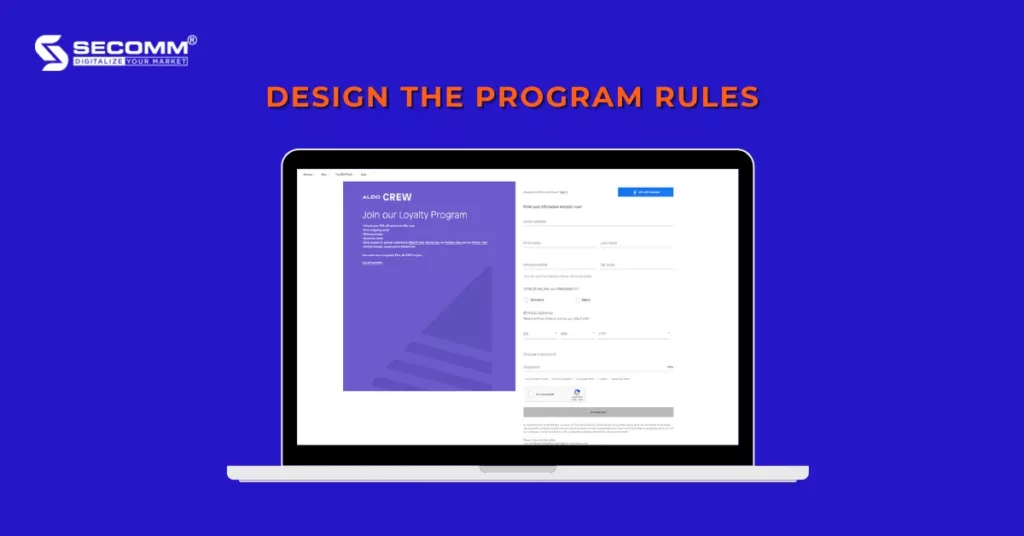
In addition to ensuring the clarity and understandability of the program rules, you also want to ensure that the conditions set are appropriate for customers to quickly earn rewards and maintain the attractiveness of the program, while also bringing profits to the business.
For example, the Amazon Prime membership program offers customers a 30-day free trial and a range of pricing options. The most noteworthy are the monthly payment plan at $14.99/month and the annual payment plan at $139/year. The majority of customers are likely to choose the annual payment plan ($139) to save money, which is also Amazon’s intention as the profits they earn will be higher.
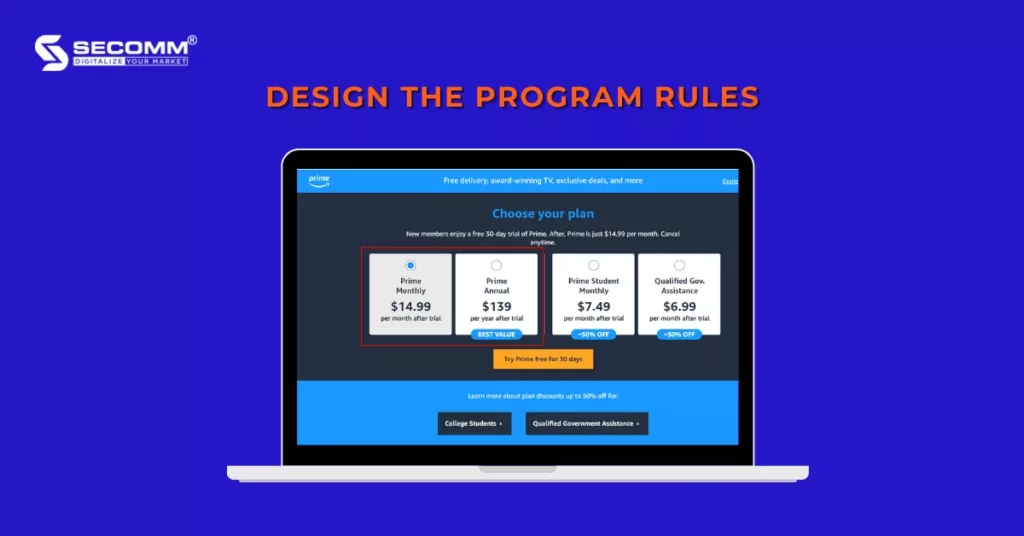
To implement a Loyalty Program, you will need to integrate the program into your eCommerce website and display the point balance and rewards on the Shopping cart page.
Taking Sephora as an example again, the Profile page displays the customer’s current membership tier and current point balance.
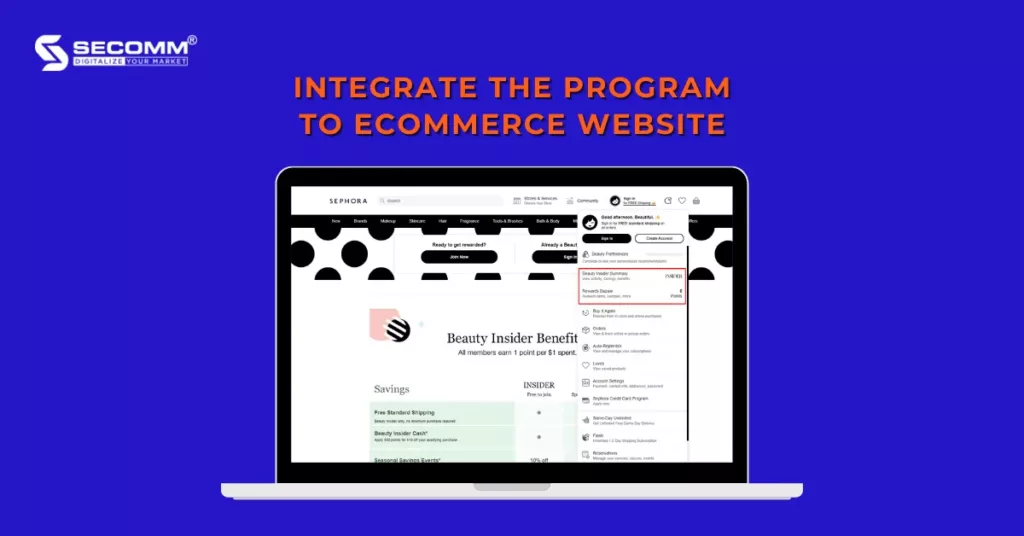
For the success of your eCommerce Loyalty Program, you have to educate your team about the program, including participation requirements, point accumulation methods, rewards, and more.
Moreover, you want to ensure that your team knows how to answer customer questions about the program and handle any arising issues. This activity should be done regularly along with the changing of your Loyalty Program to fit market trends.
By providing effective training, your team is able to promote and manage the program accordingly. This contributes to the success of your eCommerce Loyalty Program.
When launching your Loyalty Program, you will want to make it popular so promotion is necessary. To do it effectively, you can prominently display the program on the Homepage and Navigation menu of your website. Also, you can promote the program on social media or use eye-catching graphics and compelling content for email marketing.
An Influencer marketing campaign is an effective way to increase the program’s awareness and engagement. Referral Marketing is also a commonly used marketing strategy in Loyalty Programs today, encouraging customers to refer new members to the program to expand the customer base.
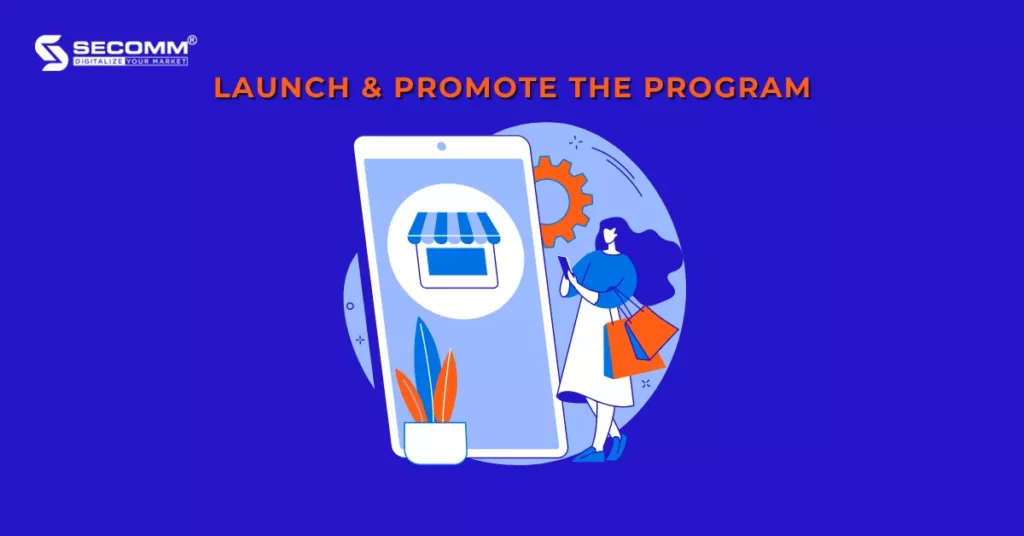
Popular Loyalty Programs such as Sephora Beauty Insider, Amazon Prime, Walmart+, Aldo Crew, and eBay Plus all have referral programs. When someone signs up for the Loyalty Program through a referral link, both the referrer and the referee will receive a small bonus of $1-$10 or a discount on their next purchase.
You will need to track and measure the results of the Loyalty Program to ensure the objectives are achieved and make adjustments if necessary.
You can use KPIs like customer retention rate, repeat purchase rate, or average order value of members compared to non-members. Moreover, you can collect and analyze customer feedback and reviews on their satisfaction with the program to identify what to improve.
You also need to keep your customers engaged by regularly improving, updating, and promoting the program. At the same time, you should provide personalized rewards and experiences based on their interests and behavior to increase customer satisfaction and interaction.
In addition, you can consider building a community of members by providing online and offline events and special offers exclusively for program members. Again, Sephora does this well, they offer exclusive events for all Insider, VIB, and Rouge members in addition to other incredible experiences. This gradually creates a community of loyal Sephora customers who love beauty.
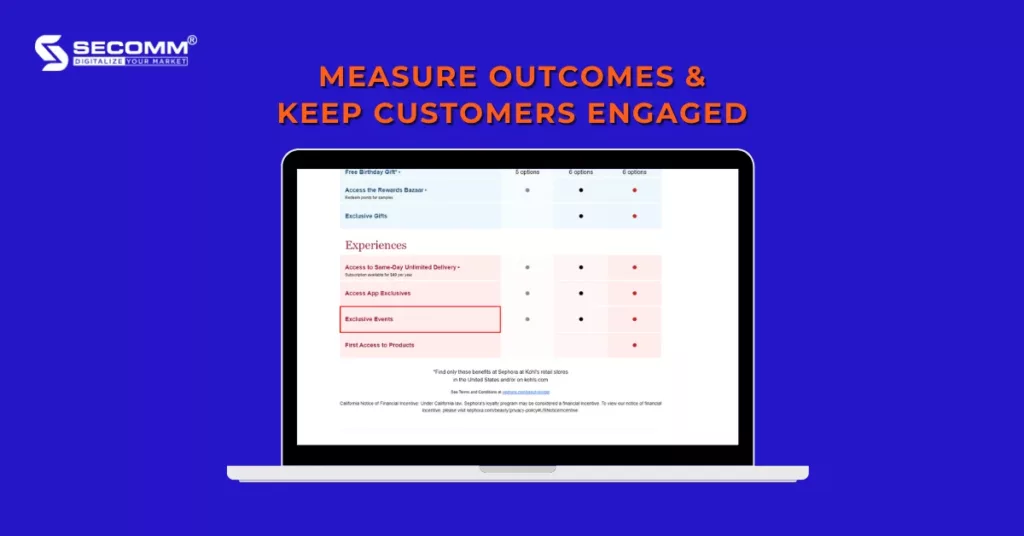
Retention isn’t about convincing customers who were going to leave to stick around. Instead, retention is about providing so much value to your existing customers that they never go anywhere else and become your strongest benefit.
Therefore, enhancing your customer experience through attractive Loyalty Programs is an effective way to increase customer retention and loyalty.
Contact SECOMM now for a free consultation on developing a comprehensive eCommerce Loyalty Program.
 2
2
 14,236
14,236
 0
0
 1
1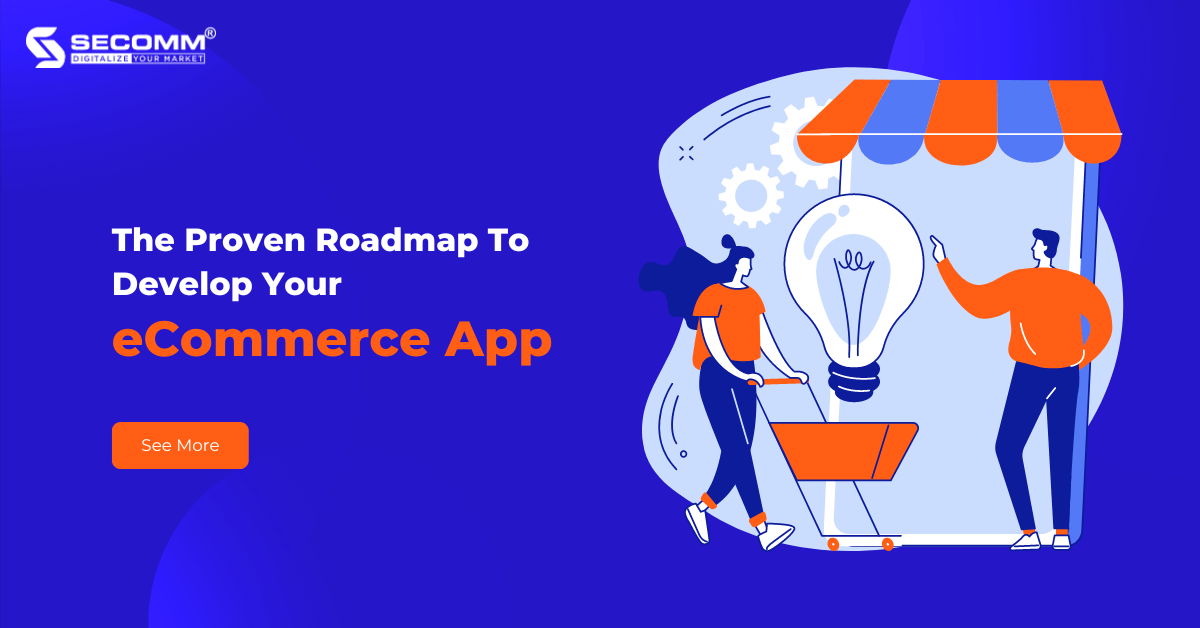
Facing the boom of Mobile Commerce, businesses now have two choices: to build an eCommerce app to adapt to this boom or to ignore it and gradually fall behind.
According to Insider Intelligence’s forecast, mobile commerce market sales will reach $534.18 billion in 2024, of which two devices contributing to this incredible number are smartphones and tablets. Smartphones alone account for 87.2% of mobile commerce sales. These figures are the most convincing answer to the above consideration: Yes, businesses need to build an eCommerce app.
Building an eCommerce app requires a lot of effort and serious work because it is a complex process with many stages and the involvement of many relevant. Below are 8 summarized implementation steps that will help businesses understand the building process of a mobile shopping app to make their business operation more effective.
The first step of the process is to determine the objective of the mobile app, including deciding which products will be sold through the app and identifying the target audience. This way, businesses can build an app that meets their needs and quickly achieves the objective.
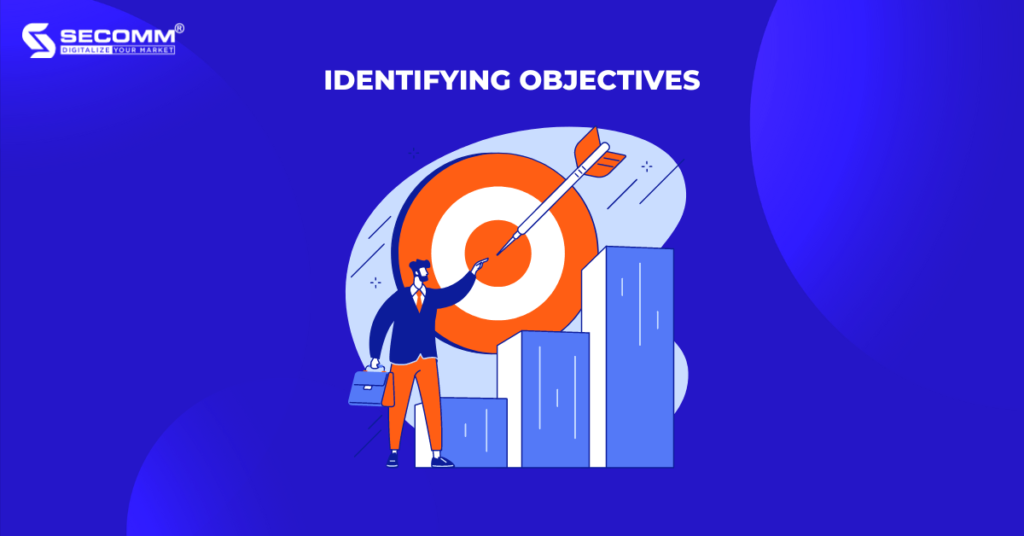
Businesses should do market research to understand their target audience’s needs, preferences, and behaviors in various ways, such as through surveys, interviews, etc. It helps them define the app’s features and the marketing strategies to promote it. Moreover, businesses should find the app’s unique selling points that differentiate it from its competitors, making it easy to attract potential customers and stand out.
After identifying the objectives, the business proceeds to the next step: identifying the vital features of the eCommerce app. Here are some recommendations:
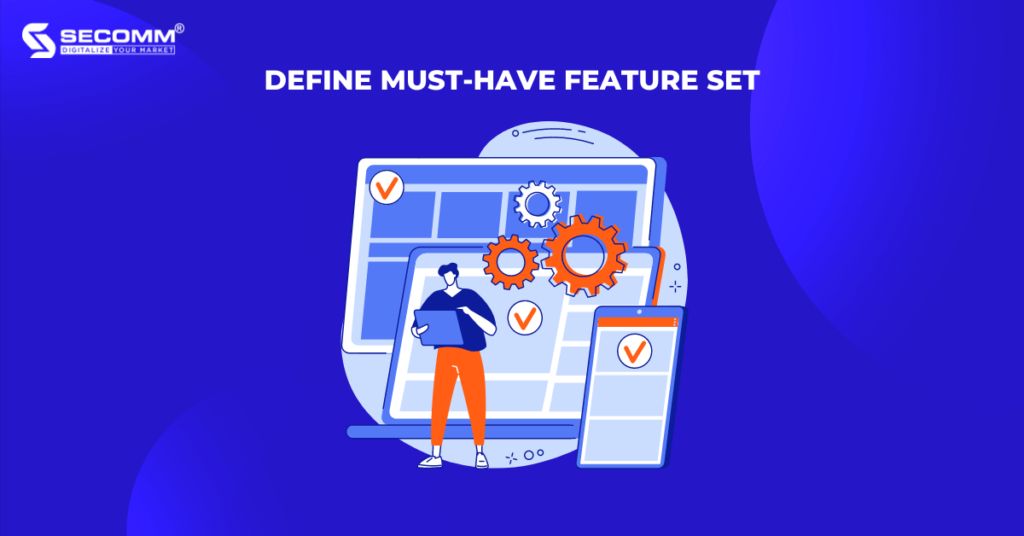
The selection of a platform for building an eCommerce app depends on many factors, including target customers, budget, development stage, necessary features, expansion needs, etc. iOS and Android are two popular platforms in today’s market. In most cases, businesses will build eCommerce apps on both platforms. However, those with limited resources, start with one platform first and then expand to the other later.
Additionally, if a business is targeting customers in the European and North American markets, iOS would be the right choice because iOS dominates these markets. However, because Android has a superior market share in Asia, businesses with plans to penetrate the Asian market should consider choosing Android.
Any business looking to build an eCommerce app will have to choose between a Native app and a Hybrid app. Developing a Native app refers to building a specific app for a specific platform (iOS & Android), using the respective programming languages of the platform – Swift/Objective-C for iOS and Java/Kotlin for Android. Native apps can provide great performance and user experience as they are optimized for the specific platform the app is built on. However, building Native apps can be costly and time-consuming.
Developing a Hybrid app involves building a single app that works on both iOS and Android platforms, using web technologies like HTML, CSS, and JavaScript. Hybrid apps can speed up the development cycle and be less expensive in terms of budget and time compared to native apps. However, Hybrid apps cannot provide the same performance and user experience as Native apps.
Therefore, the choice between developing a Native app or a Hybrid app depends on the budget, development process, and the desired user experience. If the business has a surplus budget to invest in user experience, then developing a Native app is a good choice. However, if the business needs to bring its eCommerce app to the market quickly but has budget constraints, then it should focus on developing a Hybrid app.
Related Reading: Native App & Hybrid App: Key Differences, Pros & Cons
In the next step, businesses decide whether to use an in-house team or collaborate with a specialized agency, which depends on the budget, experience, expertise, and resources. Below are some pros and cons of the two options: In-housing and Outsourcing.
Pros:
Cons:
Pros:
Cons:
The UI/UX design of an eCommerce app refers to creating a visually appealing and user-friendly interface to help users easily search for and purchase products. Here are some suggestions for businesses to consider when designing the UI/UX for eCommerce apps:

In eCommerce app development, MVP stands for Minimum Viable Product, which is typically a condensed version of the app that is launched to the market before the official launch of the full app. Building an MVP for an eCommerce app usually focuses on developing the core features and ensuring those features work effectively before adding additional features.
As listed, the most crucial core features may include a product catalog, search bar, shopping cart, payment methods, etc. When releasing an MVP, the business must ensure that it is error-free and meets the needs of the target customers. The goal of an MVP is to understand the customer’s thoughts on the product, minimize risk, and allocate resources effectively before launching the full product to the market.
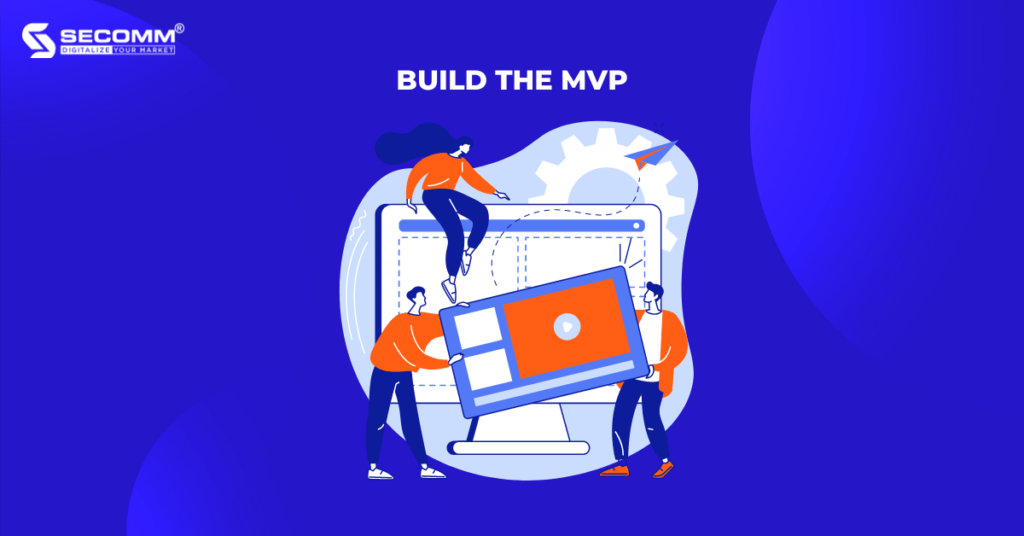
After building and releasing the MVP, businesses should collect feedback from users through various channels such as social media, surveys, or reviews on the App Store or Google Play to gather their opinions on the experience when using the eCommerce app. Moreover, businesses should carefully review the feedback and use it to make decisions about how to improve the app. In particular, they should prioritize the most important issues users are facing and resolve them quickly.
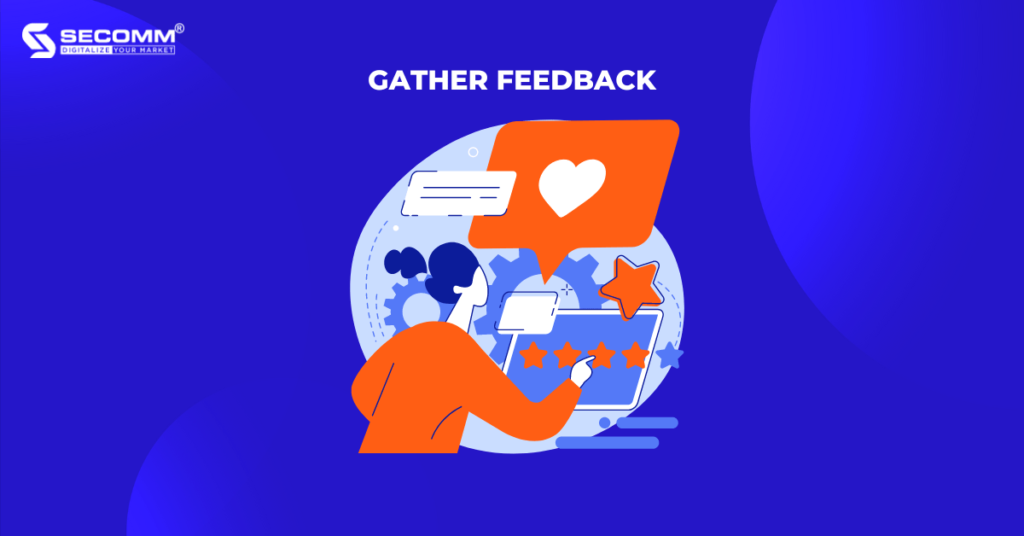
After gathering and reviewing user feedback, businesses can will refine the app and conduct a second round of testing to ensure the app performs well and the improvements have enhanced the user experience. Once the refining and second round of testing is done, businesses can release the product to the market and run marketing campaigns to reach target customers. However, the business needs to closely monitor the performance of the eCommerce app and regularly collect feedback from customers while continuously improving to meet the ever-changing demand of users and maintain a competitive advantage in the market.
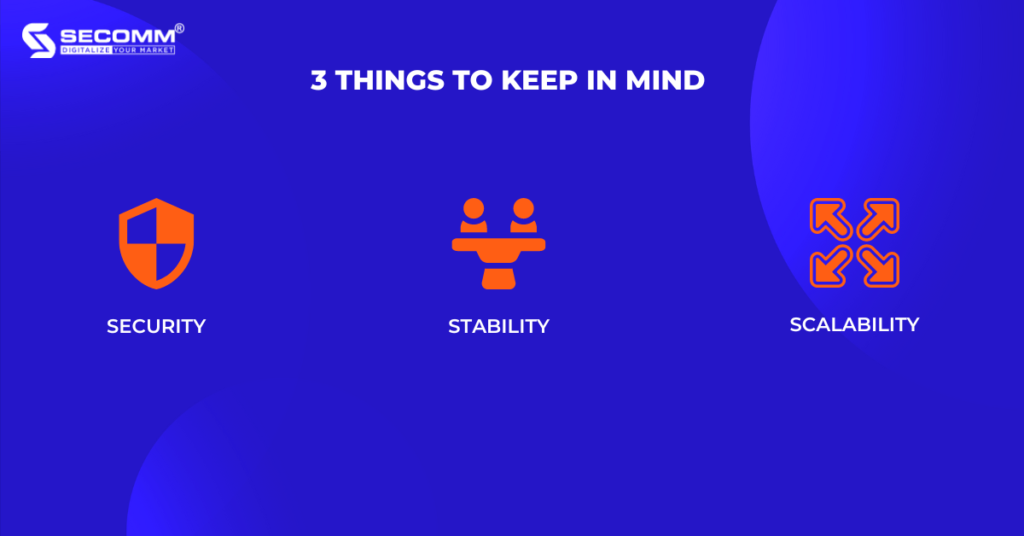
It is a top priority factor that businesses should put their minds to when building an eCommerce application. When users download, register an account, and start using the app, their private data such as login information, personal information, and payment information will be stored on the system. Therefore, businesses should comply with general regulations related to security issues and provide customer information as well as deploy secure payment gateways, and use SSL encryption or two-factor authentication to protect user data of the eCommerce app.
The stability and reliability of an eCommerce app are crucial for a business to provide an incredible user experience. Customers typically prefer apps that run smoothly without any bugs or errors. However, releasing a flawless eCommerce app without any bugs is unrealistic. Therefore, businesses need to conduct thorough testing to identify and fix any issues before launching, while also regularly maintaining and updating the app to improve its performance and prevent or correct any errors that may arise.
This is the ability of an eCommerce app to handle increasing traffic, user volume, and shopping transactions without affecting the performance or functionality of the app. When getting started, businesses should predict the app’s future growth and place to build an app that is easily scalable when necessary. Moreover, businesses need to plan for the addition of advanced features to meet expansion needs.
In summary, security, stability, and scalability are three factors to consider when building an eCommerce app. By focusing on these three factors, businesses can provide customers with a safe, reliable, and scalable app that corresponds to the development of the business.
Above is the general process of 8 steps for building an eCommerce app with some important notes during the implementation. With years of experience implementing eCommerce for businesses from many countries, SECOMM understands the difficulties businesses will face when implementing eCommerce apps.
Contact us today for a free consultation.
 2
2
 2,714
2,714
 1
1
 1
1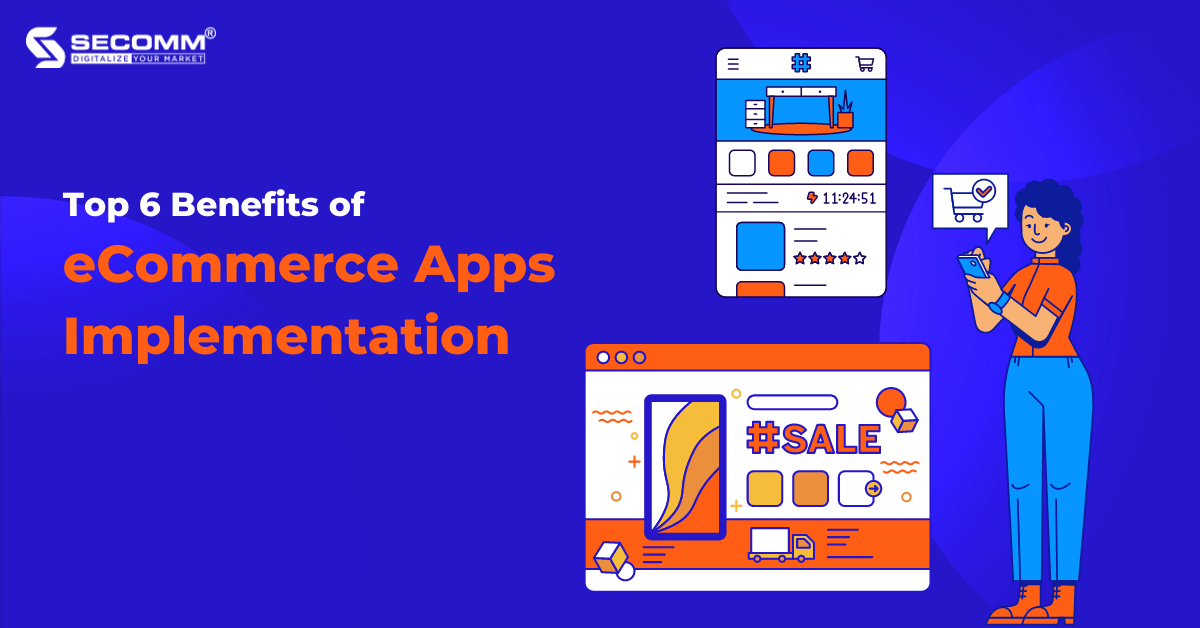
According to data compiled by Forbes Advisor, global Mobile Commerce sales reached $415 billion in 2022 and are expected to reach $710 billion in 2025.
In fact, Mobile Commerce dominates the eCommerce industry, accounting for about 73%, and the use of eCommerce app is growing faster than any other type of app on the market, with an annual growth rate of 54%. This shows that eCommerce app contribute significantly to sales on mobile devices and implementing mobile app is considered the right path for every business in the mobile commerce era.
Increasing brand awareness is one of the benefits that eCommerce app bring to businesses. Since most customers spend hours on mobile devices (e.g smartphones), it’s easier for brands to connect with them through eCommerce app. However, to fully leverage the other capabilities of mobile app, brands need to provide a rich and high-quality app experience. As Statista has noted, about 32%-34% of app users will uninstall if the app is difficult to use or has too many unwanted ads.
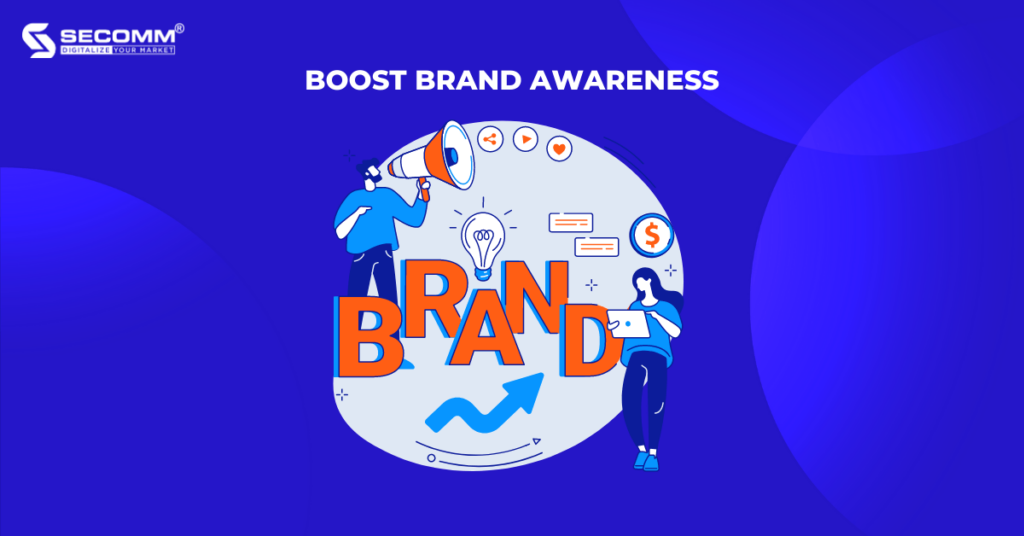
eCommerce websites help deliver personalized shopping experiences with algorithms and support tools but eCommerce apps enable businesses to offer personalized special incentives or promotional programs right in the app without having to access the websites via browsers on desktop or mobile. As a result, among various methods, business owners can combine push notifications, and instead of sending the same push notification to all app users, they can send personalized notifications based on user behavior.
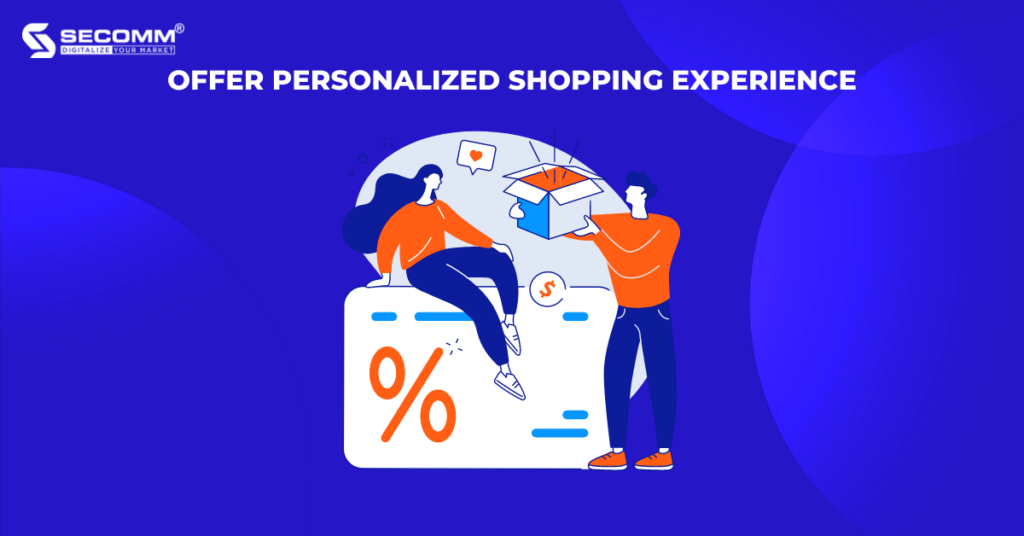
As mentioned, customers tend to love and prioritize shopping on eCommerce mobile app instead of eCommerce mobile web. Therefore, the conversion rate of the mobile app will be higher than that of the mobile web. The graph below indicates the different conversion rates between the mobile app and mobile web.
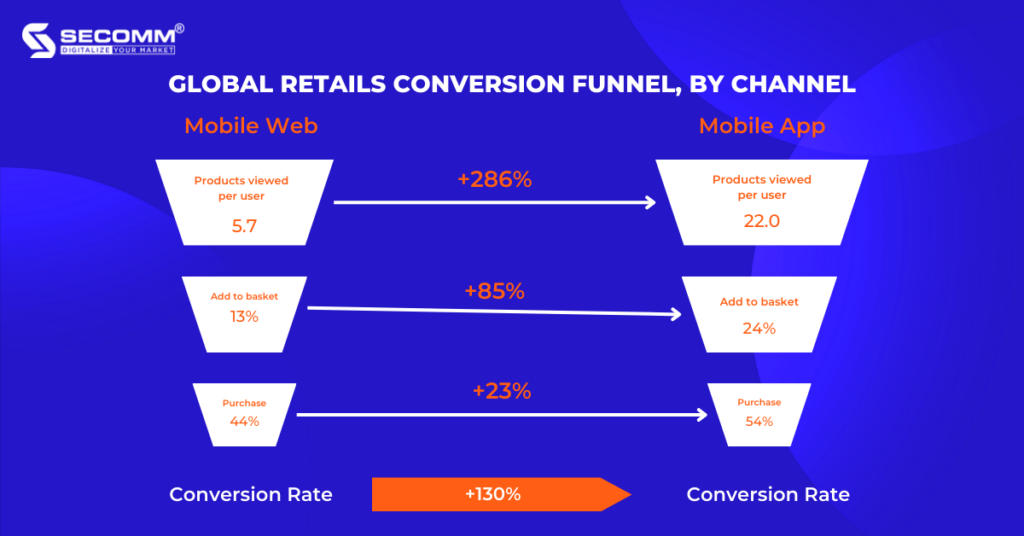
Mobile app users view products more than 286% and add items to the cart at a higher rate of 85% compared to mobile web users. Moreover, the graph shows that the conversion rate of mobile app is over 130% higher than that of the mobile web. Naturally, when the conversion rate increases, it will lead to an increase in sales revenue and profits.
Building an eCommerce app not only boosts brand awareness, enhances customer experience, and improves conversion rate but also increases the average order value (AOV). This is the average dollar amount customers spend each time an order is placed on the app.
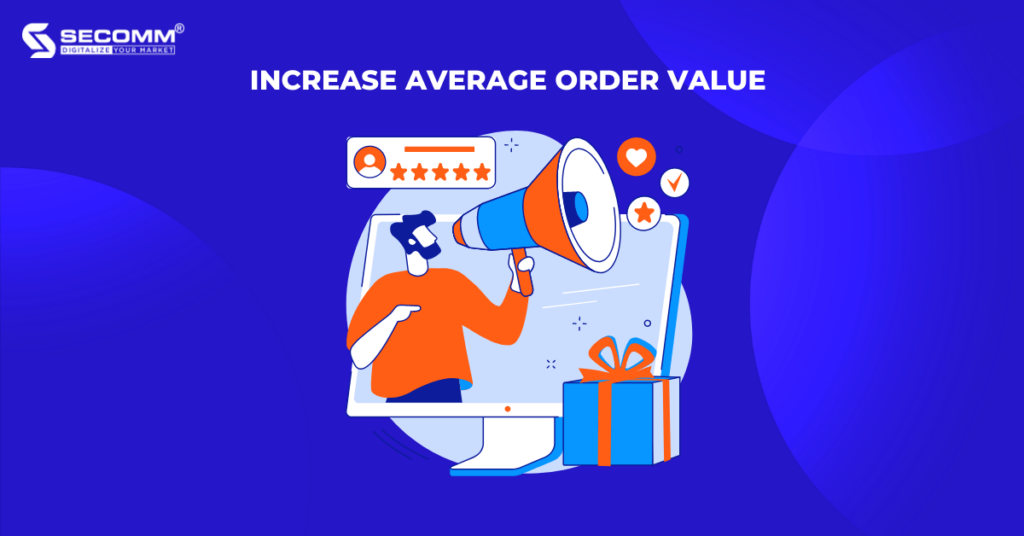
Customers prefer shopping on eCommerce app because it’s convenient for them to browse through products and make purchases. Therefore, they have more opportunities to browse through a wider range of products. This enables businesses to apply cross-selling and upselling techniques, suggesting complementary products to encourage customers to make additional purchases. As a result, the increased AOV drives up revenue and profits.
Some data on cart abandonment has been reported by Ruby Garage:
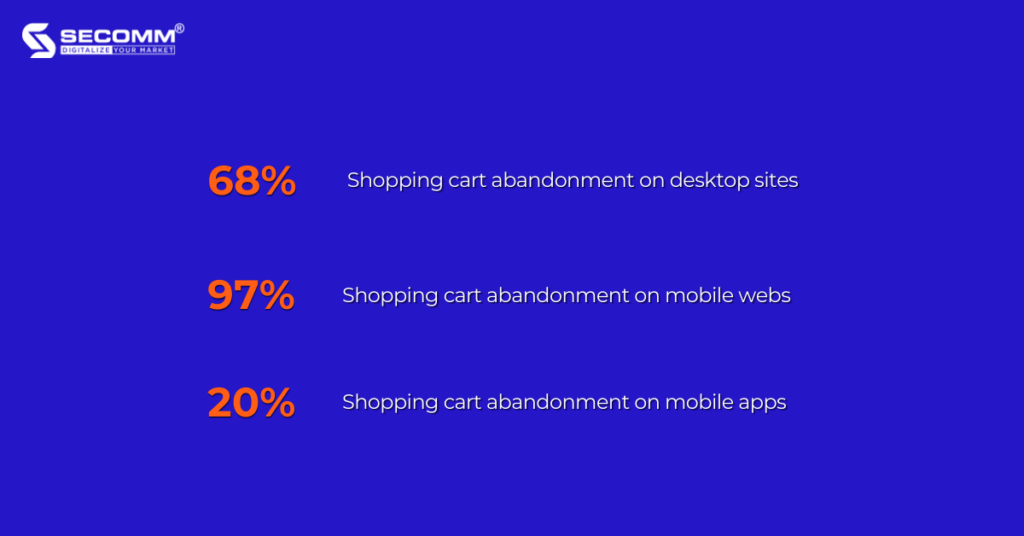
One of the top reasons for that is the long and confusing checkout process. Mobile shopping app will help businesses reduce cart abandonment with the optimized checkout process. When customers buy products, relevant information will be stored in the app’s system, so they don’t have to re-enter their information but complete the purchase with a few taps. In addition, businesses can also shorten the checkout process to improve cart abandonment rates by integrating various payment methods into the shopping app.
For every eCommerce business, increasing sales revenue is a valuable achievement. However, it’s crucial to point out how many regular customers contribute to this success. According to the Harvard Business Review, the cost of acquiring a new customer is more expensive than retaining and satisfying an existing one, ranging from 5-25 times higher. But, if the customer retention rate increases by just 5%, profits can increase from 5% to 95%. As a result, businesses need to put their minds to existing customers.
There is a 50% chance that customers will return to a shopping app within 30 days of their last purchase. In other words, businesses can increase customer retention and loyalty with their mobile app in several ways, including
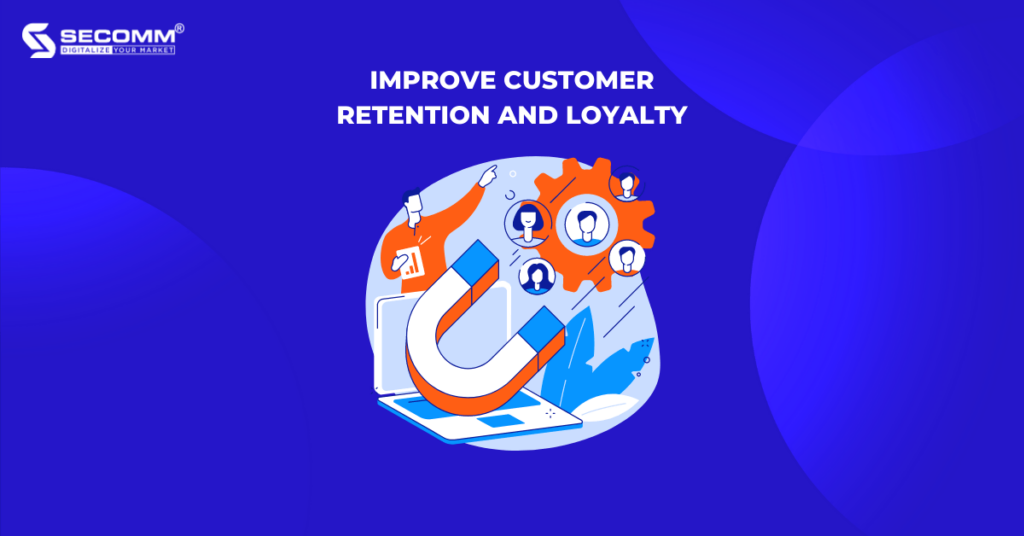
With the incredible benefits of mobile app, businesses are increasingly motivated to quickly build their app to enrich the customer shopping experience while capturing the Mobile Commerce trend.
With years of experience in implementing eCommerce for many businesses in many countries, SECOMM understands the difficulties and obstacles in developing your mobile shopping app.
Contact us today for free advice.
 2
2
 1,672
1,672
 0
0
 1
1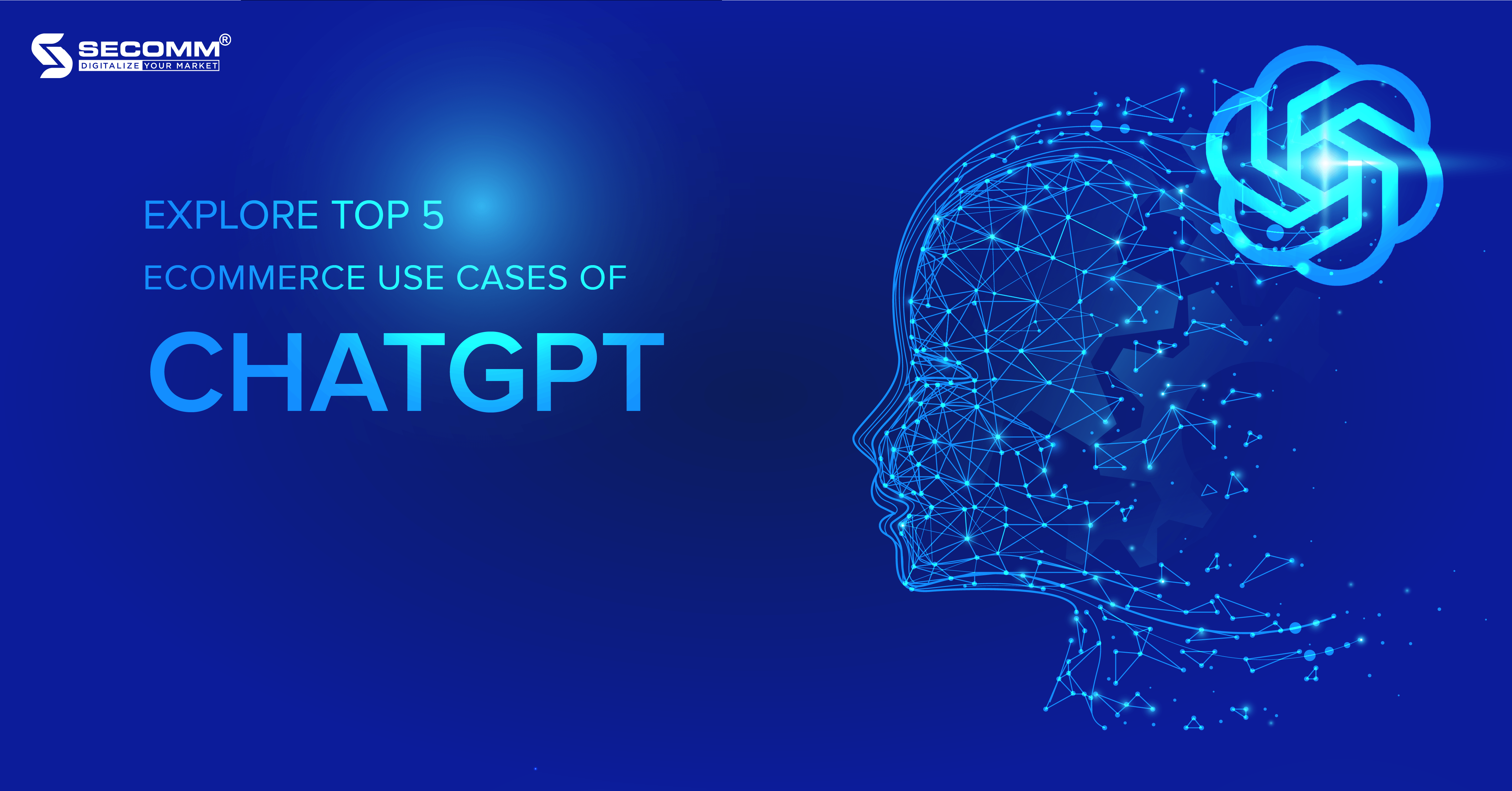
ChatGPT is a new popular AI-powered tool. With the ability to generate human-like text, ChatGPT has a variety of applications in healthcare, education, entertainment, and even in the eCommerce world.
In this article, we will share the top 5 use cases of ChatGPT that business owners can leverage to accelerate their eCommerce.
ChatGPT (Chat Generative Pre-training Transformer) is a large-scale language generation model developed by an AI company called Open AI, which was formed in 2015. ChatGPT is regarded as one of the most advanced language models available today since it can produce human-like text. It can be used for a variety of tasks, including answering questions, creating essays, emails, poems, and even programming.

You can simply use ChatGPT by visiting OpenAI’s website to create an account. Once you’ve logged into your OpenAI account, on the ChatGPT side of the website, you need to read through and accept ChatGPT terms. Then, you can start your conversation with it by asking questions.
Because it is still in the research and feedback-collection stage, it is free to use. But as of February 1, 2023, the OpenAI company launched a new version of ChatGPT Plus in the US for $20/month, while keeping the free version.
ChatGPT runs in a language modeling architecture called Generative Pre-training Transformer (GPT), specifically GPT-3. This type of AI model is trained on vast amounts of information from the Internet, including websites, books, articles, and so forth.
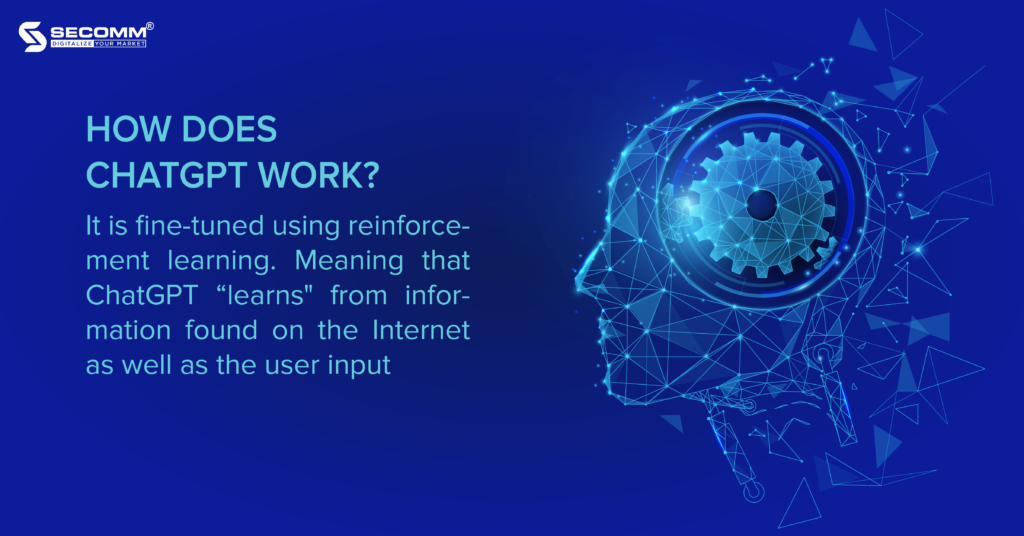
It is fine-tuned using reinforcement learning. Meaning that ChatGPT “learns” from information found on the Internet as well as the user input. Due to Reinforcement Learning from Human Feedback (RLHF), ChatGPT is unique.
RLHF enables human AI trainers to build conversation models in which humans act as both users and AI assistants, according to OpenAI. That helps ChatGPT learn new information rapidly and grow more intelligent.
ChatGPT is a language model to generate conversation with the end users, whereas Search Engines index web pages on the Internet to help users find what they desire. ChatGPT can understand and respond to input information quickly. But, it does not search on the Internet for the information, instead, it uses the training data to generate a response.
Another difference is that ChatGPT’s information update speed is still slower than that of search engines. Some search engines like Google can access the latest information but ChatGPT can only access data up to September 2021. Thus if you ask ChatGPT who is Miss Vietnam 2022, it would not be able to answer while Google could give you an immediate answer in just 0.6 seconds.
Using ChatGPT helps increase revenue and enhance eCommerce business operational effectiveness. Here are 5 great ways to use ChatGPT in eCommerce.
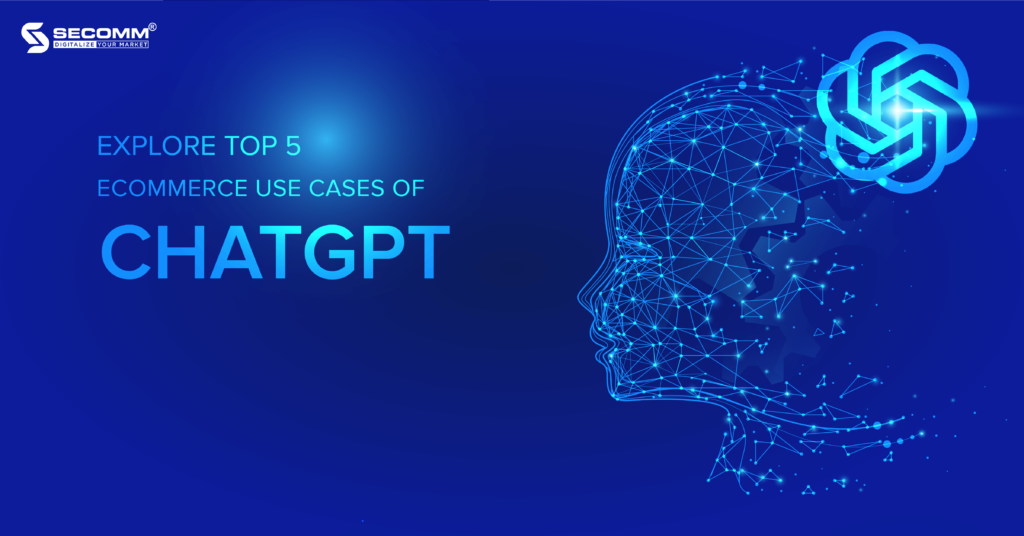
Because an eCommerce website has different product categories, writing a unique description for each product takes a lot of time and resources. ChatGPT can be used to automatically generate compelling product descriptions. This can save time and effort for business owners while still providing customers with high-quality information about the products. Moreover, this language model can create SEO-optimized descriptions that improve product visuality.
For example, a fashion retail brand has launched a new sportswear collection. ChatGPT will generate descriptions focused on moisture-wicking, comfortable fit, and the full range of motion and flexibility. It not only informs customers about the technical aspect of the product but also encourages them to shop with compelling and persuasive words.
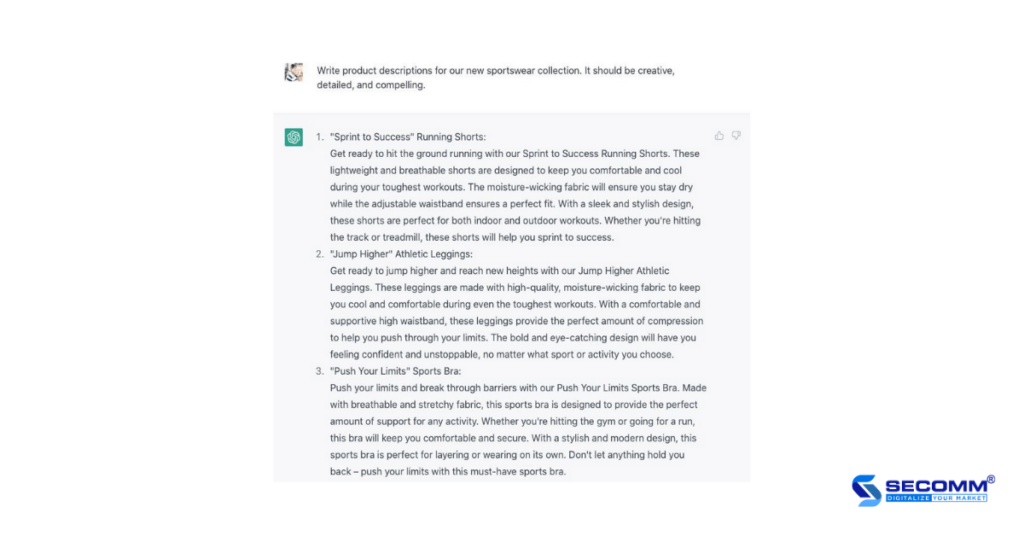
ChatGPT còn được các doanh nghiệp thương mại điện tử sử dụng trong việc đưa ra đề xuất cá nhân hoá sản phẩm. Bằng cách sử dụng dữ liệu khách hàng và lịch sử duyệt web, ChatGPT có thể đưa ra các đề xuất sản phẩm phù hợp cho từng khách hàng cụ thể.
Ví dụ: Gần đây có một khách hàng tên Mỹ đã mua một chiếc áo thun thể thao tại cửa hàng, doanh nghiệp có thể sử dụng ChatGPT để đưa ra đề xuất sản phẩm tương tự mà khách hàng này có thể quan tâm. Từ việc gợi ý sản phẩm phù hợp và cá nhân hoá có thể giúp tăng mức độ tương tác và doanh số bán hàng.
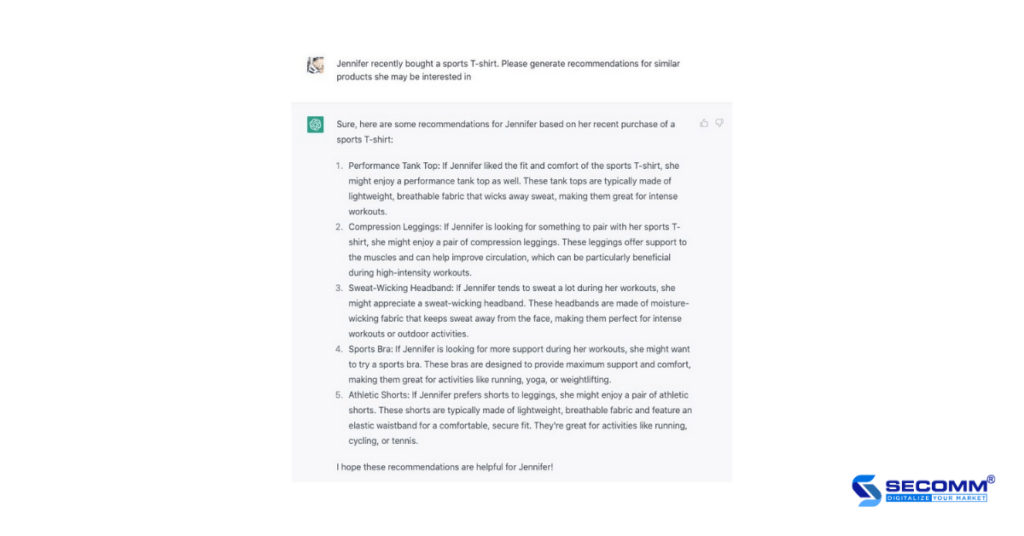
Another way to use ChatGPT is to generate engaging social media content.
For example, a company can use ChatGPT to generate promotional posts on social media platforms to introduce features and benefits of products engagingly and excitingly. Posts can include a caption, image, or video to highlight the advantages of that product. By leveraging the power of ChatGPT, businesses can promote their products and reach new customers on social networking sites effectively.
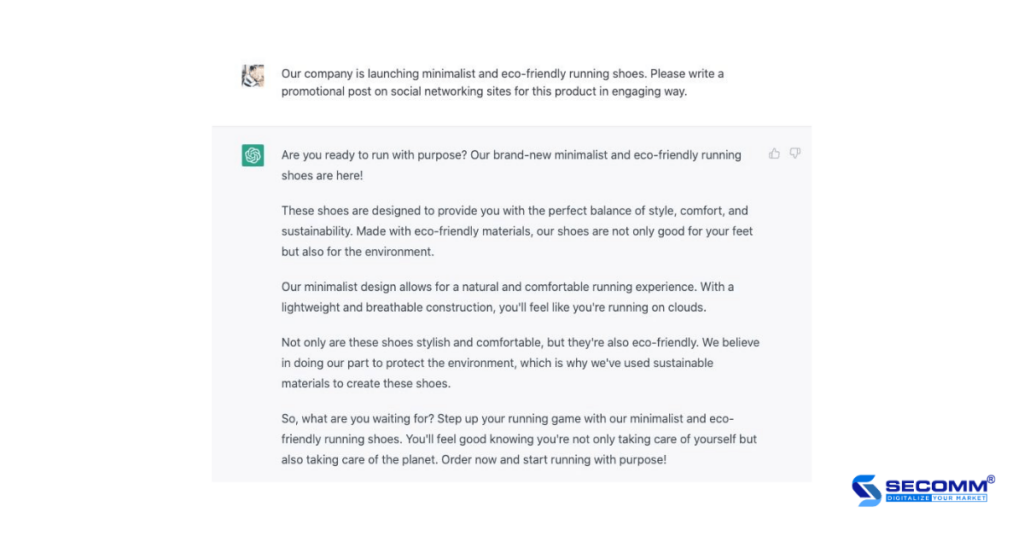
Running email marketing campaigns enables eCommerce businesses to build relationships with their customers, advertise their products and boost sales. By sending personalized ideal emails to customers and prospective customers, businesses can earn customer loyalty and encourage repeat purchases.
ChatGPT can be used in your email marketing campaigns targeting specific customer segments to achieve the desired results.
Example: Jennifer is a regular customer of a sports fashion company. Now the company launches eco-friendly sneakers with a minimalist design. The company uses ChatGPT to compose content for email marketing campaigns to introduce Jennifer to new products and ideal incentives for loyal customers.
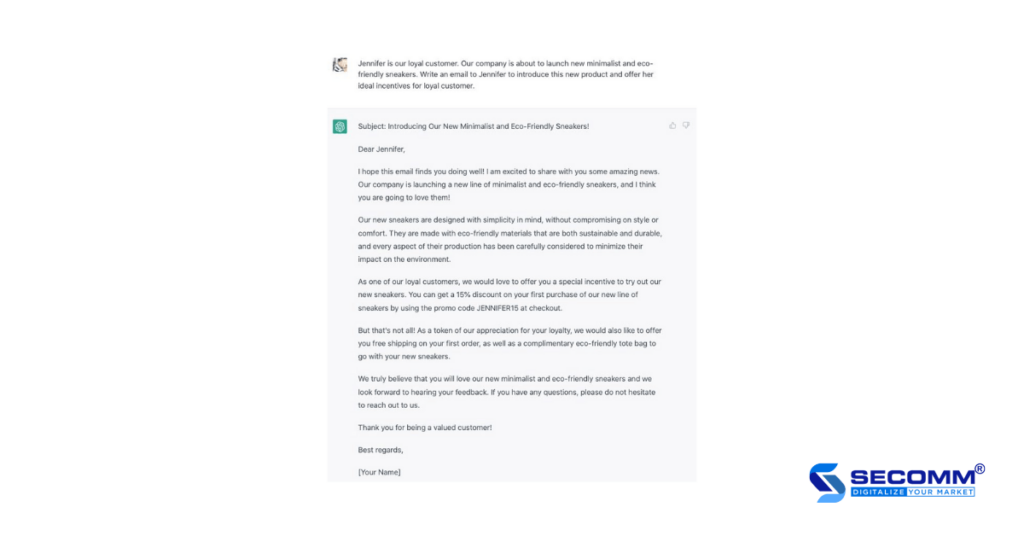
eCommerce business owners can use ChatGPT to handle customer requests in a personalized way. It could be responding to inquiries about order status, product availability, shipping fee, or return concerns. By providing ChatGPT demographic information such as age, gender, and interest, it will immediately generate text for a specific customer in a specific case. That helps increase customer engagement and conversion rate. Businesses will free up time and workload for the team to focus on more important tasks.
For example, if a customer named Jennifer asks for a return process, ChatGPT can generate a response with detailed information including requirements and time for return.
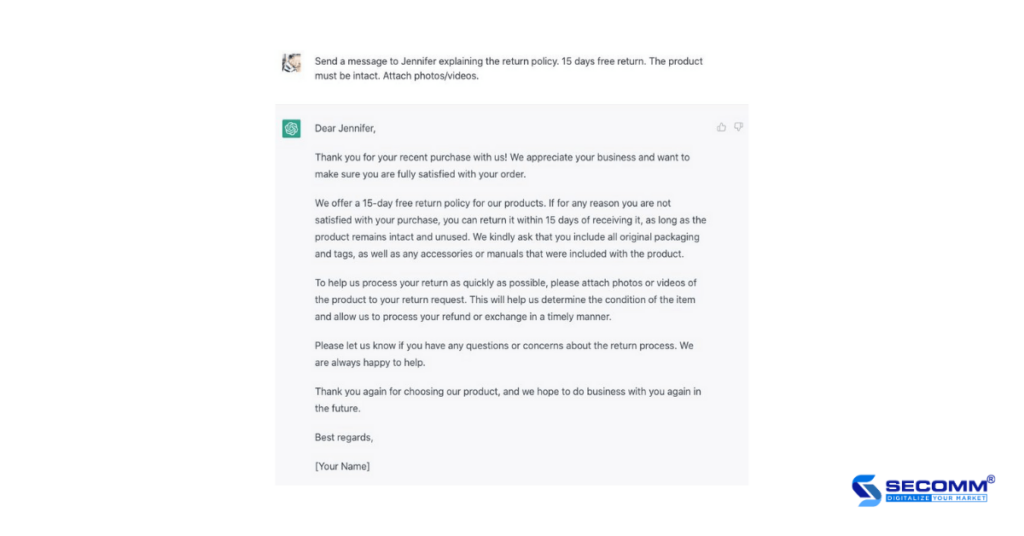
Like every AI-powered tool, ChatGPT has its downsides when used in eCommerce.
Firstly, although ChatGPT helps generate content for marketing campaigns quickly and automatically, it still can’t compete with the original writing by humans. If people depend too much on ChatGPT, their writing will become robotic and clunky which might affect their marketing campaigns the most.
In addition, as mentioned above, ChatGPT is trained by reinforced learning. This leaves room for issues since the information ChatGPT “learned” might not be accurate, hence generating wrong answers for users.
Last but not least, businesses should use ChatGPT with caution. They might want to clarify the information given by ChatGPT carefully before using or publishing their content, which could harm the businesses’ reputation when incorrect or misleading information is used.
Every business owner today can use the five most effective ways to use ChatGPT in eCommerce to stand out from the crowd. Yet, it’s not easy to use it properly and make it an important factor of eCommerce business without being dependent.
Talk to SECOMM now to get started.
 2
2
 1,933
1,933
 1
1
 1
1Subscribe to get the latest eBook!
Hotline